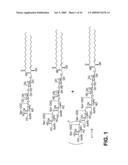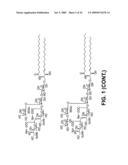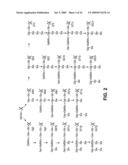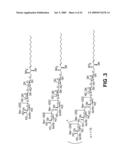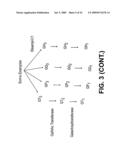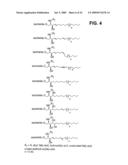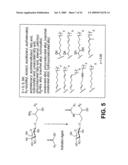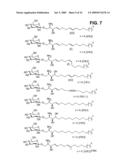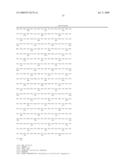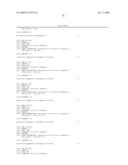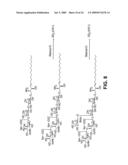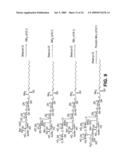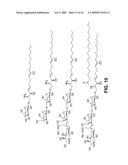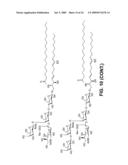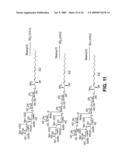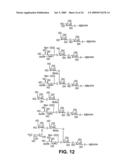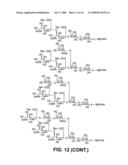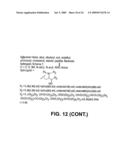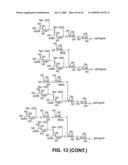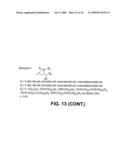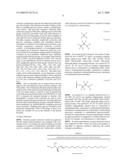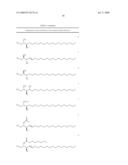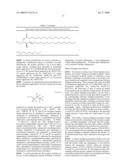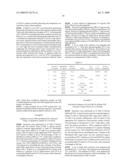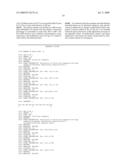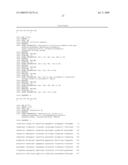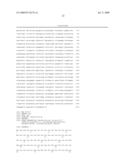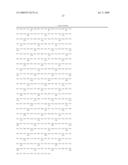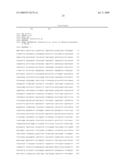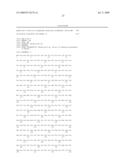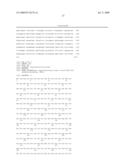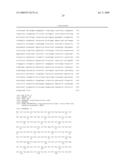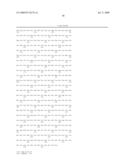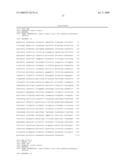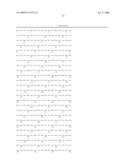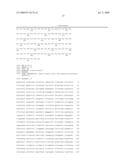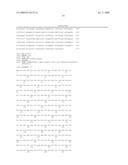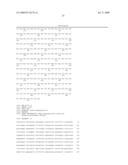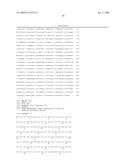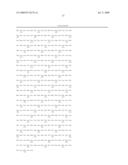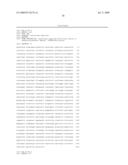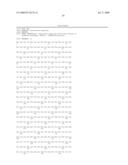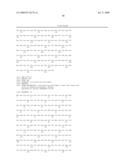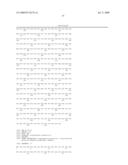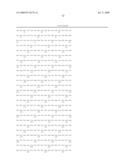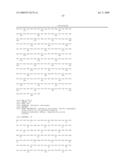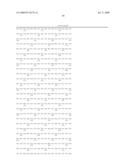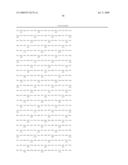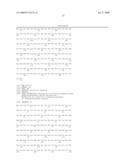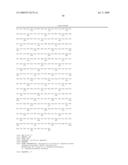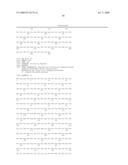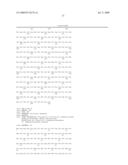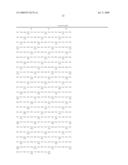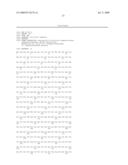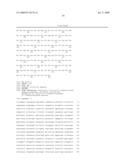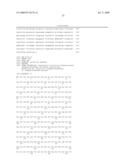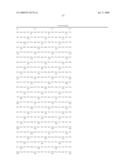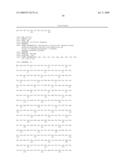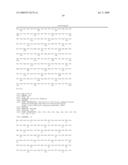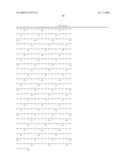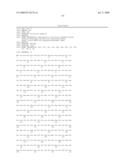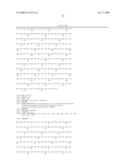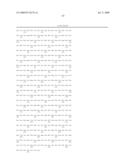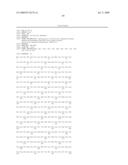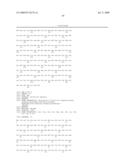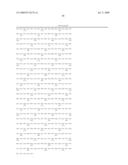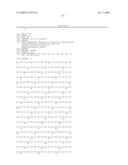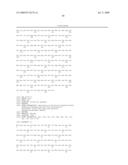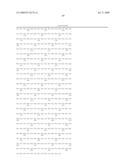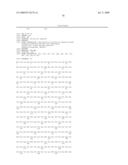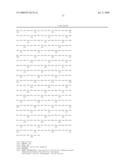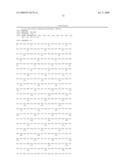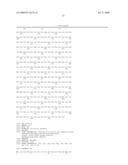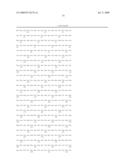Patent application title: SOLVENTS FOR MUTANT ENDOGLYCOCERAMIDASES WITH SYNTHETIC ACTIVITY
Inventors:
Shawn Defrees (North Wales, PA, US)
Xiaoping Tang (North Wales, PA, US)
Assignees:
Neose Technologies, Inc.
IPC8 Class: AC12P1900FI
USPC Class:
435 72
Class name: Chemistry: molecular biology and microbiology micro-organism, tissue cell culture or enzyme using process to synthesize a desired chemical compound or composition preparing compound containing saccharide radical
Publication date: 2009-07-09
Patent application number: 20090176278
Claims:
1. A reaction mixture comprising:a) a solvent comprising at least one of a
polyhydric alcohol or an alkoxy ether; andb) a mutant endoglycoceramidase
having a modified nucleophilic carboxylate amino acid residue, wherein
the nucleophilic carboxylate residue resides within a
(Ile/Met/Leu/Phe/Val)-(Leu/Met/Ile/Val)-(Gly/Ser/Thr)-(Glu/Asp)-(Phe/Thr/-
Met/Leu)-(Gly/Leu/Phe) sequence (motif E or SEQ ID NO:5).
2. The reaction mixture of claim 1, further comprising a donor substrate comprising a saccharide moiety and an acceptor substrate.
3. The reaction mixture of claim 1, wherein the alkoxy ether is a lower alkoxy ether.
4. The reaction mixture of claim 1, wherein the alkoxy ether is a diether.
5. The reaction mixture of claim 1, wherein the alkoxy ether is a glyme.
6. The reaction mixture of claim 1, wherein the alkoxy ether is 1,2-dimethoxyethane.
7. The reaction mixture of claim 1, wherein the polyhydric alcohol is glycerol.
8. The reaction mixture of claim 1, wherein the wherein the nucleophilic carboxylate amino acid residue is a Glu residing within a (Ile/Met/Leu/Phe/Val)-(Leu/Met/Ile/Val)-(Gly/Ser/Thr)-Glu-(Phe/Thr/Met/Le- u)-(Gly/Leu/Phe) sequence (motif D or SEQ ID NO:4).
9. The reaction mixture of claim 1, wherein the corresponding wild-type endoglycoceramidase is selected from the group consisting of a Rhodococcus endoglycoceramidase, a Propionibacterium endoglycoceramidase, a Dictyostelium endoglycoceramidase, a Cyanea endoglycoceramidase, a Hydra endoglycoceramidase, a Streptomyces endoglycoceramidase, a Schistosoma endoglycoceramidase, a Leptospira endoglycoceramidase, and a Neurospora endoglycoceramidase.
10. The reaction mixture of claim 8, wherein the nucleophilic Glu residue is substituted with an amino acid selected from the group consisting of Gly, Ala, Ser, Asp, Asn, Gln, Cys, Thr, Ile, Leu and Val.
11. The reaction mixture of claim 2, wherein the donor substrate is an α-modified glycosyl donor of anomeric configuration opposite the natural glycosidic linkage.
12. The reaction mixture of claim 11, wherein the donor substrate is a glycosyl fluoride.
13. The reaction mixture of claim 2, wherein the acceptor substrate is an aglycone of Formulas Ia, Ib, II or III.
14. The reaction mixture of claim 13, wherein the acceptor substrate is a sphingosine or a sphingosine analog.
15. The reaction mixture of claim 14, wherein the sphingosine is selected from the group consisting of from D-erythro-sphingosine, D-erythro-sphinganine, L-threo-sphingosine, L-threo-dihydrosphingosine, D-erythro-phytosphingosine, N-ocatanoyl-D-erythro-sphingosine.
16. The reaction mixture of claim 13, wherein the acceptor substrate is a ceramide.
17. The reaction mixture of claim 1, wherein the reaction mixture is large-scale.
18. A method of synthesizing a glycolipid, the method comprising, contacting in a reaction mixture comprising at least one of an alkoxy ether and a polyhydric alcohol, a donor substrate comprising a saccharide moiety and an acceptor substrate with a mutant endoglycoceramidase having a modified nucleophilic carboxylate amino acid residue, wherein the nucleophilic carboxylate residue resides within a (Ile/Met/Leu/Phe/Val)-(Leu/Met/Ile/Val)-(Gly/Ser/Thr)-(Glu/Asp)-(Phe/Thr/- Met/Leu)-(Gly/Leu/Phe) sequence (motif E or SEQ ID NO:5) of a corresponding wild-type endoglycoceramidase, under conditions wherein the endoglycoceramidase catalyzes the transfer of a saccharide moiety from a donor substrate to an acceptor substrate, thereby producing the glycolipid.
19. The method of claim 18, wherein the alkoxy ether is a lower alkoxy ether.
20. The method of claim 18, wherein the alkoxy ether is a diether.
21. The method of claim 18, wherein the alkoxy ether is a glyme.
22. The method of claim 18, wherein the alkoxy ether is 1,2-dimethoxyethane.
23. The method of claim 18, wherein the polyhydric alcohol is glycerol.
24. The method of claim 18, wherein the wherein the nucleophilic carboxylate amino acid residue is a Glu residing within a (Ile/Met/Leu/Phe/Val)-(Leu/Met/Ile/Val)-(Gly/Ser/Thr)-Glu-(Phe/Thr/Met/Le- u)-(Gly/Leu/Phe) sequence (motif D or SEQ ID NO:4).
25. The method of claim 18, wherein the corresponding wild-type endoglycoceramidase is selected from the group consisting of a Rhodococcus endoglycoceramidase, a Propionibacterium endoglycoceramidase, a Dictyostelium endoglycoceramidase, a Cyanea endoglycoceramidase, a Hydra endoglycoceramidase, a Streptomyces endoglycoceramidase, a Schistosoma endoglycoceramidase, a Leptospira endoglycoceramidase, and a Neurospora endoglycoceramidase.
26. The method of claim 24, wherein the nucleophilic Glu residue is substituted with an amino acid selected from the group consisting of Gly, Ala, Ser, Asp, Asn, Gln, Cys, Thr, Ile, Leu and Val.
27. The method of claim 18, wherein the donor substrate is an α-modified glycosyl donor of anomeric configuration opposite the natural glycosidic linkage.
28. The method of claim 27, wherein the donor substrate is a glycosyl fluoride.
29. The method of claim 18, wherein the acceptor substrate is an aglycone of Formulas Ia, Ib, II or III.
30. The method of claim 29, wherein the acceptor substrate is a sphingosine or a sphingosine analog.
31. The method of claim 30, wherein the sphingosine is selected from the group consisting of from D-erythro-sphingosine, D-erythro-sphinganine, L-threo-sphingosine, L-threo-dihydrosphingosine, D-erythro-phytosphingosine, N-octanoyl-D-erythro-sphingosine.
32. The method of claim 29, wherein the acceptor substrate is a ceramide.
33. A large-scale reaction mixture comprising:a) a solvent comprising at least one of a polyhydric alcohol or an alkoxy ether; andb) a mutant endoglycoceramidase having a modified nucleophilic carboxylate amino acid residue, wherein the nucleophilic carboxylate residue resides within a (Ile/Met/Leu/Phe/Val)-(Leu/Met/Ile/Val)-(Gly/Ser/Thr)-(Glu/Asp)-(Phe/Thr/- Met/Leu)-(Gly/Leu/Phe) sequence (motif E or SEQ ID NO:5);c) at least 100 mg of a donor substrate comprising a saccharide moiety; andd) at least 100 mg of an acceptor substrate.
34. The reaction mixture of claim 33, wherein the alkoxy ether is a lower alkoxy ether.
35. The reaction mixture of claim 33, wherein the alkoxy ether is a diether.
36. The reaction mixture of claim 33, wherein the alkoxy ether is a glyme.
37. The reaction mixture of claim 33, wherein the alkoxy ether is 1,2-dimethoxyethane.
38. The reaction mixture of claim 33, wherein the polyhydric alcohol is glycerol.
39. The reaction mixture of claim 33, wherein the wherein the nucleophilic carboxylate amino acid residue is a Glu residing within a (Ile/Met/Leu/Phe/Val)-(Leu/Met/Ile/Val)-(Gly/Ser/Thr)-Glu-(Phe/Thr/Met/Le- u)-(Gly/Leu/Phe) sequence (motif D or SEQ ID NO:4).
40. The reaction mixture of claim 33, wherein the corresponding wild-type endoglycoceramidase is selected from the group consisting of a Rhodococcus endoglycoceramidase, a Propionibacterium endoglycoceramidase, a Dictyostelium endoglycoceramidase, a Cyanea endoglycoceramidase, a Hydra endoglycoceramidase, a Streptomyces endoglycoceramidase, a Schistosoma endoglycoceramidase, a Leptospira endoglycoceramidase, and a Neurospora endoglycoceramidase.
41. The reaction mixture of claim 39, wherein the nucleophilic Glu residue is substituted with an amino acid selected from the group consisting of Gly, Ala, Ser, Asp, Asn, Gln, Cys, Thr, Ile, Leu and Val.
42. The reaction mixture of claim 34, wherein the donor substrate is an α-modified glycosyl donor of anomeric configuration opposite the natural glycosidic linkage.
43. The reaction mixture of claim 42, wherein the donor substrate is a glycosyl fluoride.
44. The reaction mixture of claim 34, wherein the acceptor substrate is an aglycone of Formulas Ia, Ib, II or III.
45. The reaction mixture of claim 44, wherein the acceptor substrate is a sphingosine or a sphingosine analog.
46. The reaction mixture of claim 45, wherein the sphingosine is selected from the group consisting of from D-erythro-sphingosine, D-erythro-sphinganine, L-threo-sphingosine, L-threo-dihydrosphingosine, D-erythro-phytosphingosine, N-ocatanoyl-D-erythro-sphingosine.
47. The reaction mixture of claim 44, wherein the acceptor substrate is a ceramide.
48. A large-scale method of synthesizing a glycolipid, the method comprising, contacting in a large-scale reaction mixture comprising at least one of an alkoxy ether and a polyhydric alcohol, a donor substrate comprising a saccharide moiety and an acceptor substrate with a mutant endoglycoceramidase having a modified nucleophilic carboxylate amino acid residue, wherein the nucleophilic carboxylate residue resides within a (Ile/Met/Leu/Phe/Val)-(Leu/Met/Ile/Val)-(Gly/Ser/Thr)-(Glu/Asp)-(Phe/Thr/- Met/Leu)-(Gly/Leu/Phe) sequence (motif E or SEQ ID NO:5) of a corresponding wild-type endoglycoceramidase, under conditions wherein the endoglycoceramidase catalyzes the transfer of a saccharide moiety from a donor substrate to an acceptor substrate, thereby producing at least 100 mg of the glycolipid.
49. The method of claim 48, wherein the alkoxy ether is a lower alkoxy ether.
50. The method of claim 48, wherein the alkoxy ether is a diether.
51. The method of claim 48, wherein the alkoxy ether is a glyme.
52. The method of claim 48, wherein the alkoxy ether is 1,2-dimethoxyethane.
53. The method of claim 48, wherein the polyhydric alcohol is glycerol.
54. The method of claim 48, wherein the wherein the nucleophilic carboxylate amino acid residue is a Glu residing within a (Ile/Met/Leu/Phe/Val)-(Leu/Met/Ile/Val)-(Gly/Ser/Thr)-Glu-(Phe/Thr/Met/Le- u)-(Gly/Leu/Phe) sequence (motif D or SEQ ID NO:4).
55. The method of claim 48, wherein the corresponding wild-type endoglycoceramidase is selected from the group consisting of a Rhodococcus endoglycoceramidase, a Propionibacterium endoglycoceramidase, a Dictyostelium endoglycoceramidase, a Cyanea endoglycoceramidase, a Hydra endoglycoceramidase, a Streptomyces endoglycoceramidase, a Schistosoma endoglycoceramidase, a Leptospira endoglycoceramidase, and a Neurospora endoglycoceramidase.
56. The method of claim 54, wherein the nucleophilic Glu residue is substituted with an amino acid selected from the group consisting of Gly, Ala, Ser, Asp, Asn, Gln, Cys, Thr, Ile, Leu and Val.
57. The method of claim 48, wherein the donor substrate is an α-modified glycosyl donor of anomeric configuration opposite the natural glycosidic linkage.
58. The method of claim 57, wherein the donor substrate is a glycosyl fluoride.
59. The method of claim 48, wherein the acceptor substrate is an aglycone of Formulas Ia, Ib, II or III.
60. The method of claim 59, wherein the acceptor substrate is a sphingosine or a sphingosine analog.
61. The method of claim 60, wherein the sphingosine is selected from the group consisting of from D-erythro-sphingosine, D-erythro-sphinganine, L-threo-sphingosine, L-threo-dihydrosphingosine, D-erythro-phytosphingosine, N-octanoyl-D-erythro-sphingosine.
62. The method of claim 59, wherein the acceptor substrate is a ceramide.
Description:
CROSS-REFERENCE TO RELATED APPLICATIONS
[0001]This application claims the benefit of U.S. Provisional Application No. 60/742,055, filed on Dec. 1, 2005, the entire contents of which is hereby incorporated herein by reference for all purposes.
FIELD OF THE INVENTION
[0002]The present invention relates to the field of synthesis of saccharides, particularly those of use in preparing glycolipids, e.g., glycosphingolipids. More specifically, the invention provides reaction mixtures comprising a solvent having at least one of an alkoxy ether and/or a polyhydric alcohol for use with a mutant endoglycoceramidase, which has a synthetic activity that can be used to catalyze the formation of the glycosidic linkage between a monosaccharide or oligosaccharide and an aglycone to form various glycolipids.
BACKGROUND OF THE INVENTION
[0003]Glycolipids, a group of amphipathic compounds that structurally consist of a sugar chain (monosaccharide or oligosaccharide) bound to an aglycone, are important cellular membrane components known to participate in various cellular events mediating physiological processes such as the cell-cell recognition, antigenicity, and cell growth regulation (Hakomori, Annu. Rev. Biochem., 50: 733-764, 1981; Makita and Taniguchi, Glycolipid (Wiegandt, ed.) pp 59-82, Elsevier Scientific Publishing Co., New York, 1985). Because there are no known enzymes that can universally transfer a saccharyl residue to a an aglycone (e.g., ceramide or sphingosine), synthesis of glycolipids usually requires a multi-step complex process that has the disadvantages of high cost and low yield.
[0004]Endoglycoceramidase (EC3.2.1.123), an enzyme first isolated from the Actinomycetes of Rhodococcus strain (Horibata, J. Biol. Chem. May 2004 10.1094/jbc.M401-460200; Ito and Yamagata, J. Biol. Chem., 261: 14278-14282, 1986), hydrolyzes the glycoside linkage between the sugar chain and the ceramide in glycolipids to produce intact monosaccharide or oligosaccharide and ceramide. To this date, several more endoglycoceramidases have been isolated and characterized (see e.g., Li et al., Biochem. Biophy. Res. Comm., 149: 167-172, 1987; Ito and Yamagata, J. Biol. Chem., 264: 9510-9519, 1989; Zhou et al., J. Biol. Chem., 264: 12272-12277, 1989; Ashida et al., Eur. J. Biochem., 205: 729-735, 1992; Izu et al., J. Biol. Chem., 272: 19846-19850, 1997; Horibata et al., J. Biol. Chem., 275:31297-31304, 2000; Sakaguchi et al., J. Biochem., 128: 145-152, 2000; and U.S. Pat. No. 5,795,765). The active site of endoglycoceramidases has also been described by Sakaguchi et al., Biochem. Biophy. Res. Comm., 260: 89-93, 1999, as including a three amino acid segment of Asn-Glu-Pro, among which the Glu residue appears to be the most important to the enzymatic activity.
[0005]Endoglycoceramidases are also known to possess an additional transglycosylation activity, which is much weaker than the hydrolytic activity (Li et al., J. Biol. Chem., 266:10723-10726, 1991; Ashida et al., Arch. Biochem. Biophy., 305:559-562, 1993; Horibata et al., J. Biochem., 130:263-268, 2001). This transglycosylation activity has been exploited to synthesize glycolipids (see, PCT/US05/19451) The present invention provides improved reaction mixtures for efficient use of such a synthetic mutant endoglycoceramidase ("endoglycoceramide synthase").
BRIEF SUMMARY OF THE INVENTION
[0006]The present invention provides reaction mixtures comprising: a) a solvent comprising at least one of a polyhydric alcohol or an alkoxy ether; and b) a mutant endoglycoceramidase having a modified nucleophilic carboxylate amino acid residue, wherein the nucleophilic carboxylate residue resides within a (Ile/Met/Leu/Phe/Val)-(Leu/Met/Ile/Val)-(Gly/Ser/Thr)-(Glu/Asp)-(Phe/Thr/- Met/Leu)-(Gly/Leu/Phe) sequence (motif E or SEQ ID NO:5). In some embodiments, the alkoxy ether is the lower alkoxy diether 1,2-dimethoxymethane.
[0007]In some embodiments, the alkoxy ether is a lower alkoxy ether. In some embodiments, the alkoxy ether is a diether. In some embodiments, the alkoxy ether is a glyme. In some embodiments, the alkoxy ether is 1,2 dimethoxyethane. In some embodiments, the polyhydric alcohol is glycerol.
[0008]In some embodiments, the alkoxy ether is one or more selected from the group consisting of dimethoxymethane, 1,2-dimethoxyethane, 1,1 dimethoxyethane, ethylene glycol diethyl ether, 1,1-diethoxyethane, propylene glycol diethyl ether, di(propylene glycol) dimethyl ether, ethylene glycol dipropyl ether, diethylene glycol butyl ether, diethylene glycol dibutyl ether, diethylene glycol monoethyl ether, diethylene glycol diethyl ether, diethylene glycol methyl ether, diethylene glycol dimethyl ether, diethylene glycol monopropyl ether, ethylene glycol butyl ether, 1,2-dimethoxyethene, 1,1-dimethoxyethene, diethyl ether and tert-butyl methyl ether.
[0009]In some embodiments, the polyhydric alcohol is one or more selected from the group consisting of glycerol, diglycerol, ethylene glycol, diethylene glycol, triethylene glycol, propylene glycol, dipropylene glycol, trimethylolpropane, pentaerythritol, and 1,3-butanediol, sorbitol, mannitol, xylitol, erythritol, maltitol, lactitol, polyethylene glycol, polypropylene glycol, hexanediol, pentanediol, hexanetriol, and thiodiglycol.
[0010]The reaction mixtures usually will also contain a donor substrate a saccharide moiety and an acceptor substrate. In some embodiments, the donor substrate is an α modified glycosyl donor of anomeric configuration opposite the natural glycosidic linkage. In some embodiments, the donor substrate is a glycosyl fluoride.
[0011]In some embodiments, the acceptor substrate is an aglycone of Formulas Ia, Ib, II or III. In some embodiments, the acceptor substrate is a sphingosine or a sphingosine analog. In some embodiments, the sphingosine is selected from the group consisting of from D-erytbro-sphingosine, D-erythro-sphinganine, L-threo-sphingosine, L-threo-dihydrosphingosine, D-erythro-phytosphingosine, N-ocatanoyl-D-erythro-sphingosine. In some embodiments, the acceptor substrate is a ceramide.
[0012]In a another aspect, the invention provides methods of synthesizing a glycolipid, the method comprising, contacting in a reaction mixture comprising at least one of an alkoxy ether and a polyhydric alcohol, a donor substrate a saccharide moiety and an acceptor substrate, with a mutant endoglycoceramidase having a modified nucleophilic carboxylate amino acid residue, wherein the nucleophilic carboxylate residue resides within a (Ile/Met/Leu/Phe/Val)-(Leu/Met/Ile/Val)-(Gly/Ser/Thr)-(Glu/Asp)-- (Phe/Thr/Met/Leu)-(Gly/Leu/Phe) sequence (motif E or SEQ ID NO:5) of a corresponding wild-type endoglycoceramidase, under conditions wherein the endoglycoceramidase catalyzes the transfer of a saccharide moiety from a donor substrate to an acceptor substrate, thereby producing the glycolipid.
[0013]The embodiments for the methods can be the same as set forth for the reaction mixtures. In some embodiments, the reaction mixtures are produced on a large scale. In some embodiments, the methods are carried out on a large scale.
[0014]Other objects, aspects and advantages of the invention will be apparent from the detailed description that follows.
DEFINITIONS
[0015]A "glycolipid" is a covalent conjugate between a glycosyl moiety and a substrate for a mutant endoglycoceramidase of the invention, such as an aglycone. An exemplary "glycolipid" is a covalent conjugate, between a glycosyl moiety and an aglycone, formed by a mutant endoglycoceramidase of the invention. The term "glycolipid" encompasses all glycosphingolipids, which are a group of amphipathic compounds that structurally consist of a sugar chain moiety (monosaccharide, oligosaccharide, or derivatives thereof) and an aglycone (i.e., a ceramide, a sphingosine, or a sphingosine analog). This term encompasses both cerebrosides and gangliosides. In certain embodiments, a glycolipid is an aglycone (non-carbohydrate alcohol (OH) or (SH)) conjugated to a non-reducing sugar and a non-glycoside.
[0016]An "aglycone," as referred to herein, is an acceptor substrate onto which a mutant endoglycoceramidase of the invention transfers glycosyl moiety from a glycosyl donor that is a substrate for said glycosyl donor. A glycosyl donor may be an activated or non-activated saccharide. An exemplary aglycone is a heteroalkyl moiety, which has the structure of, e.g., Formula Ia, Formula Ib or Formula II as shown below:
##STR00001##
[0017]In Formula Ia and Formula Ib, the symbol Z represents OH, SH, or NR4R4'. R1 and R2 are members independently selected from NHR4, SR4, OR4, OCOR4, OC(O)NHR4, NHC(O)OR4, OS(O)2OR4, C(O)R4, NHC(O)R4, detectable labels, and targeting moieties. The symbols R3, R4 and R4', R5, R6 and R7 each are members independently selected from H, substituted or unsubstituted alkyl, substituted or unsubstituted heteroalkyl, substituted or unsubstituted aryl, substituted or unsubstituted heteroaryl, substituted or unsubstituted heterocycloalkyl.
##STR00002##
[0018]In Formula II, Z1 is a member selected from O, S, and NR4; R1 and R2 are members independently selected from NHR4, SR4, OR4, OCOR4, OC(O)NHR4, NHC(O)OR4, OS(O)2OR4, C(O)R4, NHC(O)R4, detectable labels, and targeting moieties. The symbols R3, R4, R5, R6 and R7 each are members independently selected from H, substituted or unsubstituted alkyl, substituted or unsubstituted heteroalkyl, substituted or unsubstituted aryl, substituted or unsubstituted heteroaryl, substituted or unsubstituted heterocycloalkyl. Formula II is representative of certain embodiments wherein the aglycone portion is conjugated to a further substrate component, for example, a leaving group or a solid support.
[0019]The term "ceramide," as used herein, encompasses all ceramides and sphingosine as conventionally defined. See, for example, Berg, et al, Biochemistry, 2002, 5th ed., W.H. Freeman and Co.
[0020]The term "sphingosine analog" refers to lipid moieties that are chemically similar to sphingosine, but are modified at the polar head and/or the hydrophobic carbon chain. Sphingolipid analog moieties useful as acceptor substrates in the present methods include, but are not limited to, those described in co-pending patent applications PCT/US2004/006904 (which claims priority to U.S. Provisional Patent Application No. 60/452,796); U.S. patent application Ser. No. 10/487,841; U.S. patent application Ser. No. 10/485,892; 10/485,195, and PCT/US2005/040195 (which claims priority to U.S. Provisional Patent Application No. 60/626,678); the disclosures of each of which are hereby incorporated herein by reference in their entirety for all purposes.
[0021]In general, the sphingosine analogs described in the above-referenced applications are those compounds having the formula:
##STR00003##
wherein Z is a member selected from O, S, C(R2)2 and NR2; X is a member selected from H, --OR3, --NR3R4, --SR3, and --CHR3R4; R1, R2, R3 and R4 are members independently selected from H, substituted or unsubstituted alkyl, substituted or unsubstituted heteroalkyl, substituted or unsubstituted aryl, substituted or unsubstituted heteroaryl, substituted or unsubstituted heterocycloalkyl, --C(=M)R5, --C(=M)-Z1-R5, --SO2R5, and --SO3; wherein M and Z1 are members independently selected from O, NR6 or S; Y is a member selected from H, --OR7, --SR7, --NR7R8, substituted or unsubstituted alkyl, substituted or unsubstituted heteroalkyl, substituted or unsubstituted aryl, substituted or unsubstituted heteroaryl, and substituted or unsubstituted heterocycloalkyl, wherein R5, R6, R7 and R8 are members independently selected from H, substituted or unsubstituted alkyl, substituted or unsubstituted heteroalkyl, substituted or unsubstituted aryl, substituted or unsubstituted heteroaryl, substituted or unsubstituted heterocycloalkyl; and Ra, Rb, Rc and Rd are each independently H, substituted or unsubstituted alkyl, substituted or unsubstituted heteroalkyl, substituted or unsubstituted aryl, substituted or unsubstituted heteroaryl, substituted or unsubstituted heterocycloalkyl.
[0022]An "acceptor substrate" for a wild-type endoglycoceramidase or a mutant endoglycoceramidase, is any aglycone moiety that can act as an acceptor for a particular endoglycoceramidase. When the acceptor substrate is contacted with the corresponding endoglycoceramidase and sugar donor substrate, and other necessary reaction mixture components, and the reaction mixture is incubated for a sufficient period of time, the endoglycoceramidase transfers sugar residues from the sugar donor substrate to the acceptor substrate. The acceptor substrate can vary for different types of a particular endoglycoceramidase. Accordingly, the term "acceptor substrate" is taken in context with the particular endoglycoceramidase or mutant endoglycoceramidase of interest for a particular application. Acceptor substrates for endoglycoceramidases and mutant endoglycoceramidases are described herein.
[0023]A "donor substrate" for wild-type and mutant endoglycoceramidases includes any activated glycosyl derivatives of anomeric configuration opposite the natural glycosidic linkage. The enzymes of the invention are used to couple α-modified or β-modified glycosyl donors, usually α-modified glycosyl donors, with glycoside acceptors. Preferred donor molecules are glycosyl fluorides, although donors with other groups which are reasonably small and which function as relatively good leaving groups can also be used. Examples of other glycosyl donor molecules include glycosyl halides (e.g., chlorides, bromides, iodides, fluorides), acetates, mesylates, propionates, pivaloates, and glycosyl molecules modified with substituted phenols. Among the α-modified or β-modified glycosyl donors, α-galactosyl, α-mannosyl, α-glucosyl, α-fucosyl, α-xylosyl, α-sialyl, α-N-acetylglucosaminyl, α-N-acetylgalactosaminyl, β-galactosyl, β-mannosyl, β-glucosyl, β-fucosyl, β-xylosyl, β-sialyl, β-N-acetylglucosaminyl and β-N-acetylgalactosaminyl are most preferred. The donor molecules can be monosaccharides, or may themselves contain multiple sugar moieties (oligosaccharides). Donor substrates of use in the particular methods include those described in U.S. Pat. Nos. 6,284,494; 6,204,029; 5,952,203; and 5,716,812, the disclosures of which are hereby incorporated herein by reference in their entirety for all purposes.
[0024]The term "contacting" is used herein interchangeably with the following: combined with, added to, mixed with, passed over, incubated with, flowed over, etc.
[0025]"Endoglycoceramidase," as used herein, refers to an enzyme that in its native or wild-type version has a primary activity of cleaving the glycosidic linkage between a monosaccharide or an oligosaccharide and a ceramide (or sphingosine) of an acidic or neutral glycolipid, producing intact monosaccharide or oligosaccharide and ceramide (Registry number: EC 3.2.1.123). The wild-type version of this enzyme may also have a secondary activity of catalyzing the formation of the glycosidic linkage between a monosaccharide or oligosaccharide and an aglycone (i.e., a ceramide or a sphingosine) to form various glycolipids. Wild-type endoglycoceramidases have at least two identifiable conserved motifs, including an acid-base region (Val-X1-(Ala/Gly)-(Tyr/Phe)-(Asp/Glu)-(Leu/Ile)-X2-Asn-Glu-Pro-- X3-X4-Gly or motif B or SEQ ID NO:2), and a nucleophilic region ((Ile/Met/Leu/Phe/Val)-(Leu/Met/Ile/Val)-(Gly/Ser/Thr)-Glu-(Phe/Thr/Met/L- eu)-(Gly/Leu/Phe or motif D or SEQ ID NO:4).
[0026]The terms "mutated" or "modified" as used in the context of altering the structure or enzymatic activity of a wild-type endoglycoceramidase, refers to the deletion, insertion, or substitution of any nucleotide or amino acid residue, by chemical, enzymatic, or any other means, in a polynucleotide sequence encoding an endoglycoceramidase or the amino acid sequence of a wild-type endoglycoceramidase, respectively, such that the amino acid sequence of the resulting endoglycoceramidase is altered at one or more amino acid residues. The site for such an activity-altering mutation may be located anywhere in the enzyme, including within the active site of the endoglycoceramidase, particularly involving the glutamic acid residue of the Asn-Glu-Pro subsequence of the acid-base sequence region. An artisan of ordinary skill will readily locate this Glu residue, for example, at position 233 in SEQ ID NO:7 and at position 224 in SEQ ID NO:9. Other examples of Glu residues that, once mutated, can alter the enzymatic activity of an endoglycoceramidase include a carboxylate (i.e., Glu or Asp) nucleophilic Glu/Asp residue (bolded) in the (Ile/Met/Leu/Phe/Val)-(Leu/Met/Ile/Val)-(Gly/Ser/Thr)-Glu/Asp-(Phe/Th- r/Met/Leu)-(Gly/Leu/Phe) motif of a corresponding wild-type endoglycoceramidase.
[0027]A "mutant endoglycoceramidase" or "modified endoglycoceramidase" used in the methods of this invention thus comprises at least one mutated or modified amino acid residue, as described in International Application No. PCT/US05/19451 and U.S. Provisional Application Nos. 60/666,765; 60/626,791, 60/576,316, the disclosures of each of which are hereby incorporated herein by reference in their entirety for all purposes. The wild-type endoglycoceramidase whose coding sequence is modified to generate a mutant endoglycoceramidase is referred to in this application as "the corresponding native or wild-type endoglycoceramidase." One exemplary mutant endoglycoceramidase of the invention includes the deletion or substitution of a nucleophilic carboxylate Glu/Asp residue (bolded) in the (Ile/Met/Leu/Phe/Val)-(Leu/Met/Ile/Val)-(Gly/Ser/Thr)-Glu/Asp-(Phe/Thr/Me- t/Leu)-(Gly/Leu/Phe) motif of a corresponding wild-type endoglycoceramidase. One exemplary mutant endoglycoceramidase of the invention includes a mutation within the active site, e.g., the deletion or substitution of the Glu residue within the Asn-Glu-Pro subsequence of the acid-base sequence region. The mutant endoglycoceramidase exhibits an altered enzymatic activity, e.g., an enhanced glycolipid synthetic activity, in comparison with its wild-type counterpart. A mutant endoglycoceramidase that has demonstrated an increased glycolipid synthetic activity is also called an "endoglycoceramide synthase."
[0028]The term "acid-base sequence region" refers to a conserved Val-X1-(Ala/Gly)-(Tyr/Phe)-(Asp/Glu)-(Leu/Ile)-X2-Asn-Glu-Pro-X- 3-X4-Gly sequence (SEQ ID NO:2) in a corresponding wild-type endoglycoceramidase which includes a conserved Asn-Glu-Pro subsequence. The acid-base glutamic acid residue is located within the conserved Asn-Glu-Pro subsequence, for example, at position 233 in Rhodococcus sp. M-777; position 224 in Rhodococcus sp. C9; position 229 in Propionibacterium acnes EGCa; position 248 in Propionibacterium acnes EGCb; position 238 in Cyanea nozakii; at position 229 in Hydra magnipapillata; at postion 234 in Dictyostelium; at position 214 in Schistosoma; at position 241 in Leptospira interrogans; at position 272 of Streptomyces; and at position 247 of Neurosporassa (see, FIG. 14). The conserved sequence encoding a three-amino acid segment Asn-Glu-Pro was previously identified within the active site of endoglycoceramidases, and the Glu residue within the segment was thought to be connected to the hydrolytic activity of the endoglycoceramidase (Sakaguchi et al., Biochem. Biophys. Res. Commun., 1999, 260: 89-93).
[0029]The term "nucleophilic residue" or "nucleophilic motif" refers to the carboxylate amino acid residue within the (Ile/Met/Leu/Phe/Val)-(Leu/Met/Ile/Val)-(Gly/Ser/Thr)-(Asp/Glu)-(Phe/Thr/- Met/Leu)-(Gly/Leu/Phe) motif (SEQ ID NO:5) of a corresponding wild-type endoglycoceramidase. The nucleophilic residue can be a glutamate or an aspartate, usually a glutamate. A nucleophilic glutamic acid residue is located, for example, at position 351 in Rhodococcus sp. M-777; position 343 in Rhodococcus sp. C9; position 342 in Propionibacterium acnes EGCa; position 360 in Propionibacterium acnes EGCb; position 361 in Cyanea nozakii; and at position 349 in Hydra magnipapillata; at position 354 in Dictyostelium; at position 351 in Schistosoma; at position 461 in Leptospira interroganss; at position 391 of Streptomyces; and at position 498 of Neurosporassa (see, FIG. 14).
[0030]Amino acids may be referred to herein by either the commonly known three letter symbols or by the one-letter symbols recommended by the IUPAC-IUB Biochemical Nomenclature Commission. Nucleotides, likewise, may be referred to by their commonly accepted single-letter codes.
[0031]"Conservatively modified variants" applies to both amino acid and nucleic acid sequences. With respect to particular nucleic acid sequences, "conservatively modified variants" refers to those nucleic acids that encode identical or essentially identical amino acid sequences, or where the nucleic acid does not encode an amino acid sequence, to essentially identical sequences. Because of the degeneracy of the genetic code, a large number of functionally identical nucleic acids encode any given protein. For instance, the codons GCA, GCC, GCG and GCU all encode the amino acid alanine. Thus, at every position where an alanine is specified by a codon, the codon can be altered to any of the corresponding codons described without altering the encoded polypeptide. Such nucleic acid variations are "silent variations," which are one species of conservatively modified variations. Every nucleic acid sequence herein that encodes a polypeptide also describes every possible silent variation of the nucleic acid. One of skill will recognize that each codon in a nucleic acid (except AUG, which is ordinarily the only codon for methionine, and TGG, which is ordinarily the only codon for tryptophan) can be modified to yield a functionally identical molecule. Accordingly, each silent variation of a nucleic acid that encodes a polypeptide is implicit in each described sequence.
[0032]As to amino acid sequences, one of skill will recognize that individual substitutions, deletions or additions to a nucleic acid, peptide, polypeptide, or protein sequence which alters, adds or deletes a single amino acid or a small percentage of amino acids in the encoded sequence is a "conservatively modified variant" where the alteration results in the substitution of an amino acid with a chemically similar amino acid (i.e., hydrophobic, hydrophilic, positively charged, neutral, negatively charged). Exemplified hydrophobic amino acids include valine, leucine, isoleucine, methionine, phenylalanine, and tryptophan. Exemplified aromatic amino acids include phenylalanine, tyrosine and tryptophan. Exemplified aliphatic amino acids include serine and threonine. Exemplified basic aminoacids include lysine, arginine and histidine. Exemplified amino acids with carboxylate side-chains include aspartate and glutamate. Exemplified amino acids with carboxamide side chains include asparagines and glutamine. Conservative substitution tables providing functionally similar amino acids are well known in the art. Such conservatively modified variants are in addition to and do not exclude polymorphic variants, interspecies homologs, and alleles of the invention.
[0033]The following eight groups each contain amino acids that are conservative substitutions for one another:
1) Alanine (A), Glycine (G);
[0034]2) Aspartic acid (D), Glutamic acid (E);
3) Asparagine (N), Glutamine (Q);
4) Arginine (R), Lysine (K);
5) Isoleucine (I), Leucine (L), Methionine (M), Valine (V);
6) Phenylalanine (F), Tyrosine (Y), Tryptophan (W);
7) Serine (S), Threonine (T); and
8) Cysteine (C), Methionine (M)
[0035](see, e.g., Creighton, Proteins (1984)).
[0036]The term "alkyl," by itself or as part of another substituent, means, unless otherwise stated, a straight or branched chain, or cyclic hydrocarbon radical, or combination thereof, which may be fully saturated, mono- or polyunsaturated and can include mono-, di- and multivalent radicals, having the number of carbon atoms designated (i.e. C1-C10 means one to ten carbons). Examples of saturated alkyl radicals include, but are not limited to, groups such as methyl, methylene, ethyl, ethylene, n-propyl, isopropyl, n-butyl, t-butyl, isobutyl, sec-butyl, cyclohexyl, (cyclohexyl)methyl, cyclopropylmethyl, homologs and isomers of, for example, n-pentyl, n-hexyl, n-heptyl, n-octyl, and the like. An unsaturated alkyl group is one having one or more double bonds or triple bonds. Examples of unsaturated alkyl groups include, but are not limited to, vinyl, 2-propenyl, crotyl, 2-isopentenyl, 2-(butadienyl), 2,4-pentadienyl, 3-(1,4-pentadienyl), ethynyl, 1- and 3-propynyl, 3-butynyl, and the higher homologs and isomers. The term "alkyl," unless otherwise noted, includes "alkylene" and those derivatives of alkyl defined in more detail below, such as "heteroalkyl." Alkyl groups, which are limited to hydrocarbon groups, are termed "homoalkyl."
[0037]The term "heteroalkyl," by itself or in combination with another term, means, unless otherwise stated, a stable straight or branched chain, or cyclic hydrocarbon radical, or combinations thereof, consisting of the stated number of carbon atoms and at least one heteroatom selected from the group consisting of O, N, Si and S, and wherein the nitrogen and sulfur atoms may optionally be oxidized and the nitrogen heteroatom may optionally be quaternized. The heteroatom(s) O, N and S and Si may be placed at any interior position of the heteroalkyl group or at the position at which the alkyl group is attached to the remainder of the molecule. Examples include, but are not limited to, --CH2--CH2--O--CH3, --CH2--CH2--NH--CH3, --CH2--CH2--N(CH3)--CH3, --CH2--S--CH2--CH3, --CH2--CH2, --S(O)--CH3, --CH2--CH2--S(O)2--CH3, --CH═CH--O--CH3, --Si(CH3)3, --CH2--CH═N--OCH3, and --CH═CH--N(CH3)--CH3. Up to two heteroatoms may be consecutive, such as, for example, --CH2--NH--OCH3 and --CH2--O--Si(CH3)3. The term "alkoxy" refers to a heteroalkyl that contains one or more oxygen heteroatoms. Similarly, the term "heteroalkylene" by itself or as part of another substituent means a divalent radical derived from heteroalkyl, as exemplified, but not limited by, --CH2--CH2--S--CH2--CH2-- and --CH2--S--CH2--CH2--NH--CH2--. For heteroalkylene groups, heteroatoms can also occupy either or both of the chain termini (e.g., alkyleneoxy, alkylenedioxy, alkyleneamino, alkylenediamino, and the like). Still further, for alkylene and heteroalkylene linking groups, no orientation of the linking group is implied by the direction in which the formula of the linking group is written.
[0038]Each of the above terms (e.g., "alkyl" and "heteroalkyl") are meant to include both substituted and unsubstituted forms of the indicated radical. Preferred substituents for each type of radical are provided below.
[0039]A "lower alkyl" or "lower alkoxy" refers to a chemical compound or chemical moiety having 12 or less carbon atoms, usually less then 10 or 8 carbon atoms, more usually less than 6 carbon atoms.
[0040]Substituents for the alkyl and heteroalkyl radicals (including those groups often referred to as alkylene, alkenyl, heteroalkylene, heteroalkenyl, alkynyl, cycloalkyl, heterocycloalkyl, cycloalkenyl, and heterocycloalkenyl) can be one or more of a variety of groups selected from, but not limited to: --OR', ═O, ═NR', ═N--OR', --NR'R'', --SR', -halogen, --SiR'R''R''', --OC(O)R', --C(O)R', --CO2R', --CONR'R'', --OC(O)NR'R'', --NR''C(O)R', --NR'--C(O)NR''R''', --NR''C(O)2R', --NR--C(NR'R''R''')═NR'''', --NR--C(NR'R'')=NR''', --S(O)R', --S(O)2R', --S(O)2NR'R'', --NRSO2R', --CN and --NO2 in a number ranging from zero to (2m'+1), where m' is the total number of carbon atoms in such radical. R', R'', R''' and R'''' each preferably independently refer to hydrogen, substituted or unsubstituted heteroalkyl, substituted or unsubstituted aryl, e.g., aryl substituted with 1-3 halogens, substituted or unsubstituted alkyl, alkoxy or thioalkoxy groups, or arylalkyl groups. When a compound of the invention includes more than one R group, for example, each of the R groups is independently selected as are each R', R'', R''' and R'''' groups when more than one of these groups is present. When R' and R'' are attached to the same nitrogen atom, they can be combined with the nitrogen atom to form a 5-, 6-, or 7-membered ring. For example, --NR'R'' is meant to include, but not be limited to, 1-pyrrolidinyl and 4-morpholinyl. From the above discussion of substituents, one of skill in the art will understand that the term "alkyl" is meant to include groups including carbon atoms bound to groups other than hydrogen groups, such as haloalkyl (e.g., --CF3 and --CH2CF3) and acyl (e.g., --C(O)CH3, --C(O)CF3, --C(O)CH2OCH3, and the like).
[0041]The term "aryl" means, unless otherwise stated, a polyunsaturated, aromatic, hydrocarbon substituent, which can be a single ring or multiple rings (preferably from 1 to 3 rings), which are fused together or linked covalently. The term "heteroaryl" refers to aryl groups (or rings) that contain from one to four heteroatoms selected from N, O, and S, wherein the nitrogen and sulfur atoms are optionally oxidized, and the nitrogen atom(s) are optionally quaternized. A heteroaryl group can be attached to the remainder of the molecule through a heteroatom. Non-limiting examples of aryl and heteroaryl groups include phenyl, 1-naphthyl, 2-naphthyl, 4-biphenyl, 1-pyrrolyl, 2-pyrrolyl, 3-pyrrolyl, 3-pyrazolyl, 2-imidazolyl, 4-imidazolyl, pyrazinyl, 2-oxazolyl, 4-oxazolyl, 2-phenyl-4-oxazolyl, 5-oxazolyl, 3-isoxazolyl, 4-isoxazolyl, 5-isoxazolyl, 2-thiazolyl, 4-thiazolyl, 5-thiazolyl, 2-furyl, 3-furyl, 2-thienyl, 3-thienyl, 2-pyridyl, 3-pyridyl, 4-pyridyl, 2-pyrimidyl, 4-pyrimidyl, 5-benzothiazolyl, purinyl, 2-benzimidazolyl, 5-indolyl, 1-isoquinolyl, 5-isoquinolyl, 2-quinoxalinyl, 5-quinoxalinyl, 3-quinolyl, and 6-quinolyl. Substituents for each of the above noted aryl and heteroaryl ring systems are selected from the group of acceptable substituents described below.
[0042]Similar to the substituents described for the alkyl radical, substituents for the aryl and heteroaryl groups are varied and are selected from, for example: halogen, OR', --NR'R'', --SR', -halogen, --SiR'R''R''', OC(O)R', --C(O)R', CO2R', --CONR'R'', --OC(O)NR'R'', --NR''C(O)R', NR'C(O)NR''R''', --NR''C(O)2R', NR--C(NR'R''R''')═NR'''', NRC(NR'R'')═NR''', --S(O)R', --S(O)2R', --S(O)2NR'R'', NRSO2R', --CN and --NO2, --R', --N3, --CH(Ph)2, fluoro(C1-C4)alkoxy, and fluoro(C1-C4)alkyl, in a number ranging from zero to the total number of open valences on the aromatic ring system. When a compound of the invention includes more than one R group, for example, each of the R groups is independently selected as are each R', R'', R''' and R'''' groups when more than one of these groups is present.
[0043]Two of the substituents on adjacent atoms of the aryl or heteroaryl ring may optionally be replaced with a substituent of the formula -T-C(O)--(CRR')q--U--, wherein T and U are independently --NR--, --O--, --CRR'-- or a single bond, and q is an integer of from 0 to 40. Alternatively, two of the substituents on adjacent atoms of the aryl or heteroaryl ring may optionally be replaced with a substituent of the formula -A(CH2)rB--, wherein A and B are independently --CRR'--, --O--, --NR--, --S--, --S(O)--, S(O)2, --S(O)2NR'-- or a single bond, and r is an integer of from 1 to 40. One of the single bonds of the new ring so formed may optionally be replaced with a double bond. Alternatively, two of the substituents on adjacent atoms of the aryl or heteroaryl ring may optionally be replaced with a substituent of the formula --(CRR')s--X--(CR''R''')d--, where s and d are independently integers of from 0 to 40, and X is --O--, --NR'--, --S--, --S(O)--, --S(O)2--, or --S(O)2NR'--. The substituents R, R', R'' and R''' are preferably independently selected from hydrogen or substituted or unsubstituted (C1-C40)alkyl.
[0044]The term "glyme" refers to a glycol ether. A glyme can be an end-capped polyethylene glycol or a capped polypropylene glycol, for example a polyglycol dimethyl ether. The end capping of the glycol chain can be independently, one or more methyl-, ethyl-, propyl-, isopropyl-, butyl-, tert-butyl-, allyl-, vinyl- or another lower alkyl moiety. Exemplified glymes include without limitation, monoglymes (e.g., 1,2-dimethoxy ethane, ethylene glycol dimethyl ether, dimethyl glycol), diglymes (e.g., dithylene glycol dimethyl ether, diethylene glycol dibutyl ether), triglymes (e.g., triethylene glycol dimethyl ether), and tetraglymes (e.g., tetraethylene glycol dimethyl ether).
[0045]The term "polyhydric alcohol" is intended to cover any organic multiple hydroxy-compound of a predominantly alcholic function. Non-limiting examples include straight or branched chain diols including propylene or butylene glycol and triols including glycerol. Polyhydric alcohols can be of a mixed type, e.g., with primary and secondary--OH groups. Glycerol is an example of a mixed type polyhydric alcohol. Polyhydric alcohols of particular interests are compatible both with water and hydrophobic substances. Although usually based on straight or branched alkyl chains, the polyhydric alcohols can also be carbocyclic, alicyclic, heterocyclic, or aromatic.
[0046]The symbol , whether utilized as a bond or displayed perpendicular to a bond indicates the point at which the displayed moiety is attached to the remainder of the molecule, solid support, etc.
[0047]The term "increase," as used herein, refers to a detectable positive change in quantity of a parameter when compared to a standard. The level of this positive change, for example, in the synthetic activity of a mutant endoglycoceramidase from its corresponding wild-type endoglycoceramidase, is preferably at least 10% or 20%, and more preferably at least 30%, 40%, 50%, 60% or 80%, and most preferably at least 100%.
[0048]The term "reduce" or "decrease" is defined as a detectable negative change in quantity of a parameter when compared to a standard. The level of this negative change, for example, in the hydrolytic activity of a mutant endoglycoceramidase from its corresponding wild-type endoglycoceramidase, is preferably at least 10% or 20%, and more preferably at least 30%, 40%, 50%, 60%, 80%, 90%, and most preferably at least 100%.
[0049]The phrase "large-scale" synthesis refers to a reaction that is carried out on at least a 0.1 gram scale. A large-scale synthesis produces at least 100 mg (0.1 g) of glycolipid product.
[0050]The terms "yield" or "isolated product yield" interchangeably refer to the number of moles of isolated product divided by the number of moles of limiting starting reagent and then multiplied by 100%. The number of moles of isolated product is determined by dividing the mass of the isolated product by the molecular weight of the product. The number of moles of limiting starting reagent is determined by dividing the mass of the limiting reagent by the molecular weight of the limiting reagent.
BRIEF DESCRIPTION OF THE DRAWINGS
[0051]FIG. 1 sets forth compounds that can be made using the enzymes of the invention.
[0052]FIG. 2 sets forth compounds that can be made using the enzymes of the invention.
[0053]FIG. 3 sets forth compounds that can be made using the enzymes of the invention.
[0054]FIG. 4 sets forth compounds that can be made using the enzymes of the invention.
[0055]FIG. 5 sets forth compounds that can be made using the enzymes of the invention.
[0056]FIG. 6 sets forth compounds that can be made using the enzymes of the invention.
[0057]FIG. 7 sets forth compounds that can be made using the enzymes of the invention.
[0058]FIG. 8 sets forth compounds that can be made using the enzymes of the invention.
[0059]FIG. 9 sets forth compounds that can be made using the enzymes of the invention.
[0060]FIG. 10 sets forth compounds that can be made using the enzymes of the invention.
[0061]FIG. 11 sets forth compounds that can be made using the enzymes of the invention.
[0062]FIG. 12 sets forth compounds that can be made using the enzymes of the invention.
[0063]FIG. 13 sets forth compounds that can be made using the enzymes of the invention.
[0064]FIG. 14A-C illustrates an amino acid sequence alignment of wild-type endoglycoceramidases from Rhodococcus, Propionibacterium, Cyanea, and Hydra.
DETAILED DESCRIPTION
Introduction
[0065]Glycolipids, each consisting of a saccharide moiety and a heteroalkyl moiety, e.g., Formula Ia, Formula Ib, Formula II or Formula III, are important constituents of cellular membranes. With their diverse sugar groups extruding outward from the membrane surface, glycolipids mediate cell growth and differentiation, recognize hormones and bacterial toxins, and determine antigenicity; some are recognized as tumor-associated antigens (Hakomori, Annu. Rev. Biochem., 50:733-764, 1981; Marcus, Mol. Immmol. 21:1083-1091, 1984). The present invention discloses solvents of particular use with mutant endoglyceramidases having synthetic activity and methods for producing glycolipids having a saccharyl moiety of virtually any structure employing such solvents.
Methods for Synthesizing a Glycolipid Using Mutant Endoglycoceramidases
[0066]The invention provides improved methods of synthesizing a glycolipid or aglycone. The methods include using a reaction mixture comprising a solvent comprising at least one of an alkoxy ether and a polyhydric alcohol and contacting a glycosyl donor comprising a glycosyl group, and an aglycone with a mutant endoglycoceramidase of the invention under conditions appropriate to transfer said glycosyl group to said aglycone.
[0067]In one aspect, the invention provides a method of synthesizing a glycolipid or aglycone in a reaction mixture comprising a solvent comprising at least one of an alkoxy ether or a polyhydric alcohol, the method comprising contacting a donor substrate comprising a saccharide moiety and an acceptor substrate with a mutant endoglycoceramidase having a modified nucleophilic carboxylate (i.e., Glu or Asp) residue, wherein the nucleophilic Glu/Asp resides within a (Ile/Met/Leu/Phe/Val)-(Leu/Met/Ile/Val)-(Gly/Ser/Thr)-(Glu/Asp)-(Phe/Thr/- Met/Leu)-(Gly/Leu/Phe) sequence of a corresponding wild-type endoglycoceramidase, under conditions wherein the endoglycoceramidase catalyzes the transfer of a saccharide moiety from a donor substrate to an acceptor substrate, thereby producing the glycolipid or aglycone.
[0068]In a further aspect, the invention provides a method of synthesizing a glycolipid or aglycone in a reaction mixture comprising a solvent comprising at least one of an alkoxy ether or a polyhydric alcohol, the method comprising, contacting a donor substrate comprising a saccharide moiety and an acceptor substrate with a mutant endoglycoceramidase having a modified Glu residue within the subsequence of Asn-Glu-Pro, wherein the subsequence resides within the acid-base sequence region of Val-X1-(Ala/Gly)-(Tyr/Phe)-(Asp/Glu)-(Leu/Ile)-X2-Asn-Glu-Pro-X- 3-X4-Gly sequence in the corresponding wild-type protein, under conditions wherein the endoglycoceramidase catalyzes the transfer of a saccharide moiety from a donor substrate to an acceptor substrate, thereby producing the glycolipid or aglycone.
[0069]In carrying out the methods of glycolipid synthesis, one or both of the nucleophilic carboxylate amino acid residue (i.e., a Glu or an Asp) and/or acid-base sequence region Glu residues of a corresponding wild-type endoglycoceramidase can be deleted or replaced with another chemical moiety that retains the integral structure of the protein such that the mutant enzyme has synthetic activity. For example, one or more of the nucleophilic carboxylate amino acid residues (Glu or Asp) and/or acid-base sequence region Glu residues can be replaced with an L-amino acid residue other than Glu or Asp, a D-amino acid residue (including a D-Glu or a D-Asp), an unnatural amino acid, an amino acid analog, an amino acid mimetic, and the like. Usually, the one or more carboxylate amino acid residues (Glu or Asp) are substituted with another L-amino acid other than Glu or Asp, for example, Gly; Ala, Ser, Asp, Asn, Glu, Gln, Cys, Thr, Ile, Leu or Val.
[0070]In one embodiment, the mutant enzymes of the invention converts at least about 50% of the starting materials, based upon the limiting reagent, to a desired glycolipid, more preferably, at least about 60%, 70%, 80% or 90%. In another preferred embodiment, the conversion of the limiting reagent to glycolipid is virtually quantitative, affording a conversion that is at least about 90%, and more preferably, at least about 92%, 94%, 96%, 98% and even more preferably, at least about 99%.
[0071]In another exemplary embodiment, the glycosyl donor and the acceptor substrate (i.e., aglycone) are present in a molar ratio range of from about 2:1 to about 1:2, for example, about 2:1, 1.5:1, 1.4:1, 1.1:1, 1:1, 1:1.1, 1:1.4, 1:1.5, 1:2 (donor:acceptor), and the enzyme of the invention, acting catalytically, converts the two reagents to a glycolipid in at least about 40% yield, more preferably at least about 45%, 50%, 55%, 60%, 65%, 70%, 75%, 80% or more. In a further exemplary embodiment, the conversion is essentially quantitative as discussed above. Yield can be measured using any methods known in the art. In some embodiments, yield is measured using HPLC.
[0072]In one embodiment, the synthesized glycolipid is an aglycone (non-carbohydrate alcohol (OH) or (SH)) conjugated to a non-reducing sugar and a non-glycoside.
Production of Glycolipids
[0073]Wild-type and mutant endoglycoceramidase polypeptides can be used to make glycolipid products in in vitro reaction mixtures.
Reaction Mixtures for In Vitro Reactions
[0074]The wild-type and mutant endoglycoceramidase polypeptides can be used to make sialylated products in in vitro reaction mixtures.
[0075]The reaction mixtures of the invention generally include a mutant endoglycoceramidase of the invention, a solvent containing at least one of an alkoxy ether and a polyhydric alcohol, a donor substrate, an acceptor substrate, and appropriate reaction buffers. The reaction medium optionally can comprise solubilizing detergents (e.g., Triton or SDS) and additional organic solvents such as methanol or ethanol, if necessary. The reaction mixture can also include divalent metal cations (Mg2+, Mn2+). The enzymes can be utilized free in solution or can be bound to a support such as a polymer. The reaction mixture is thus substantially homogeneous at the beginning, although some precipitate can form during the reaction.
[0076]In some embodiments, the alkoxy ether is a lower alkoxy ether. The alkoxy ether can be a monoether, a diether, and in certain embodiments, a polymer. In some embodiments, the alkoxy ether is a glyme.
[0077]In some embodiments, the alkoxy ether is one or more selected from the group consisting of dimethoxymethane, 1,2-dimethoxyethane, 1,1 dimethoxyethane, ethylene glycol diethyl ether, 1,1-diethoxyethane, propylene glycol diethyl ether, di(propylene glycol) dimethyl ether, ethylene glycol dipropyl ether, diethylene glycol butyl ether, diethylene glycol dibutyl ether, diethylene glycol monoethyl ether, diethylene glycol diethyl ether, diethylene glycol methyl ether, diethylene glycol dimethyl ether, diethylene glycol monopropyl ether, ethylene glycol butyl ether, 1,2-dimethoxyethene, 1,1-dimethoxyethene, diethyl ether and tert-butyl methyl ether. In some embodiments, the alkoxy ether is 1,2-dimethoxyethane.
[0078]The final concentration of alkoxy ether included in the reaction mixture is sufficient for enzymatic activity of the endoglycoceramidase. An appropriate concentration can be readily determined by those of skill in the art, usually starting at a lower concentration and then incrementally increasing or decreasing, as necessary, until a desired level of enzymatic activity is achieved. The final concentration of alkoxy ether included in the reaction mixture can be in the range of about 10% to about 20% (v/v), for example about 12% to about 18%, or about 14% to about 16%, for example, 10%, 11%, 12%, 13%, 14%, 15%, 16%, 17%, 18%, 19%, or 20%.
[0079]In some embodiments, the polyhydric alcohol is one or more selected from the group consisting of glycerol, diglycerol, ethylene glycol, diethylene glycol, triethylene glycol, propylene glycol, dipropylene glycol, trimethylolpropane, pentaerythritol, and 1,3-butanediol, sorbitol, mannitol, xylitol, erythritol, maltitol, lactitol, polyethylene glycol, polypropylene glycol, hexanediol, pentanediol, hexanetriol, and thiodiglycol. In some embodiments, the polyhydric alcohol is glycerol.
[0080]The final concentration of polyhydric alcohol included in the reaction mixture is sufficient for enzymatic activity of the endoglycoceramidase. An appropriate concentration can be readily determined by those of skill in the art, usually starting at a lower concentration and then incrementally increasing or decreasing, as necessary, until a desired level of enzymatic activity is achieved. The final concentration of polyhydric alcohol included in the reaction mixture can be in the range of about 0% to about 25% (v/v). When present, the polyhydric alcohol can be included at a final concentration (v/v) of about 8% to about 25%, or about 9% to about 13%, for example, 8%, 9%, 10%, 11%, 12%, 13%, 14%, 15%, 16%, 17%, 18%, 19%, 20% 21%, 22%, 23%, 24% or 25%. In some embodiments, the alkoxy ether and polyhydric alcohol are included in the reaction mixture at a concentration ratio (v:v) of about 1.5:1, 1.4:1, 1.3:1, 1.2:1, 1.1:1 (alkoxy ether:polyhydric alcohol). In some embodiments, the reaction mixtures are free of detergent.
[0081]The in vitro reaction mixtures can include permeabilized microorganisms comprising the wild-type or mutant endoglycoceramidase polypeptides, partially purified endoglycoceramidase polypeptides, or purified endoglycoceramidase polypeptides. For in vitro reactions, the recombinant wild-type or mutant endoglycoceramidase proteins, acceptor substrates, donor substrates and other reaction mixture ingredients are combined by admixture in an aqueous reaction medium. Additional glycosyltransferases can be used in combination with the endoglycoceramidase polypeptides, depending on the desired glycolipid end product. The medium generally has a pH value of about 4.5 to about 8.5, for example, about 5.0 to about 7.5; or about 5.0 to about 6.0, or about 4.5 to about 5.5. The selection of a medium is based on the ability of the medium to maintain pH value at the desired level. Thus, in some embodiments, the medium is buffered to a pH value of about 4.5, 5.0, 5.5, 6.0, 6.5, 7.0 or 7.5. In some embodiments, the medium is buffered to a pH value of about 5.0. In some embodiments, the medium is buffered to a pH value of about 7.5. If a buffer is not used, the pH of the medium should be maintained at about 4.5 to 8.5, depending upon the particular endoglycoceramidase and other enzymes used.
[0082]Enzyme amounts or concentrations can be expressed in activity units, which is a measure of the initial rate of catalysis. One activity unit catalyzes the formation of 1 μmol of product per minute at a given temperature (typically 37° C.) and pH value (typically 7.5). Thus, 10 units of an enzyme is a catalytic amount of that enzyme where 10 μmol of substrate are converted to 10 μmol of product in one minute at a temperature of 37° C. and a pH value of 7.5.
[0083]Each of the enzymes is present in a catalytic amount. The catalytic amount of a particular enzyme varies according to the concentration of that enzyme's substrate as well as to reaction conditions such as temperature, time and pH value. Means for determining the catalytic amount for a given enzyme under preselected substrate concentrations and reaction conditions are well known to those of skill in the art.
[0084]In carrying out the reactions of the invention, the enzyme is included at a concentration sufficient to produce at least a 50% yield of glycolipid. In some embodiments, at least about 0.01 mg/ml EGCase of the invention is included in a reaction mixture. In some embodiments, at least about 0.02 mg/ml, 0.05 mg/ml, 0.10 mg/ml, 0.20 mg/ml, 0.25 mg/ml, 0.30 mg/ml, 0.50 mg/ml, 0.75 mg/ml, 1.0 mg/ml or greater concentrations of enzyme are included in the reaction mixture. The concentration selected is independent of reaction volume or length of reaction time. For example, reactions can be successfully carried out in larger volumes (e.g., at least about 100 ml) with smaller concentrations of enzyme. Reactions can be carried out for shorter periods of time (e.g., less than about 24 hours) with smaller concentrations of enzyme.
[0085]With respect to the concentration relationships of enzyme to acceptor substrate, in some embodiments, at least about 0.1 mg enzyme per mmol of acceptor substrate is included in a reaction mixture. In some embodiments, about 0.2 mg, 0.5 mg, or 0.8 mg enzyme per mmol of acceptor substrate is included in a reaction mixture. In some embodiments, about 1.0 mg, 1.5 mg, 2.0 mg, 5.0 mg, 10 mg, 15 mg, 20 mg, 25 mg, 30 mg, 40 mg, 50 mg, 75 mg, 100 mg or more enzyme per mmol of acceptor substrate is included in a reaction mixture.
[0086]With respect to the concentration relationships of enzyme to donor substrate, in some embodiments, at least about 0.1 mg enzyme per mmol of donor substrate is included in a reaction mixture. In some embodiments, about 0.2 mg, 0.5 mg, or 0.8 mg enzyme per mmol of donor substrate is included in a reaction mixture. In some embodiments, about 1.0 mg, 1.5 mg, 2.0 mg, 5.0 mg, 10 mg, 15 mg, 20 mg, 25 mg, 30 mg, 40 mg, 50 mg, 75 mg, 100 mg or more enzyme per mmol of donor substrate is included in a reaction mixture.
[0087]The temperature at which an above process is carried out can range from just above freezing to the temperature at which the most sensitive enzyme denatures. That temperature range is preferably about 0° C. to about 45° C., and more preferably at about 20° C. to about 37° C.
[0088]The reaction mixture so formed is maintained for a period of time sufficient to obtain the desired high yield of desired glycolipid determinants. For large-scale preparations, the reaction will often be allowed to proceed for between about 0.5-240 hours, for example, about 1-18 hours, about 12-144 hours, for example, about 12, 18, 24, 36, 48, 60, 120 or 144 hours. In some embodiments, the reaction is allowed to proceed for about 3, 4, 5, or 6 days.
[0089]Preferably, the concentrations of activating donor substrates and enzymes are selected such that glycosylation proceeds until the acceptor substrate is consumed. In some embodiments, the glycosyl donor and the acceptor substrate (i.e., aglycone) are present in a molar ratio range of from about 2:1 to about 1:2, for example, about 2:1, 1.5:1, 1.4:1, 1.1:1, 1:1, 1:1.1, 1:1.4, 1:1.5, or 1:2. In some embodiments, at least about 5 mM donor substrate is included in a reaction mixture. In some embodiments, from about 5 mM to about 50 mM donor substrate is included in a reaction mixture, for example, about 5 mM, 10 mM, 15 mM, 20 mM, 25 mM, 30 mM, 40 mM, 50 mM, or more as desired, for example, 75 mM or 100 mM. In some embodiments, at least about 5 mM acceptor substrate is included in a reaction mixture. In some embodiments, from about 5 mM to about 50 mM acceptor substrate is included in a reaction mixture, for example, about 5 mM, 10 mM, 15 mM, 20 mM, 25 mM, 30 mM, 40 mM, 50 mM, or more as desired, for example, 75 mM or 100 mM.
[0090]The volume of the reaction mixtures will be determined according to the purpose of carrying out the reaction and the amount of glycolipid product desired. Small scale reactions can be carried out in volumes that are less than about 2 milliliters, e.g., about 50-2000 μL, about 50-500 μL, for example, about 50 μL, 100 μL, 200 μL, 300 μL, 500 μL, 1 mL, 1.5 mL or 2 mL. Large-scale reactions can be carried out in volumes greater than about 2 mL, for example, about 5-4000 mL, 10-50 mL, 100-1000 mL, 1-4 liters, for example, about 5 mL, 10 mL, 20 mL, 30 mL, 50 mL, 100 mL, 300 mL, 500 mL, 750 mL, 1 liter, 2 liters, 3 liters, 4 liters, or more. In some embodiments, the large-scale reactions are carried out in volumes of more than 1 liter, for example, 2 L, 3 L, 4 L, 5 L, 10 L, 20 L, 50 L, 100 L or more. Large-scale reactions also can be carried out in volumes of more than 100 L, for example, 200 L, 500 L, 1000 L, 2000 L, 5000 L or more.
[0091]The reaction mixtures of the present invention can produce glycolipid product from donor and acceptor substrates in at least about 40% yield, more preferably at least about 45%, 50%, 55%, 60%, 65%, 70%, 75%, 80% yield or more. In large-scale reaction mixtures, at least 100 mg glycolipid product is produced. In some embodiments of large-scale reaction mixtures, at least about 200 mg, 300 mg, 500 mg, or more glycolipid product is produced. In some embodiments, glycolipid is produced on a gram scale, for example, at least about 1 gram, 2 grams, 3 grams, 5 grams, 8 grams, 10 grams, 20 grams, 30 grams, 40 grams, 50 grams, 75 grams, 100 grams, 500 grams or more glycolipid product is produced. In some embodiments, glycolipid is produced on a kilogram scale, for example, 1 kg, 2 kg, 3 kg, 5 kg, 8 kg, 10 kg, 20 kg, 30 kg, 40 kg, 50 kg, 75 kg, 100 kg or more glycolipid product is produced.
Donor Substrates
[0092]Donor substrates for wild-type and mutant endoglycoceramidases include any activated glycosyl derivatives of anomeric configuration opposite the natural glycosidic linkage. The enzymes of the invention are used to couple α-modified or α-modified glycosyl donors, usually α-modified glycosyl donors, with glycoside acceptors. Preferred donor molecules are glycosyl fluorides, although donors with other groups which are reasonably small and which function as relatively good leaving groups can also be used. Examples of other glycosyl donor molecules include glycosyl chlorides, bromides, acetates, mesylates, propionates, pivaloates, and glycosyl molecules modified with substituted phenols. Among the α-modified or β-modified glycosyl donors, α-galactosyl, α-mannosyl, α-glucosyl, a-fucosyl, α-xylosyl, α-sialyl, α-N-acetylglucosaminyl, α-N-acetylgalactosaminyl, β-galactosyl, β-mannosyl, β-glucosyl, β-fucosyl, β-xylosyl, β-sialyl, β-N-acetylglucosaminyl and β-N-acetylgalactosaminyl are most preferred. Additional donor substrates include ganglioside head groups, for example, those listed in Table 2, below, and those depicted in FIGS. 1-13. Accordingly, in one embodiment, the donor substrate can be one or more ganglioside glycosyl head groups selected from the group consisting Of GD1a. GD1α, GD1b, GD2, GD3, Gg3, Gg4, GH1, GH2, GH3, GM1, GM1b, GM2, GM3, Fuc-GM1, GP1, GP2, GP3, GQ1b, GQ1B, GQ1β, GQ1c, GQ2, GQ3, GT1a, GT1b, GT1c, GT1β, GT1c, GT2, and GT3. The donor molecules can be monosaccharides, or may themselves contain multiple sugar moieties (oligosaccharides). Donor substrates of use in the particular methods include those described in U.S. Pat. Nos. 6,284,494; 6,204,029; 5,952,203; and 5,716,812.
[0093]Glycosyl fluorides can be prepared from the free sugar by first acetylating the sugar and then treating it with HF/pyridine. This will generate the thermodynamically most stable anomer of the protected (acetylated) glycosyl fluoride. If the less stable anomer is desired, it may be prepared by converting the peracetylated sugar with HBr/HOAc or with HCL to generate the anomeric bromide or chloride. This intermediate is reacted with a fluoride salt such as silver fluoride to generate the glycosyl fluoride. Acetylated glycosyl fluorides may be deprotected by reaction with mild (catalytic) base in methanol (e.g., NaOMe/MeOH). In addition, glycosyl donor molecules, including many glycosyl fluorides can be purchased commercially. Thus a wide range of donor molecules are available for use in the methods of the present invention.
Acceptor Substrates
[0094]Suitable acceptor substrates include any aglycone that the mutant endoceramidases can conjugate with a saccharide moiety. For example, the mutant endoglycoceramide synthases are capable of synthesizing a glycolipid or aglycone by coupling a saccharide and a heteroalkyl substrate with a structure as shown in Formula Ia, Formula Ib, Formula II or Formula III as shown below:
##STR00004##
[0095]In Formula Ia and Formula Ib, the symbol Z represents OH, SH, or NR4R4'. R1 and R2 are members independently selected from NHR4, SR4, OR4, OCOR4, OC(O)NHR4, NHC(O)OR4, OS(O)2OR4, C(O)R4, NHC(O)R4, detectable labels, and targeting moieties. The symbols R3, R4 and R4', R5, R6 and R7 each are members independently selected from H, substituted or unsubstituted alkyl, substituted or unsubstituted heteroalkyl, substituted or unsubstituted aryl, substituted or unsubstituted heteroaryl, substituted or unsubstituted heterocycloalkyl.
##STR00005##
[0096]In Formula II, Z1 is a member selected from O, S, and NR4; R1 and R2 are members independently selected from NHR4, SR4, OR4, OCOR4, OC(O)NHR4, NHC(O)OR4, OS(O)2OR4, C(O)R4, NHC(O)R4, detectable labels, and targeting moieties. The symbols R3, R4, R5, R6 and R7 each are members independently selected from H, substituted or unsubstituted alkyl, substituted or unsubstituted heteroalkyl, substituted or unsubstituted aryl, substituted or unsubstituted heteroaryl, substituted or unsubstituted heterocycloalkyl. Formula II is representative of certain embodiments wherein the aglycone portion is conjugated to a further substrate component, for example, a leaving group or a solid support.
[0097]In certain embodiments, acceptor substrates such as those depicted in Table 1 below are used in the methods of glycolipid or aglycone synthesis employing the mutant endoglycoceramidases.
TABLE-US-00001 TABLE 1 Representative Acceptor Substrates For Glycosynthase Synthesis Reactions A ##STR00006## Acceptor structure B ##STR00007## C ##STR00008## D ##STR00009## E ##STR00010## F ##STR00011## G ##STR00012## H ##STR00013## I ##STR00014## J ##STR00015##
[0098]In certain embodiments, the acceptor substrate is a sphingosine, a sphingosine analog or a ceramide. In certain embodiments, the acceptor substrate is one or more sphingosine analogs, including those described in co-pending patent applications PCT/US2004/006904 (which claims priority to U.S. Provisional Patent Application No. 60/452,796); U.S. patent application Ser. No. 10/487,841; U.S. patent application Ser. No. 10/485,892; 10/485,195, and PCT/US2005/040195 (which claims priority to U.S. Provisional Patent Application No. 60/626,678).
[0099]In general, the sphingosine analogs described in the above-referenced applications are those compounds having the formula:
##STR00016##
wherein Z is a member selected from O, S, C(R2)2 and NR2; X is a member selected from H, --OR3, --NR3R4, --SR3, and --CHR3R4; R1, R2, R3 and R4 are members independently selected from H, substituted or unsubstituted alkyl, substituted or unsubstituted heteroalkyl, substituted or unsubstituted aryl, substituted or unsubstituted heteroaryl, substituted or unsubstituted heterocycloalkyl, --C(=M)R5, --C(=M)-Z1-R5, --SO2R5, and --SO3; wherein M and Z1 are members independently selected from O, NR6 or S; Y is a member selected from H, --OR7, --SR7, --NR7R8, substituted or unsubstituted alkyl, substituted or unsubstituted heteroalkyl, substituted or unsubstituted aryl, substituted or unsubstituted heteroaryl, and substituted or unsubstituted heterocycloalkyl, wherein R5, R6, R7 and R8 are members independently selected from H, substituted or unsubstituted alkyl, substituted or unsubstituted heteroalkyl, substituted or unsubstituted aryl, substituted or unsubstituted heteroaryl, substituted or unsubstituted heterocycloalkyl; and Ra, Rb, Rc and Rd are each independently H, substituted or unsubstituted alkyl, substituted or unsubstituted heteroalkyl, substituted or unsubstituted aryl, substituted or unsubstituted heteroaryl, substituted or unsubstituted heterocycloalkyl.
[0100]In certain embodiments, the acceptor substrate can be one or more sphingosine analogs including D-eryth/ro-sphingosine, D-erythro-sphinganine, L-threo-sphingosine, L-threo-dihydrosphingosine, D-erythro-phytosphingosine, or N-ocatanoyl-D-erythro-sphingosine.
Mutant Endoglycoceramidases
[0101]The present invention uses mutant endoglycoceramidases, also termed "endoglycoceramide synthases," which have an increased synthetic activity for attaching a donor substrate comprising a saccharide moiety to an acceptor substrate (an aglycone) compared to the corresponding wild-type endoglycoceramidase. These enzymes have been described in International Application No. PCT/US05/19451 and U.S. Provisional Application Nos. 60/666,765; 60/626,791, 60/576,316, the disclosures of each of which are hereby incorporated herein by reference in their entirety for all purposes. The mutant endoglycoceramidases can also have a reduced hydrolytic activity towards glycolipids compared to the corresponding wild-type endoglycoceramidase. Corresponding wild-type endoglycoceramidases have at least two identifiable conserved motifs, including an acid-base region (Val-X1-(Ala/Gly)-(Tyr/Phe)-(Asp/Glu)-(Leu/Ile)-X2-Asn-Glu-Pro-- X3-X4-Gly or motif B or SEQ ID NO:2), and a nucleophilic region ((Ile/Met/Leu/Phe/Val)-(Leu/Met/Ile/Val)-(Gly/Ser/Thr)-Glu-(Phe/Thr/Met/L- eu)-(Gly/Leu/Phe) or motif D or SEQ ID NO:4), and hydrolyze the glycoside linkage between a sugar chain and a lipid moiety in a glycolipid.
[0102]Structurally, a mutant endoglycoceramidase useful in the reaction mixtures and methods of the invention usually have a modified nucleophilic carboxylate Glu/Asp residue, wherein the nucleophilic Glu/Asp resides within a (Ile/Met/Leu/Phe/Val)-(Leu/Met/Ile/Val)-(Gly/Ser/Thr)-(Glu/Asp)-(Phe/Thr/- Met/Leu)-(Gly/Leu/Phe) sequence (SEQ ID NO:5) of a corresponding wild-type endoglycoceramidase, wherein the mutant endoglycoceramidase catalyzes the transfer of a saccharide moiety from a donor substrate to an acceptor substrate.
[0103]A mutant endoglycoceramidase useful in the reaction mixtures and methods of the invention can have a modified Glu residue within the subsequence of Asn-Glu-Pro, wherein the subsequence resides within the acid-base sequence region of Val-X1-(Ala/Gly)-(Tyr/Phe)-(Asp/Glu)-(Leu/Ile)-X2-Asn-Glu-Pro-X- 3-X4-Gly sequence in the corresponding wild-type protein, wherein the mutant endoglycoceramidase catalyzes the transfer of a saccharide moiety from a donor substrate to an acceptor substrate.
[0104]A mutant endoglycoceramidase useful in the reaction mixtures and methods of the invention can also be characterized in that [0105]i) in its native form the endoglycoceramidase comprises an amino acid sequence that is any one of SEQ ID NOs: 7 (Rhodococcus), 9 (Rhodococcus), 11 (Propionibacterium acnes), 13 (Propionibacterium acnes), 15 (Cyanea nozakii), 17 (Cyanea nozakii), 19 (Hydra magnipapillata), 21 (Schistosoma japonicum), 22 (Dictyostelium discoideum), 23 (Streptomyces avermitilis), 24 (Leptospira interrogans), and 25 (Neurospora crassa); and [0106]ii) the nucleophilic Glu/Asp residue within a (Ile/Met/Leu/Phe/Val)-(Leu/Met/Ile/Val)-(Gly/Ser/Thr)-Glu/Asp-(Phe/Thr/Me- t/Leu)-(Gly/Leu/Phe) sequence of a corresponding wild-type endoglycoceramidase is modified to an amino acid other than Glu/Asp; or [0107]ii) the Glu residue within the subsequence of Asn-Glu-Pro of the acid-base sequence region Val-X1-(Ala/Gly)-(Tyr/Phe)-(Asp/Glu)-(Leu/Ile)-X2-Asn-Glu-Pro-X- 3-X4-Gly in the corresponding wild-type protein is modified to an amino acid other than Glu.
[0108]Typically, the mutant endoglycoceramidases comprise a modified nucleophilic Glu/Asp residue and/or a modified acid-base sequence region Glu residue within the Asn-Glu-Pro subsequence of a corresponding wild-type endoglyoceramidase. One or both of the Glu residues are deleted or replaced with another chemical moiety that retains the integral structure of the protein such that the mutant enzyme has synthetic activity. For example, one or more of the nucleophilic and/or acid-base sequence region Glu residues (i.e., in the Asn-Glu-Pro subsequence region) can be replaced with an L-amino acid residue other than Glu, an unnatural amino acid, an amino acid analog, an amino acid mimetic, and the like. Usually, the one or more Glu residues are substituted with another L-amino acid other than Glu, for example, Gly, Ala, Ser, Asp, Asn, Gln, Cys, Thr, Ile, Leu or Val.
[0109]Functionally, the mutant endoglycoceramidases have a synthetic activity of coupling a glycosyl moiety and an aglycone substrate, forming a glycolipid. The mutant endoglycoceramidase can also have a reduced hydrolytic activity towards glycolipids compared to the corresponding wild-type endoglycoceramidase. The mutant endoglycoceramidases of the invention have a synthetic activity that is greater than the synthetic activity of the corresponding wild type endoglycoceramidase. Preferably, the synthetic activity is greater than its degradative (i.e., hydrolytic) activity in an assay. The assay for the synthetic activity of the mutant endoglycoceramidase comprises transferring a glycosyl moiety from a glycosyl donor substrate for said mutant to an aglycone (i.e., acceptor substrate). The synthetic activity can be readily measured in an assay designed to detect the rate of glycolipid synthesis by the mutant or the quantity of product synthesized by the enzyme.
[0110]In general, preferred mutant endoglycoceramidases are at least about 1.5-fold more synthetically active than their wild type analogues, more preferably, at least about 2-fold, at least about 5-fold, at least about 10-fold, at least about 20-fold, a least about 50-fold and more preferably still, at least about 100-fold. By more synthetically active is meant that the rate of starting material conversion by the enzyme is greater than that of the corresponding wild type enzyme and/or the amount of product produced within a selected time is greater than that produced by the corresponding wild type enzyme in a similar amount of time. A useful assay for determining enzyme synthetic activity includes transferring a glycosyl moiety from a glycosyl donor substrate for said mutant to an aglycone.
[0111]The corresponding wild-type endoglycoceramidase can be from a prokaryotic organism (e.g., a Rhodococcus, a Propionibacterium, a Streptomyces, or a Leptospira) or a eukaryotic organism (e.g., a Cyanea, a Hydra, a Schistosoma, a Dictyostelium, a Neurospora). For example, the corresponding wild-type or native endoglycoceramidase can be from an Actinobacteria, including a Rhodococcus, a Propionibacterium, or a Streptomyces. The corresponding wild-type or native endoglycoceramidase also can be from a Metazoan, including a Cyanea, a Hydra, or a Schistosoma, or from a Cnidaria, including a Cyanea or a Hydra. The corresponding wild-type or native endoglycoceramidase also can be from a Mycetozoa (e.g., a Dictyostelium), a Spirochete (e.g., a Leptospira), or a fungus, such as an Ascomycete (e.g., a Neurospora). In one embodiment, the corresponding wild-type endoglycoceramidase has an amino acid sequence of any one of SEQ ID NOs: 7, 9, 11, 13, 15, 17, 19, 21, 22, 23, 24 or 25. In one embodiment, the corresponding wild-type endoglycoceramidase is encoded by a nucleic acid sequence of any one of SEQ ID NOs: 6, 8, 10, 12, 14, 16, 18 or 20.
[0112]The corresponding wild-type endoglycoceramidase can be from any known endoglycoceramidase sequence or any endoglycoceramidase sequence which has yet to be determined. Additional corresponding wild-type endoglycoceramidases can be identified using sequence databases and sequence alignment algorithms, for example, the publicly available GenBank database and the BLAST alignment algorithm, available on the worldwide web through ncbi.nlm.nih.gov. Additional corresponding wild-type endoglycoceramidases also can be found using routine techniques of hybridization and recombinant genetics. Basic texts disclosing the general methods of use in this invention include Sambrook and Russell, Molecular Cloning, A Laboratory Manual (3rd ed. 2001); Kriegler, Gene Transfer and Expression: A Laboratory Manual (1990); and Ausubel et al., eds., Current Protocols in Molecular Biology (1987-2005). Native or wild-type endoglycoceramidases of interest include those encoded by nucleic acid sequences that hybridize under stringent hybridization conditions to one or more of SEQ ID NOs: 6, 8, 10, 12, 14, 16, 18 or 20. Native or wild-type endoglycoceramidases of interest also include those with one or more conservatively substituted amino acids or with at least about 80%, 85%, 90%, 95%, 96%, 97%, 98% or 99% sequence identity to one or more of SEQ ID NOs: 7, 9, 11, 13, 15, 17, 19, 21, 22, 23, 24 or 25.
[0113]Wild-type and mutant endoglycoceramidases can be further characterized by a (Met/Val/Leu)-Leu-Asp-(Met/Phe/Ala)-His-Gln-Asp-(Met/Val/Leu)-X-(Ser/Asn) motif (motif A or SEQ ID NO:1) located N-terminal to the acid-base sequence region and a C-terminal Ala-Ile-Arg-(Gln/Ser/Thr)-Val-Asp motif (motif C or SEQ ID NO:3) located C-terminal to the acid-base sequence region. For example, the (Met/Val/Leu)-Leu-Asp-(Met/Phe/Ala)-His-Gln-Asp-(Met/Val/Leu) motif is located at residues 131-140 in Rhodococcus sp. M-777; at residues 129-138 in Rhodococcus sp. C9; at residues 136-145 in Propionibacterium acnes EGCa; at residues 153-162 in Propionibacterium acnes EGCb; at residues 130-139 in Cyanea nozakii; and at residues 121-130 in Hydra magnipapillata. The Ala-Ile-Arg-(Gln/Ser/Thr)-Val-Asp motif is located at residues 259-264 in Rhodococcus sp. M-777; at residues 250-255 in Rhodococcus sp. C9; at residues 262-267 in Propionibacterium acnes EGCa; at residues 280-285 in Propionibacterium acnes EGCb; at residues 272-277 in Cyanea nozakii; and at residues 263-268 in Hydra magnipapillata.
[0114]Wild-type and mutant endoglycoceramidases can be expressed in prokaryotic and eukaryotic host cells using methods known in the art. See, for example, Cloning, Gene Expression and Protein Purification: Experimental Procedures and Process Rationale, Hardin and Harbin, eds., 2001, Oxford Univ Pr; Recombinant Gene Expression: Reviews and Protocols, Balabas and Lorence, eds., 2004, Humana Pr; and Carson and Robertson, Manipulation And Expression of Recombinant DNA: A Lab Manual, 2005, Academic Pr. Expression of wild-type and mutant endoglycoceramidases is described, for example, in PCT/US05/19451, hereby incorporated herein by reference in its entirety.
[0115]To enhance expression of a mutant endoglycoceramidase in the soluble fraction of a bacterial host cell, the mutant endoglycoceramidases typically have had removed the native N-terminal signal peptide sequence that is expressed in the corresponding wild-type enzyme. The signal peptide sequence is typically found within the N-terminal 15, 20, 25, 30, 35, 40, 40, 45, 50 or 55 amino acid residues of a corresponding wild-type endoglycoceramidase.
Synthesis of Glycolpids Using Mutant Endoglycoceramide Synthases
[0116]The methods of the invention can be used for production of a large variety of glycolipids based on different combinations of heteroalkyl substrates. End products of particular interest are glycosylated aglycones, including glycosylated sphingosines, glycosylated sphingosine analogs, and glycosylated ceramides (i.e., cerebrosides and gangliosides). The methods of the invention are useful for producing any of a large number of gangliosides and related structures. Many gangliosides of interest are described in Oettgen, H. F., ed., Gangliosides and Cancer, VCH, Germany, 1989, pp. 10-15, and references cited therein. The end product can be a glycosylsphingosine, a glycosphingolipid, a cerebroside or a ganglioside. Exemplified ganglioside end products include those listed in Table 2, below. Accordingly, in one embodiment, the synthesized glycolipid can be one or more of GD1a. GD1α, GD1b, GD2, GD3, Gg3, Gg4, GH1, GH2, GH3, GM1, GM1b, GM2, GM3, Fuc-GM1, GP1, GP2, GP3, GQ1b, GQ1B, GQ1β, GQ1c, GQ2, GQ3, GT1a, GT1b, GT1c, GT1β, GT1c, GT2, GT3, or polysialylated lactose.
TABLE-US-00002 TABLE 2 Exemplified Ganglioside Formulas and Abbreviations Structure Abbreviation Neu5Ac3Gal4GlcCer GM3 GalNAc4(Neu5Ac3)Gal4GlcCer GM2 Gal3GalNAc4(Neu5Ac3)Gal4GlcCer GM1a Neu5Ac3Gal3GalNAc4Gal4GlcCer GM1b Neu5Ac8Neu5Ac3Gal4GlcCer GD3 GalNAc4(Neu5Ac8Neu5Ac3)Gal4GlcCer GD2 Neu5Ac3Gal3GalNAc4(Neu5Ac3)Gal4GlcCer GD1a Neu5Ac3Gal3(Neu5Ac6)GalNAc4Gal4GlcCer GD1α Gal3GalNAc4(Neu5Ac8Neu5Ac3)Gal4GlcCer GD1b Neu5Ac8Neu5Ac3Gal3GalNAc4(Neu5Ac3)Gal4GlcCer GT1a Neu5Ac3Gal3GalNAc4(Neu5Ac8Neu5Ac3)Gal4GlcCer GT1b Gal3GalNAc4(Neu5Ac8Neu5Ac8Neu5Ac3)Gal4GlcCer GT1c Neu5Ac8Neu5Ac3Gal3GalNAc4(Neu5Ac8Neu5c3)Gal4GlcCer GQ1b Nomenclature of Glycolipids, IUPAC-IUB Joint Commission on Biochemical Nomenclature (Recommendations 1997); Pure Appl. Chem. (1997) 69: 2475-2487; Eur. J. Biochem (1998) 257: 293-298) (see, the worldwide web at chem.qmw.ac.uk/iupac/misc/glylp.html).
[0117]Exemplified end products further include those depicted in FIGS. 1-13. Additional end product glycolipids that can be produced using the mutant endoglycoceramidases of the present invention include the glycosphingolipids, glycosylsphingosines and ganglioside derivatives disclosed in co-pending patent applications PCT/US2004/006904 (which claims priority to U.S. Provisional Patent Application No. 60/452,796); U.S. patent application Ser. No. 10/487,841; U.S. patent application Ser. No. 10/485,892; 10/485,195, and PCT/US2005/040195 (which claims priority to U.S. Provisional Application No. 60/626,678).
[0118]Further modifications can be made to the glycolipids synthesized using the endoglycoceramide synthase of the present invention. Exemplary methods of further elaborating glycolipids produced using the present invention are set forth in WO 03/017949; PCT/US02/24574; US2004063911 (although each is broadly directed to modification of peptides with glycosyl moieties, the methods disclosed therein are equally applicable to the glycolipids and method of producing them set forth herein). Moreover, the glycolipid compositions of the invention can be subjected to glycoconjugation as disclosed in WO 03/031464 and its progeny (although each is broadly directed to modification of peptides with glycosyl moieties, the methods disclosed therein are equally applicable to the glycolipids and method of producing them set forth herein).
EXAMPLES
[0119]The following examples are provided by way of illustration only and not by way of limitation. Those of skill in the art will readily recognize a variety of non-critical parameters that could be changed or modified to yield essentially similar results.
Example 1
Generating Mutant Endoglycoceramidases
[0120]A synthetic endoglycoceramidase gene was produced by Blue Heron Biotechnology (EGCasel395). Subsequently the gene was subcloned into a pT7-7 expression vector. Mutations at one of the nucleotides encoding Glu233 of endoglycoceramidase derived from Rhodococcus sp. M-777 (GenBank Accession No. AAB67050, SEQ ID NO:7), were introduced into the EGCase gene by a PCR-based method using five primer sets by combining the same 5' primer with five different 3' primers:
TABLE-US-00003 The 5' primer: 5'Copt AATTCGATTGGATCCCATATGAGCGGAAGCG (SEQ ID NO:45) The 3' primers: 3'Asp PstI TCGATTCTGCAGGGAGCCACCAAACGGGTCATTCATCAG (SEQ ID NO:46) 3'Gln PstI TCGATTCTGCAGGGAGCCACCAAACGGCTGATTCATCAG (SEQ ID NO:47) 3'Ala PstI-11-1 CGGTCCCTGCAGGGAGCCACCAAACGGCGCATTCATCAG (SEQ ID NO:48) 3'Gly PstI-11-1 CGGTCCCTGCAGGGAGCCACCAAACGGCCCATTCATCAG (SEQ ID NO:49) 3'Ser PstI-11-1 CGGTCCCTGCAGGGAGCCACCAAACGGCGAATTCATCAG (SEQ ID NO:50)
[0121]The PCR program used for generating mutations was essentially as follows: the template and primers were first incubated at 95° C. for 5 minutes, Vent DNA polymerase (New England Biolabs) was then added, which was followed by 30 cycles of amplification: 94° C. for 1 minute, 55° C. for 1 minute, and 72° C. for 2 minutes.
[0122]PCR products were digested with NdeI and PstI, and pT7-7 vector was digested with NdeI, EcoRI, and PstI. Following purification of the digestion products from a 0.8% TAE agarose gel, the PCR products were subcloned into pT7-7 vector via a ligation reaction. Upon completion of the ligation reaction, the ligation product was electroporated into BL21DE3 LacZ.sup.- cells, which were prepared from BL21DE3 cells (William Studier, Brookhaven National Laboratories, Upton, N.Y.) by disrupting the LacZ gene with a tetracycline or kanamycin resistance gene (generated at Neose Technologies, Inc.). Colonies were screened for PCR product insert. All EGCase mutants were confirmed by sequencing.
Example 2
Hydrolytic Assays
[0123]An exemplary hydrolytic reaction had a volume of 50 μL, containing 20 μg of substrate (pre-dried lyso-GM2, GM2, or GM3, generated at Neose Technologies, Inc.), 25 μg of Taurodeoxycholic acid (Sigma, Cat # T-0875), 50 mM sodium acetate (pH 5.2), and 5-10 μL of crude cell lysate containing a wild-type or mutant EGCase. The hydrolytic mixture was incubated at 37° C. for 10 to 120 minutes.
Example 3
Synthetic Assays
[0124]An exemplary synthetic reaction had a volume of 50 μL, containing 5 mM MgCl2, 0.5% detergent, 0.3 mM ceramide-C-18 (pre-dried), 20 mM Tris-HCl (pH 7.5), and 0.36 mM 3' sialyl lactose fluoride (3' SLF). The detergents used in the reaction were Triton-X100 (0.5%), Taurodeoxycholic acid (25 μg), NP-40 (0.5%), Tween-80 (0.5%), 3-14 Zwittergent (0.5%), and Triton-CF54 (0.5%). The reaction times ranged from 2 to 16 h in various buffers ranging in pH from 5.2 to 8.0.
Example 4
TLC Analysis
[0125]5 μL of a hydrolytic or synthetic reaction was spotted on a TLC plate. The plate was then dried with a hair dryer set on low. The plate was run in an appropriate solvent system (solvent A: chloroform/methanol at 95:5 v/v, solvent B: 1-butyl alcohol/acetic acid/H2O at 2:1:1 v/v, solvent C: chloroform/methanol/H2O/ammonium hydroxide at 60:40:5:3). The plate was then dried and stained with anisaldehye. The TLC plate was subsequently developed by heating on a hot plate set at three.
Example 5
[0126]The following example illustrates the successful generation of a glycosynthase enzyme capable of performing the efficient glycosidic coupling between 3'-sialyllactosyl fluoride and a variety of lipid acceptors by performing selected modifications on the endoglycoceramidase II enzyme from Rhodococcus M-777 (SEQ ID NO:7).
Cloning of exemplified mutant endoglycoceramidase E351S
[0127]The DNA sequence of the wild-type EGCase gene from Rhodococcus was used as a template for the design of the construct. Using an overlapping PCR strategy, an amino acid substitution of serine for glutamic acid at amino acid position 351 relative to the wild-type enzyme was engineered into the coding sequence. The final coding sequence was also truncated at amino acid 29 relative to the wild-type enzyme in order to mimic the mature version of the enzyme that is normally generated during secretion. Restriction sites were engineered onto the ends of the coding sequence (Nde1 and Xho1, respectively) in order to ligate to the corresponding sites in frame with the six his tag from the pET28A vector (Novagen/EMD Biosciences, San Diego Calif.). This construct was confirmed to be correct by restriction and sequence analysis and then was used to transform the E. coli strain BL21(DE3) (Novagen) using 50 mcg/ml Kanamycin selection. An individual colony was used to inoculate a culture of Maritone-50 mcg/ml Kanamycin that was incubated for 16 hrs at 37° C. A sample of culture was mixed to achieve 20% glycerol and aliquots were frozen at -80° C. and referred as stock vials.
Mutant Endoglycoceranidase (EGC) Expression and Purification
[0128]Wild-type EGC and the following EGC mutants; E351A, E351D, E351D, E351G, and E351S have been successfully expressed and purified. The expression levels for the EGC variants are quite high, therefore cell cultures of 50 ml were used to produce the enzymes.
[0129]Cells from a -80° C. freezer stock were directly inoculated into 50 ml Typ broth and were grown at 37° C. to saturation. The temperature was then lowered to 20° C. and protein production was induced by addition of IPTG to 0.1 mM (due to solubility issues, the E351G mutant was expressed at an IPTG concentration of 0.05 mM to prevent aggregation). After 8-12 hours, the cells are harvested by centrifugation and the pellet was resuspended in 2.5 ml BugBuster protein extraction reagent (Novagen). Cell lysis was allowed to proceed for 20 min, and the cell debris was then removed by centrifugation.
[0130]The cell lysate was then applied to a 1 ml Ni-NTA column (Amersham), which was then washed with two column volumes of binding buffer (20 mM sodium phosphate, pH 7.0, containing 0.5 M NaCl). EGC was eluted by the stepwise addition of imidazole to a final concentration of 0.5 M (EGC elutes between 0.2 and 0.3 M imidazole). Fractions containing EGC were identified by SDS-PAGE. The purification gave a protein of >95% purity after a single step.
[0131]Fractions containing EGC were pooled and the buffer was changed to 25 mM NaOAc, pH 5.0, containing 0.2% Triton X-100 using an Amicon centrifugal ultrafiltration device (MWCO=10,000 Da). At this time, the protein was concentrated to a final volume of approximately 2 ml.
[0132]Protein concentration was then assessed using the Bradford method. The purification generally yielded about 10 mg EGC (180-200 mg per liter of expression culture). The enzyme was stable in this form for at least 3 months.
Enzymatic Synthesis of Lyso-GM1 by Mutant EGC Enzymes with Detergent
[0133]Reactions were performed in 25 mM of NaOAc buffer (pH 5.0). A typical reaction mixture contained approximately 16 mM of a fluorinated GM1 sugar donor (GM1-F), 16 mM of an acceptor sphingosine, and 0.6 mg/ml of the appropriate EGC mutant in a total reaction volume of 60 μl containing 0.2% Triton X-100. Under these conditions, the reaction proceeds to >90% completion within 12 hours at 37° C. based on normal phase TLC analysis. Running solvent system was CHCl3/MeOH/H2O/NH3H2O (4/5/1/0.2), and with detection by anisaldehyde stain. Transfer of the fluorinated GM1 sugar donor was also monitored using a reversed phase HPLC method on a Chromolith RP-8e column with eluants of a mixture of 0.1% trifluoroacetic acid (TFA) in acetonitrile (MeCN) and 0.1% TFA in water, with a detection wavelength at 205 nm.
Enzymatic Synthesis of Lyso-GM3 by Mutant EGC Enzymes with Detergent
[0134]Reactions were performed in 25 mM NaOAc (pH 5.0) containing 0.2% Triton X-100. A typical reaction mixture contained approximately 10 mM 3'-sialyllactosyl fluoride (3'-SLF), 20 mM of the acceptor D-e ythro-sphingosine, and 0.5 mg/ml of the appropriate EGC mutant in a total reaction volume of 100 μl. Under these conditions, the reaction proceeds to >90% completion within 12 hours at 37° C. based on TLC analysis. In addition to D-erythro-sphingosine, Table 1, above, shows the structures of other acceptor species that have been used in glycosynthase reactions with 3'-SLF.
[0135]Essentially all of the 3'-SLF was consumed in the enzymatic reaction with D-erythro-sphingosine. Thus this reaction delivered a conservative estimate of a minimum of 90% turnover with respect to 3'-SLF. Running solvent was CHCl3/MeOH/0.2% CaCl2 (5:4:1), with detection by orcinol-H2SO4 stain. Purification of the lyso-GM3 product was achieved using a combination of normal phase and reversed phase SepPak cartridges (Waters). The identity of the product as lyso-GM3 was supported by mass spectrometry and NMR.
Example 6
Kinetic Parameters of wild-type Rhodococcus M-777 Endoglycoceramidase
[0136]Using 2,4-dinitrophenyl lactoside as a substrate, the Rhodococcus M-777 EGC enzyme has a Km of approximately 2 mM, and a kcat of 90 min-1. The dependence of the activity on detergent concentration was also investigated. It was found that in the absence of detergent, the rate of hydrolysis was very low. With the addition of Triton X-100 to 0.1%, the kcat/Km increased dramatically, and gradually decreased with further additions of detergent. The dependence of kcat/Km on detergent concentration leveled off at concentrations greater than 0.5%; increasing the detergent concentration caused a steady increase in both kcat and Km up to a concentration of 1%. The pH dependence of the hydrolysis activity was also investigated. As expected, the maximal kcat/Km is observed around pH 5.
Example 7
Expression of Wild-Type Propionibacterium acnes Endoglycoceramidase in E. coli
[0137]The expression level of P. acnes EGC enzyme was extremely high, likely exceeding 200 mg/l. However, the expressed protein exclusively formed inclusion bodies under a variety of conditions. This propensity to form inclusion bodies is also observed for the Rhodococcus enzyme, but it is possible to minimize this tendency using Tuner cells in conjunction with a low induction temperature (<20° C.) and low concentration of IPTG (0.1 mM). These tactics proved unsuccessful with the P. acnes enzyme. Furthermore, the P. acnes enzyme was found to express at a very high level even in the absence of IPTG, with inclusion bodies forming during the pre-induction growth phase.
[0138]A series of experiments was performed to try to bring at least some protein into the soluble fraction, including:
[0139]variation of induction temperature (16-37° C.) in conjunction with variation of [IPTG] (0-0.1 mM);
[0140]pre-induction growth at room temperature to lower the levels of background expression;
[0141]transformation into BL21 pLysS (to suppress background expression) with variation of conditions as described above;
[0142]expression from a lac promoter rather than the T7 system with the above variations;
[0143]heat shock of the cells prior to induction (42° C. and 60° C. for 2 min in separate experiments) to induce chaperone expression;
[0144]adding a pelB signal sequence to direct secretion into the periplasm; and
[0145]attempts were also made to resolubilize the inclusion by denaturation with either urea (8 M) or guanidinium HCL (2 M) as the chaotropic agent followed by either iterative lowering of the denaturant concentration by dialysis or removal of the denaturant by first adsorbing the protein onto a Ni-NTA column and then decreasing the denaturant concentration using a linear gradient.
[0146]Soluble P. acnes EGC was obtained by performing the growth and induction steps in M9 minimal medium using Tuner cells with induction overnight at 18° C. in the presence of 0.1 mM IPTG (essentially the same conditions used for the Rhodococcus, except with minimal media rather than rich). In a simultaneous experiment using BL21 pLysS as the expression strain, inclusion bodies were formed, presumably due to the action of the lactose permease in increasing the internal IPTG concentration to a level where expression still proceeds at a very high rate even in minimal media. Simultaneously employing the following three tactics lowered the rate of protein production sufficiently to obtain soluble P. acnes EGC enzyme while retaining the Histag: (i) minimal media for growth and expression, (ii) a very low IPTG concentration, and (iii) expression in the lactose permease deficient Tuner cells. Under these conditions, hydrolysis activity on both 2,4-dinitrophenyl lactoside and GM3 ganglioside in the cell extract was detected.
[0147]A gene construct for an E319S mutant EGC was prepared in parallel with the wild-type sequence. This mutant enzyme catalyzed the glycosynthase reaction as well.
Example 8
Synthesis of Lyso-GM1 by Mutant EGC Enzymes Using 1,2-dimethoxy Ethane as Co-Solvent
[0148]Reactions were performed in 25 mM of NaOAc buffer (pH 5.0) without Triton X-100. A typical reaction mixture contained approximately 16 mM of a fluorinated GM1 sugar donor (GM1-F), 16 mM of an acceptor sphingosine, and 0.6 mg/ml of the appropriate EGC mutant in a total reaction volume of 60 μl. The percentage of the 1,2-dimethyoxy ethane (DME) is 17%. Under these conditions, the reaction proceeds to >90% completion within 12 hours at 37° C. based on normal phase TLC analysis. Running solvent system was CHCl3/MeOH/H2O/NH3H2O (4/5/1/0.2), and with detection by anisaldehyde stain. Transfer of the fluorinated GM1 sugar donor was also monitored using a reversed phase HPLC method on a Chromolith RP-8e column with eluants of a mixture of 0.1% trifluoroacetic acid (TFA) in acetonitrile (MeCN) and 0.1% TFA in water, with a detection wavelength at 205 nm.
[0149]A stock solution of sphingosine (15 mg/ml) with 0.2% Triton-X was also prepared.
[0150]Decyl-β-D-maltopyranoside (DM, 2.9 mg) was dissolved in reaction buffer (290 μl) to a final concentration at 10 mg/ml. Doeyl-β-D-maltopyranoside (DDM, 1.7 mg) was dissolved in reaction buffer (170 μl) to a final concentration at 10 mg/ml. Glycerol (3.0 mg) was dissolved in reaction buffer (100 μl) to a final concentration of 30 mg/ml. An endoglycoceramidase, His6-EGCase E351S, (1.4 mg/ml) was prepared in an aqueous buffer solution of 25 mM NaOAc (pH 5.0) and 300 mM NaCl.
[0151]A set of small scale reactions was prepared and incubated at 41° C. Thin layer chromatography (TLC) was checked after 6 hours and after 20 hours. The reactions were also analyzed by high performance liquid chromatography (HPLC). The sample for HPLC was prepared by dissolving 5 μl of reaction mixture in 100 μl of methanol. The results of the reactions are summarized in Table 3, below:
TABLE-US-00004 TABLE 3 GM1OS-F Sphingosine EGCase % co- % lysoGM1/ (50 mg/ml) (15 mg/ml) (1.4 mg/ml) Others solvent Triton-X sphingosine 1 20 μl 20 μl 20 μl -- -- 0.067% 8.46 (Triton X) 2 20 μl 20 μl 20 μl Glycerol -- 0.062% 8.57 (Triton X) (50 μl, 0.15 mg) 3 20 μl 20 μl 20 μl -- 16.7% -- 14.3 (DME) 4 20 μl 20 μl 20 μl Glycerol 15.4% -- 12.2 (DME) (5 μl, 0.15 mg) 5 20 μl 20 μl 20 μl DDM 14.3% -- 9.15 (DME) (10 μl, 0.1 mg) 6 20 μl 20 μl 20 μl DM 14.3% -- 13.1 (DME) (10 μl, 0.1 mg)
Example 9
Enzymatic Synthesis of Lyso-GM1 by Mutant EGC Enzymes Using Glycerol as Co-Solvent
[0152]Reactions were performed in 25 mM of NaOAc buffer (pH 5.0). A typical reaction mixture contained approximately 16 mM of a fluorinated GM1 sugar donor (GM1-F), 16 mM of an acceptor sphingosine, and 0.6 mg/ml of the appropriate EGC mutant in a total reaction volume of 60 μl. The percentage of the glycerol is 14%. Under these conditions, the reaction proceeds to >90% completion within 12 hours at 37° C. based on normal phase TLC analysis. Running solvent system was CHCl3/MeOH/H2O/NH3H2O (4/5/1/0.2), and with detection by anisaldehyde stain. Transfer of the fluorinated GM1 sugar donor was also monitored using a reversed phase HPLC method on a Chromolith RP-8e column with eluants of a mixture of 0.1% trifluoroacetic acid (TFA) in acetonitrile (MeCN) and 0.1% TFA in water, with a detection wavelength at 205 nm.
[0153]A set of small scale reactions were prepared and incubated at 41° C. for 2 days. The reactions were analyzed by TLC and HPLC. The samples for HPLC were prepared by dissolving 5 μl of reaction mixture in 100 μl of methanol. The results are summarized in Table 4, below.
TABLE-US-00005 TABLE 4 GM1OS-F Sphingosine EGCase % co- % lysoGM1/ (50 mg/ml) (15 mg/ml) (1.4 mg/ml) Others solvent Triton-X sphingosine 1 20 μl 20 μl 20 μl -- -- 0.067% 12.1 (Triton X) 2 20 μl 20 μl 20 μl Glycerol 14.3% 0.057% 12.4 (Triton X) (10 μl) 3 20 μl 20 μl 20 μl -- 16.7% -- 18.1 (DME)
Example 10
Large Scale Synthesis of Lyso-GM1 by Mutant EGC Enzyme Using 1,2-dimethoxy Ethane and Glycerol as Co-Solvents
[0154]Two solutions of sphingosine HCl salt (18.0 g) and fluorinated GM1 sugar donor (GM1-F, 37.2 g) were each prepared in 25 mM NaOAc reaction buffer at pH 5.0 (1400 mL) with 1,2-dimethyoxy ethane (DME, 300 mL), and his6-EGCase E351S (500 mL, 1.0 mg/mL in 50% glycerol) in 3 L polypropylene flasks. The resulting solutions (total volume 2300 mL), contained 15.5 mM GM1-F, 21.3 mM sphingosine, 13% DME, 11% glycerol and h is 6-EGCase E351S at 0.22 mg/ml. This light brown reaction mixtures were incubated at 37° C. for 6 days until no further conversion to lyso-GM1 occurred. The reaction progress was monitored by normal phase TLC analysis (CHCl3/MeOH/H2O/NH3H2O, 4/5/1/0.2), with detection by anisaldehyde stain and also by reversed phase HPLC (Chromolith RP-8e column with eluants of a mixture of 0.1% trifluoroacetic acid (TFA) in acetonitrile (MeCN) and 0.1% TFA in water), with a detection wavelength at 205 nm. Then the mixtures were each treated with 1.0 N NaOH (150 mL) to adjust the pH to 12.5, and maintained at 37° C. in the incubator for 18 hrs. HPLC and TLC analysis confirmed the complete hydrolysis. The mixtures were then treated with acetic acid (50 mL) to bring the pH down to 4.3.
[0155]The two parallel reaction mixtures were combined and purified on a 75 L reverse phase Metaflash C18 column by step elution of increased percentage of methanol in water from 20% to 90%. Fractions were collected and checked by TLC. Selected fractions were also checked by HPLC analysis. The fractions containing pure lyso-GM1 were combined, concentrated by rotary evaporation, and dried under high vacuum to give 40.1 g (44% yield) of a slightly yellow solid as the desired product.
Example 11
Large Scale Synthesis of Lyso-GM1 by Mutant EGC Enzymes Using 1,2-dimethoxy Ethane and Glycerol as Co-Solvents
[0156]Two solutions of sphingosine HCl salt (16.0 g) and fluorinated GM1 sugar donor (GM1-F, 34.0 g) were each prepared in 25 mM NaOAc reaction buffer at pH 5.0 (1150 mL), with 1,2-dimethyoxy ethane (DME, 500 ml), and his6-EGCase E351S (700 mL, 1.0 mg/ml in 50% glycerol) in 3 liter polypropylene flasks. The resulting solutions (total volume of the reaction mixture is about 2400 mL) contained 13.6 mM GM1-F, 19.8 mM sphingosine, 10.5% DME, 14.5% glycerol and his6-EGCase E351S at 0.29 mg/mL. This light brown reaction mixtures were incubated at 40° C. for 4 days until no further conversion to lyso-GM1 occurred. The reaction progress was monitored by normal phase TLC (CHCl3/MeOH/H2O/NH3H2O, 4/5/1/0.2) with detection by anisaldehyde stain. The reactions were also monitored using a reversed phase HPLC (Chromolith RP-8e column with eluants of a mixture of 0.1% trifluoroacetic acid (TFA) in acetonitrile (MeCN) and 0.1% TFA in water), with a detection wavelength at 205 nm. Then the mixtures were treated with 1.0 N NaOH (150 mL) to adjust the pH to 12.3, and maintained at 37° C. in the incubator for 18 hrs. HPLC and TLC analysis confirmed the complete hydrolysis. The mixtures were then treated with acetic acid (50 mL) to bring the pH down to 4.3.
[0157]The two parallel reaction mixtures were combined and purified on a 75 L reverse phase Metaflash C18 column by step elution of increased percentage of methanol in water from 20% to 90%. Fractions were collected and checked by TLC. Selected fractions were also checked by HPLC analysis. The fractions containing pure lyso-GM1 were combined, concentrated by rotary evaporation, and dried under high vacuum to give 38.5 g (46% yield) slightly yellow solid as the desired product. About 7 g (8%) of additional impure product was also obtained.
Example 12
Large Scale Synthesis of Lyso-GM1 by Mutant EGC Enzyme Using 1,2-dimethoxy Ethane and Glycerol as Co-Solvents
[0158]A solution of sphingosine HCl salt (17.7 g) and fluorinated GM1 sugar donor (GM1-F, 50.0 g) was prepared in 25 mM NaOAc reaction buffer at pH 5.0 (2000 mL), with 1,2-dimethyoxy ethane (DME, 450 mL), and his6-EGCase E351S (700 mL, 1.0 mg/ml in 50% glycerol) in a 4 liter polypropylene flask. The resulting mixture (about 3200 mL) contained 15.0 mM GM1-F, 16.5 mM sphingosine, 14% DME, 11% glycerol and his6-EGCase E351S at 0.22 mg/ml. This light brown reaction mixture was incubated at 37° C. for 3 days until no further conversion to lyso-GM1 occurred. The reaction progress was monitored by normal phase TLC (CHCl3/MeOH/H2O/NH3H2O, 4/5/1/0.2), with detection by anisaldehyde stain. It was also monitored using a reversed phase HPLC (Chromolith RP-8e column with eluants of a mixture of 0.1% trifluoroacetic acid (TFA) in acetonitrile (MeCN) and 0.1% TFA in water) with a detection wavelength at 205 nm. Then the mixture was treated with 12 N NaOH (10 mL) to adjust the pH to 12.0, and maintained at 37° C. in the incubator for 18 hrs. HPLC and TLC analysis confirmed the complete hydrolysis. The mixture was then treated with acetic acid (50 mL) to bring the pH down to 5.
[0159]The reaction mixture was purified on a 65 (L or M) reverse phase Metaflash C18 column with step elution of increased percentage of methanol in water from 20% to 90%. Fractions were collected and checked by TLC. Selected fractions were also checked by HPLC analysis. The fractions containing pure lyso-GM1 were combined, concentrated by rotary evaporation, and dried under high vacuum to give 29.8 g (49% yield) slightly yellow solid as the desired product.
Example 13
Large Scale Synthesis of Lyso-GM1 by Mutant EGCase Enzyme Using 1,2-dimethoxy Ethane and Glycerol as Co-Solvents
[0160]Sphingosine HCl salt (5.04 g) and fluorinated GM1 sugar donor (GM1-F, 10.43 g) were combined in 25 mM of NaOAc reaction buffer at pH 5.0 (600 ml) with 1,2-dimethyoxy ethane (DME, 100 ml), and his6-EGCase E351S (180 mL, 1.0 mg/ml in 50% glycerol) in a 1 liter sterile polycarbonate bottle. The resulting solution (approximately 890 mL) contained 11.2 mM GM1-F, 16.8 mM sphingosine, 15% DME, 10% glycerol and his6-EGCase E351S at 0.02 mg/mL. This light brown reaction mixture was incubated at 37° C. for 3 days until no further conversion to lyso-GM1 occurred. The reaction progress was monitored by normal phase TLC analysis (CHCl3/MeOH/H2O/NH3H2O: 4/5/1/0.2), with detection by anisaldehyde stain, and also by reversed phase HPLC (Chromolith RP-8e column with eluants of a mixture of 0.1% trifluoroacetic acid (TFA) in acetonitrile (MeCN) and 0.1% TFA in water), with a detection wavelength at 205 nm. The mixture was then treated with 1.0 N NaOH (50 mL) to adjust the pH to 12.0, and maintained at 37° C. in the incubator for 18 hrs. HPLC and TLC analysis confirmed complete acetate hydrolysis. The mixture was then treated with acetic acid (10 mL) to bring the pH down to 5.
[0161]The reaction mixture was purified on a 40M reverse phase Metaflash C18 column with step elution of increased percentage of methanol in water from 20% to 90%. Fractions were collected and checked by TLC. The fractions containing pure lyso-GM1 were combined, concentrated by rotary evaporation, and dried under high vacuum to provide 8.14 g (64% yield) of a slightly yellow solid as the desired product.
Example 14
Large Scale Synthesis of Lyso-GM1 by Mutant EGC Enzyme Using 1,2-dimethoxy Ethane and Glycerol as Co-Solvents
[0162]A solution of sphingosine HCl salt (3.70 g) and fluorinated GMI sugar donor (GM1-F, 10.43 g) was prepared in 25 mM NaOAc reaction buffer at pH 5.0 (400 mL), 1,2-dimethyoxy ethane (DME, 100 mL), and his6-EGCase E351S (160 mL, 1.0 mg/ml in 50% glycerol) in a 1 liter sterile polycarbonate bottle. The reaction mixture (total volume 670 mL) contained 14.9 mM GM1-F, 16.4 mM sphingosine, 15% of DME, 12% of glycerol and his6-EGCase 351S at 0.24 mg/ml. This light brown reaction mixture was incubated at 37° C. for 3 days until no further conversion to lyso-GM1 occurred. The reaction progress was monitored by normal phase TLC (CHCl3/MeOH/H2O/NH3H2O, 4/5/1/0.2), with detection by anisaldehyde stain. It was also monitored using a reversed phase HPLC (Chromolith RP-8e column with eluants of a mixture of 0.1% trifluoroacetic acid (TFA) in acetonitrile (MeCN) and 0.1% TFA in water) with a detection wavelength at 205 nm. Then the mixture was treated with 1.0 N NaOH (50 mL) to adjust the pH to 12.0, and maintained at 37° C. in the incubator for 18 hrs. HPLC and TLC analysis confirmed the complete hydrolysis. The mixture was then treated with acetic acid (10 mL) to bring the pH down to 5.
[0163]The reaction mixture was purified on a 40M reverse phase Metaflash C18 column with step elution of increased percentage of methanol in water from 20% to 90%. Fractions were collected and checked by TLC. The fractions containing pure lyso-GM1 were combined, concentrated by rotary evaporation, and dried under high vacuum to provide 6.38 g (50% yield) slightly yellow solid as the desired product.
Example 15
Large Scale Synthesis of Lyso-GM3 by Mutant EGCase Enzyme Using Triton X-100 and Glycerol as Co-Solvents
[0164]Sphingosine (300 mg) was dissolved in 10 mL of a 1:1 mixture of methanol and chloroform and Triton X-100 (94 μL) was added. The mixture was evaporated with a stream of nitrogen in a water bath at 40° C. The resulting solid was re-suspended in 25 mM NaOAc reaction buffer at pH 5.0 (25 mL). The fluorinated GM3 sugar donor (GM3-F, 318 mg) and his6-EGCase E351S (25 ml, 1.0 mg/mL in 50% glycerol) were added to the sphingosine solution. The resulting solution (50 mL) contained 20 mM sphingosine, 10 mM GM3-F, 0.2% Triton X-100, 25% glycerol and his6-EGCase E351S mutant at 0.5 mg/mL. This reaction mixture was incubated about 48 hrs at 37° C. The reaction progress was monitored by normal phase TLC analysis (CHCl3/MeOH/H2O/NH3H2O: 4/5/1/0.2), with detection by anisaldehyde stain. It was also monitored using a reversed phase HPLC method (Chromolith RP-8e column with eluants of a mixture of 0.1% trifluoroacetic acid (TFA) in acetonitrile (MeCN) and 0.1% TFA in water), with detection at 205 nm.
[0165]The reaction mixture was purified on a 40S reverse phase Metaflash C18 column with step elution of increased percentage of methanol in water from 20% to 90%. Fractions were collected and checked by TLC. The fractions containing lyso-GM3 were combined, and further purified on the same 40S reverse phase Metaflash C18 column with step elution of increased percentage of acetonitrile in water from 20% to 40%. The combined fractions were concentrated by rotary evaporation, and lyophilized to give 332 mg (73% yield) of white solid as the desired product.
Example 16
Large Scale Synthesis of Lyso-GM3 by Mutant EGC Enzyme Using 1,2-dimethoxy Ethane and Glycerol as Co-Solvents
[0166]Sphingosine (225 mg) and fluorinated GM3 sugar donor (GM3-F, 318 mg) were combined in 25 mM of NaOAc reaction buffer at pH 5.0 (19 ml) with 1,2-dimethyoxy ethane (DME, 5 ml) and his6-EGCase E351S (8 mL, 1.0 mg/ml in 50% glycerol) in a 50 mL polypropylene centrifuge tube. The resulting solution (32 mL) contained 23.4 mM sphingosine, 15.6 mM GM3-F, 15.6% DME, 12.5% of glycerol, and his6-EGCase E351S mutant at 0.25 mg/ml. This reaction mixture was incubated at 37° C. about 48 hrs. The reaction progress was monitored by normal phase TLC analysis (CHCl3/MeOH/H2O/NH3H2O: 4/5/1/0.2) with detection by anisaldehyde stain. It was also monitored using a reversed phase HPLC (Chromolith RP-8e column with eluants of a mixture of 0.1% trifluoroacetic acid (TFA) in acetonitrile (MeCN) and 0.1% TFA in water) with detection at 205 nm.
[0167]The reaction mixture was purified on a 40S reverse phase Metaflash C18 column with step elution of increased percentage of acetonitrile in water from 20% to 40%. The lyso-GM3 fractions were combined, concentrated by rotary evaporation, and lyophilized to give 325 mg (71% yield) of white solid as the desired product.
[0168]It is understood that the examples and embodiments described herein are for illustrative purposes only and that various modifications or changes in light thereof will be suggested to persons skilled in the art and are to be included within the spirit and purview of this application and scope of the appended claims. All publications, patents, and patent applications cited herein are hereby incorporated by reference in their entirety for all purposes.
Sequence CWU
1
51110PRTArtificial SequenceDescription of Artificial Sequencewild-type
endoglycoceramidase identifying conserved motif A 1Xaa Leu Asp Xaa His
Gln Asp Xaa Xaa Xaa1 5 10213PRTArtificial
SequenceDescription of Artificial Sequencewild-type
endoglycoceramidase identifying conserved motif B including
acid-base sequence region 2Val Xaa Xaa Xaa Xaa Xaa Xaa Asn Glu Pro Xaa
Xaa Gly1 5 1036PRTArtificial
SequenceDescription of Artificial Sequencewild-type
endoglycoceramidase identifying conserved C-terminal motif C 3Ala
Ile Arg Xaa Val Asp1 546PRTArtificial SequenceDescription
of Artificial Sequencewild-type endoglycoceramidase identifying
nucleophilic region conserved motif D, including nucleophilic
Glu residue 4Xaa Xaa Xaa Glu Xaa Xaa1 556PRTArtificial
SequenceDescription of Artificial Sequencewild-type
endoglycoceramidase identifying nucleophilic region conserved motif
E, including nucleophilic carboxylate Glu/Asp residue 5Xaa Xaa Xaa
Xaa Xaa Xaa1 562012DNARhodococcus sp.Rhodococcus sp, strain
M-177 endoglycoceramidase II, glycosphingolipid-specific
endoglycosidase, ceramide glycanase (EGCase) 6cctgaccatg ttgggcccca
acggtttcag gagggagttc gccggggcga ccgacggggc 60cgcggccgaa ctcgagctgt
cctcgacgat cgtcgccggg acgcgatctc tcgctctgag 120cgtgaacaac cgtggaacgc
acgagctgac ggtcgcggtc gacggtcaac ggcgccgggt 180cgcggcccac gggtcggaat
cactgacggt gtcctcggtg aacggttggt acgaggccgc 240cgtgaccgtc gacgaggacc
ccgacttccg gcgacggctc gtcgggcaca tcgagaacgg 300gcaggacagc gtcagtcagc
cgagctgacg gggtgtcgcc ggtaccccgg caaggaacgt 360gatcgaacca agagtccagt
aggaggacac gtgcgtcgca cccggctcgt atcgctgatc 420gtgacaggtt cgctggtgtt
cggcggcggc gttgccgccg ctcagagcag cttggccgca 480tccggaagcg gaagtggcag
tggtaccgcg ctgacgccgt cctacctgaa ggacgatgac 540ggccgctcac tgatcctgcg
cgggttcaac acggcatcga gcgcgaagag cgcgccggac 600ggcatgccgc agttcaccga
ggcggacctg gcgcgcgagt atgcagacat gggaaccaac 660ttcgttcggt tcctcatctc
gtggcggtcg gtcgaaccag caccgggcgt gtacgaccag 720cagtatctgg accgtgtcga
agatcgggtc ggctggtacg ccgagcgcgg ctacaaggtg 780atgctcgaca tgcaccagga
cgtgtactcc ggcgcgatca ccccggaggg caacagcggc 840aacggtgccg gcgccatcgg
caacggcgca ccggcctggg cgacctacat ggacggcctt 900ccggtcgagc cgcagccccg
gtgggagctg tactacatcc agcccggcgt gatgcgcgcg 960ttcgacaact tctggaacac
caccggcaag caccccgaac tcgtcgagca ctacgcgaaa 1020gcgtggcggg cggtcgccga
ccgattcgcc gacaacgacg ccgtcgtggc ctacgacctg 1080atgaacgagc cgttcggagg
atccctgcag ggaccggcgt tcgaggcagg gccgctcgcc 1140gcgatgtacc agcgcaccac
cgacgccatc cggcaggtag accaggacac ctgggtctgc 1200gtggccccgc aggcgatcgg
cgtcaaccag ggtctcccca gcgggctcac caagatcgac 1260gaccctcgtg cgggtcaaca
gcgcatcgcg tactgcccgc acctctaccc actgccgctg 1320gatatcggtg acggccacga
gggcctggcc cggacgctca ccgacgtgac catcgacgcc 1380tggcgtgcca acaccgccca
caccgcccgt gtgctgggtg acgtgcccat catcctcggc 1440gagttcggcc tggacacaac
gctgcccggg gcccgggatt acatcgaacg cgtctacggg 1500accgcgcgag agatgggggc
cggagtctcg tactggtcca gcgatcccgg cccctggggc 1560ccgtacctgc ctgacggcac
gcagacgctg ctcgtcgaca ccctgaacaa gccgtacccc 1620cgcgcagtgg ccggcacacc
caccgagtgg tcgtcgacct ccgatcgcct ccaattgacg 1680atcgagccgg acgccgcgat
caccgctccc accgagatct acctcccgga ggcaggattc 1740ccgggcgacg tccacgtcga
aggcgccgac gtcgtggggt gggatcggca gagtcgactg 1800ctcacggtgc gcactccggc
cgactcgggc aacgtgaccg tgacggtcac tccggcagcc 1860tgatccggcc gacgcgacga
ccggccgtcg gtgcgacgat gactgcatgg atgaagtggt 1920ctcggtctac gacgcagacg
gcaccgtgat cggcacggcg ccacgctcgc gcgtgtacgc 1980cgaggggctg tggcatgcca
gtgcgggcgt gc 20127490PRTRhodococcus
sp.Rhodococcus sp, strain M-177 endoglycoceramidase II,
glycosphingolipid-specific endoglycosidase, ceramide glycanase
(EGCase) 7Met Arg Arg Thr Arg Leu Val Ser Leu Ile Val Thr Gly Ser Leu
Val1 5 10 15Phe Gly Gly
Gly Val Ala Ala Ala Gln Ser Ser Leu Ala Ala Ser Gly 20
25 30Ser Gly Ser Gly Ser Gly Thr Ala Leu Thr
Pro Ser Tyr Leu Lys Asp 35 40
45Asp Asp Gly Arg Ser Leu Ile Leu Arg Gly Phe Asn Thr Ala Ser Ser 50
55 60Ala Lys Ser Ala Pro Asp Gly Met Pro
Gln Phe Thr Glu Ala Asp Leu65 70 75
80Ala Arg Glu Tyr Ala Asp Met Gly Thr Asn Phe Val Arg Phe
Leu Ile 85 90 95Ser Trp
Arg Ser Val Glu Pro Ala Pro Gly Val Tyr Asp Gln Gln Tyr 100
105 110Leu Asp Arg Val Glu Asp Arg Val Gly
Trp Tyr Ala Glu Arg Gly Tyr 115 120
125Lys Val Met Leu Asp Met His Gln Asp Val Tyr Ser Gly Ala Ile Thr
130 135 140Pro Glu Gly Asn Ser Gly Asn
Gly Ala Gly Ala Ile Gly Asn Gly Ala145 150
155 160Pro Ala Trp Ala Thr Tyr Met Asp Gly Leu Pro Val
Glu Pro Gln Pro 165 170
175Arg Trp Glu Leu Tyr Tyr Ile Gln Pro Gly Val Met Arg Ala Phe Asp
180 185 190Asn Phe Trp Asn Thr Thr
Gly Lys His Pro Glu Leu Val Glu His Tyr 195 200
205Ala Lys Ala Trp Arg Ala Val Ala Asp Arg Phe Ala Asp Asn
Asp Ala 210 215 220Val Val Ala Tyr Asp
Leu Met Asn Glu Pro Phe Gly Gly Ser Leu Gln225 230
235 240Gly Pro Ala Phe Glu Ala Gly Pro Leu Ala
Ala Met Tyr Gln Arg Thr 245 250
255Thr Asp Ala Ile Arg Gln Val Asp Gln Asp Thr Trp Val Cys Val Ala
260 265 270Pro Gln Ala Ile Gly
Val Asn Gln Gly Leu Pro Ser Gly Leu Thr Lys 275
280 285Ile Asp Asp Pro Arg Ala Gly Gln Gln Arg Ile Ala
Tyr Cys Pro His 290 295 300Leu Tyr Pro
Leu Pro Leu Asp Ile Gly Asp Gly His Glu Gly Leu Ala305
310 315 320Arg Thr Leu Thr Asp Val Thr
Ile Asp Ala Trp Arg Ala Asn Thr Ala 325
330 335His Thr Ala Arg Val Leu Gly Asp Val Pro Ile Ile
Leu Gly Glu Phe 340 345 350Gly
Leu Asp Thr Thr Leu Pro Gly Ala Arg Asp Tyr Ile Glu Arg Val 355
360 365Tyr Gly Thr Ala Arg Glu Met Gly Ala
Gly Val Ser Tyr Trp Ser Ser 370 375
380Asp Pro Gly Pro Trp Gly Pro Tyr Leu Pro Asp Gly Thr Gln Thr Leu385
390 395 400Leu Val Asp Thr
Leu Asn Lys Pro Tyr Pro Arg Ala Val Ala Gly Thr 405
410 415Pro Thr Glu Trp Ser Ser Thr Ser Asp Arg
Leu Gln Leu Thr Ile Glu 420 425
430Pro Asp Ala Ala Ile Thr Ala Pro Thr Glu Ile Tyr Leu Pro Glu Ala
435 440 445Gly Phe Pro Gly Asp Val His
Val Glu Gly Ala Asp Val Val Gly Trp 450 455
460Asp Arg Gln Ser Arg Leu Leu Thr Val Arg Thr Pro Ala Asp Ser
Gly465 470 475 480Asn Val
Thr Val Thr Val Thr Pro Ala Ala 485
49082012DNARhodococcus sp.Rhodococcus sp, strain C9 endoglycoceramidase,
C9 EGCase 8gggcccgaac ggattccgcc gcgagttcgc cgggtcgacg gacggcccgg
ccgcgagggt 60ctcggtctcg acgacggtcg acgcgggcgg acgcaccctc gacctggtcg
tgacgaacgg 120aggaacccgg gatgtgacgg tcgtcgtcga cggccgcggt ggaacgctgg
gtcccggcgc 180ccgacgctcg tggacggtgc cgtcgacgga cggctggtac cggtgcgccg
tgaccgtcga 240cgaggacacg gacttccggc gcacgctggc cggacacatc gagaacggcg
aggacagcgt 300cagccaaccc acctgacgcg gcacctgcca ccgtgcgggc acacggccgc
acgaccgcca 360tctgatccac acaacccgta ggaggagcga cagtgcgtcc aggaggaacg
acagtgcgtc 420gaacaagaat cgcgtccctt gccgtggcgg ggtcgctcgt actcggggcc
ggtgtggcca 480ccgcgcagag cagcttgccg gccaccggga gtgactcgag cgagtggagc
gcatcggcct 540acctgacgga cgacgcgggc cgatccctga tcctgcgtgg gttcaacacg
gcatcgagcg 600cgaagagcac cccggacggc atgccgatct tcaccgagtc cgacctggac
cgcgagcacg 660ccgacatggg aaccaacttc gtgcgcttcc tgatctcctg gcgttcggtg
gaacccgaac 720cgggacagta cgaccaggcg tatctggacc gggtcgagca gcgcgtcggc
tggtatgccg 780aacgcggcta caaggtcatg ctcgacatgc accaggacct ctactccggc
gcgatcaccc 840ccgacggcaa gaccggcaac ggcgcgccgg catgggcgac gtacatggac
ggtctccccg 900tcaacgagcg ggacagctgg gagctgtact acatcgagcc cggcgtgatc
cgcgcgttcg 960acaacttctg gaacaccacc ggaaagcacc ccgaactcgt cgaccactac
gtgaatgcct 1020ggaaggccgt cgcggaccgg ttcgccgaca acgagactgt cgtcgcctac
gacctgatga 1080acgagccgtg gggcggatcc ttgcagggac cggcgttcga ggcaggacca
ctcacctcga 1140tgtaccagcg gaccaccgac gccatccgac aggtcgacca ggacagctgg
gtctgcgtcg 1200ccccgcaggc tgtcggcgtc aaccagggca ttccgagcgc actcggcacg
atcgccgatc 1260cccgccaggg cgctcggcgc atcgcctact gcccgcacct gtatcccctc
cccctcgacc 1320tcggtgacgg gtactcgggg ttctcgaaga ccctcaccga cgccaccatc
gaaacctggc 1380gcacgagcat cgaacacgtc gccgacaccg ttctcgaggg tgcaccggtg
atcctcggag 1440agttcgggct cgacaccacc ctgcccggcg cccaggacta cctcgatcgc
gtctacaccg 1500tcgctcgcga catgggtgcg ggtgtctcgt actggtcgag cgatcgcggt
ccctggggtc 1560cctacctgga ggacgggacg cagaccatcc tcgtcgacac cgtgaacaag
ccgtatccgc 1620gggccgtggc gggcatgccc gtccggtggt cgtcgacctc cgatcgactg
gacctgacgt 1680accgcaacga tcccgcggtg accgcgccca ccgagatcta ccttccggca
gcaggattcc 1740ccggcgacat cgccgtccag ggggcggacg tggtcggatg ggactcacag
agtcggctcc 1800tgaccgttcg gtccgcgccc gacgcgggtg aggtgaccgt gacggtgacg
cccgcggcgt 1860gaccccgtac ctgcggccgg ccggtcaggc cggccgcggg tggtgtcaca
tgtcgaggcc 1920gaggtccagc accgtcaccg aatgggtgag agcgccgacg gcgaggtagt
cgacaccggt 1980cgccgcgtag tcggccgcga cgcccagggt ca
20129482PRTRhodococcus sp.Rhodococcus sp, strain C9
endoglycoceramidase, C9 EGCase 9Met Arg Arg Thr Arg Ile Ala Ser Leu
Ala Val Ala Gly Ser Leu Val1 5 10
15Leu Gly Ala Gly Val Ala Thr Ala Gln Ser Ser Leu Pro Ala Thr
Gly 20 25 30Ser Asp Ser Ser
Glu Trp Ser Ala Ser Ala Tyr Leu Thr Asp Asp Ala 35
40 45Gly Arg Ser Leu Ile Leu Arg Gly Phe Asn Thr Ala
Ser Ser Ala Lys 50 55 60Ser Thr Pro
Asp Gly Met Pro Ile Phe Thr Glu Ser Asp Leu Asp Arg65 70
75 80Glu His Ala Asp Met Gly Thr Asn
Phe Val Arg Phe Leu Ile Ser Trp 85 90
95Arg Ser Val Glu Pro Glu Pro Gly Gln Tyr Asp Gln Ala Tyr
Leu Asp 100 105 110Arg Val Glu
Gln Arg Val Gly Trp Tyr Ala Glu Arg Gly Tyr Lys Val 115
120 125Met Leu Asp Met His Gln Asp Leu Tyr Ser Gly
Ala Ile Thr Pro Asp 130 135 140Gly Lys
Thr Gly Asn Gly Ala Pro Ala Trp Ala Thr Tyr Met Asp Gly145
150 155 160Leu Pro Val Asn Glu Arg Asp
Ser Trp Glu Leu Tyr Tyr Ile Glu Pro 165
170 175Gly Val Ile Arg Ala Phe Asp Asn Phe Trp Asn Thr
Thr Gly Lys His 180 185 190Pro
Glu Leu Val Asp His Tyr Val Asn Ala Trp Lys Ala Val Ala Asp 195
200 205Arg Phe Ala Asp Asn Glu Thr Val Val
Ala Tyr Asp Leu Met Asn Glu 210 215
220Pro Trp Gly Gly Ser Leu Gln Gly Pro Ala Phe Glu Ala Gly Pro Leu225
230 235 240Thr Ser Met Tyr
Gln Arg Thr Thr Asp Ala Ile Arg Gln Val Asp Gln 245
250 255Asp Ser Trp Val Cys Val Ala Pro Gln Ala
Val Gly Val Asn Gln Gly 260 265
270Ile Pro Ser Ala Leu Gly Thr Ile Ala Asp Pro Arg Gln Gly Ala Arg
275 280 285Arg Ile Ala Tyr Cys Pro His
Leu Tyr Pro Leu Pro Leu Asp Leu Gly 290 295
300Asp Gly Tyr Ser Gly Phe Ser Lys Thr Leu Thr Asp Ala Thr Ile
Glu305 310 315 320Thr Trp
Arg Thr Ser Ile Glu His Val Ala Asp Thr Val Leu Glu Gly
325 330 335Ala Pro Val Ile Leu Gly Glu
Phe Gly Leu Asp Thr Thr Leu Pro Gly 340 345
350Ala Gln Asp Tyr Leu Asp Arg Val Tyr Thr Val Ala Arg Asp
Met Gly 355 360 365Ala Gly Val Ser
Tyr Trp Ser Ser Asp Arg Gly Pro Trp Gly Pro Tyr 370
375 380Leu Glu Asp Gly Thr Gln Thr Ile Leu Val Asp Thr
Val Asn Lys Pro385 390 395
400Tyr Pro Arg Ala Val Ala Gly Met Pro Val Arg Trp Ser Ser Thr Ser
405 410 415Asp Arg Leu Asp Leu
Thr Tyr Arg Asn Asp Pro Ala Val Thr Ala Pro 420
425 430Thr Glu Ile Tyr Leu Pro Ala Ala Gly Phe Pro Gly
Asp Ile Ala Val 435 440 445Gln Gly
Ala Asp Val Val Gly Trp Asp Ser Gln Ser Arg Leu Leu Thr 450
455 460Val Arg Ser Ala Pro Asp Ala Gly Glu Val Thr
Val Thr Val Thr Pro465 470 475
480Ala Ala101503DNAPropionibacterium acnesPropionibacterium acnes,
strain KPA171202 endoglycoceramidase (EGCa) 10atgcgtcgaa agtctgccct
cggatttgta gctttgtccc tgttcgccac agggatgggc 60gttgccgcag caacaccggc
aactgcctcg ccggcggata cggcagcgcc agttcacgtc 120gacgcttcac ggtggaccac
ccaggggcgt tgggtgaccg acacccagca ccgcgtggtc 180atcacgcagg ggatcaacga
ggtcgccaag agcgccccct acgcccccga tgccgtcggt 240ttcggtgaag acgacgcagc
cttcctcgag gcgcaggggt tcaccagcgt ccggctgggg 300gtgctgtggg ccggcgtcga
gcctcggccg ggcgtctacg acgacgctta cctggcccgg 360gtcgaacgca ccgtgcggat
cctcaacgcc cacggcatcg ccagtgtcct cgacttccat 420caggacatgg tcaacgagaa
gtaccagggg gaggggtggc ctgcctgggc cgcgctcgac 480cacggcatgc ccaacatcgt
caagacgggc ttccccggca actatttcct caacgaggcc 540gtcaaatact ccttcgactc
cttctacgac aacaccaagg cctccgacgg catcggtgtt 600gccgaccact acgccagcgc
ctggcgacat gtggccgagc atttccgaaa cgtgcccggc 660gtgcagggct acgacctgtt
caacgagccg ttcccgggcc accgctacac gcggtgcctc 720acgcagctcg gttgccgcgc
tgctgacgcg cgactgtcgg ccgtccagca gaagactgtc 780gacgcgatcc gctcggtcga
caaggccacc actgtctggt acgagccgat gcagttcttc 840aatataggtg tcgggaccaa
cgtccggctc acgggatcca acctggggtt gagcttccac 900gactactgca ccagccaggc
caccctccac tcctatgtcg ggtgcactgc gcccgacaac 960cgggtcttca ctaacgcaga
gaagcattca cgtcagaccg ggtcggggct gatgctcacc 1020gagttcggcg ccatcacgac
ccccgcggtg atcacgtccc agatggacct ggcagctcgc 1080aaccgggtcg gcgtccagtg
gtgggcctac actgccggtg atcccaccac agccggcccg 1140ggcaccgagc aagccctcgt
cgacgaccca gctcggccac cccaggggac caacgtcgaa 1200agcgccaagc tgacgctgat
cgccgttccc cacccggacc gtgtcgcggg caccccatcc 1260gcgtaccacc acgaccggtc
ccgacgcgtg ttcaccatga cctggaccgc ccagcggccc 1320gacgggtcgc gcgcggagga
gtcggacgag acgactgtgg tggtccctgc catctcagcg 1380ccccacgggt acgacgtgca
ggcatccggc gcccacgtca cctcccaccc aggcgaccgg 1440gtggcgcggt tgcacctcaa
ccaaggcagt gccacggcga aggtcacgat caccctgcgc 1500taa
150311500PRTPropionibacterium
acnesPropionibacterium acnes, strain KPA171202 endoglycoceramidase
(EGCa) 11Met Arg Arg Lys Ser Ala Leu Gly Phe Val Ala Leu Ser Leu Phe Ala1
5 10 15Thr Gly Met Gly
Val Ala Ala Ala Thr Pro Ala Thr Ala Ser Pro Ala 20
25 30Asp Thr Ala Ala Pro Val His Val Asp Ala Ser
Arg Trp Thr Thr Gln 35 40 45Gly
Arg Trp Val Thr Asp Thr Gln His Arg Val Val Ile Thr Gln Gly 50
55 60Ile Asn Glu Val Ala Lys Ser Ala Pro Tyr
Ala Pro Asp Ala Val Gly65 70 75
80Phe Gly Glu Asp Asp Ala Ala Phe Leu Glu Ala Gln Gly Phe Thr
Ser 85 90 95Val Arg Leu
Gly Val Leu Trp Ala Gly Val Glu Pro Arg Pro Gly Val 100
105 110Tyr Asp Asp Ala Tyr Leu Ala Arg Val Glu
Arg Thr Val Arg Ile Leu 115 120
125Asn Ala His Gly Ile Ala Ser Val Leu Asp Phe His Gln Asp Met Val 130
135 140Asn Glu Lys Tyr Gln Gly Glu Gly
Trp Pro Ala Trp Ala Ala Leu Asp145 150
155 160His Gly Met Pro Asn Ile Val Lys Thr Gly Phe Pro
Gly Asn Tyr Phe 165 170
175Leu Asn Glu Ala Val Lys Tyr Ser Phe Asp Ser Phe Tyr Asp Asn Thr
180 185 190Lys Ala Ser Asp Gly Ile
Gly Val Ala Asp His Tyr Ala Ser Ala Trp 195 200
205Arg His Val Ala Glu His Phe Arg Asn Val Pro Gly Val Gln
Gly Tyr 210 215 220Asp Leu Phe Asn Glu
Pro Phe Pro Gly His Arg Tyr Thr Arg Cys Leu225 230
235 240Thr Gln Leu Gly Cys Arg Ala Ala Asp Ala
Arg Leu Ser Ala Val Gln 245 250
255Gln Lys Thr Val Asp Ala Ile Arg Ser Val Asp Lys Ala Thr Thr Val
260 265 270Trp Tyr Glu Pro Met
Gln Phe Phe Asn Ile Gly Val Gly Thr Asn Val 275
280 285Arg Leu Thr Gly Ser Asn Leu Gly Leu Ser Phe His
Asp Tyr Cys Thr 290 295 300Ser Gln Ala
Thr Leu His Ser Tyr Val Gly Cys Thr Ala Pro Asp Asn305
310 315 320Arg Val Phe Thr Asn Ala Glu
Lys His Ser Arg Gln Thr Gly Ser Gly 325
330 335Leu Met Leu Thr Glu Phe Gly Ala Ile Thr Thr Pro
Ala Val Ile Thr 340 345 350Ser
Gln Met Asp Leu Ala Ala Arg Asn Arg Val Gly Val Gln Trp Trp 355
360 365Ala Tyr Thr Ala Gly Asp Pro Thr Thr
Ala Gly Pro Gly Thr Glu Gln 370 375
380Ala Leu Val Asp Asp Pro Ala Arg Pro Pro Gln Gly Thr Asn Val Glu385
390 395 400Ser Ala Lys Leu
Thr Leu Ile Ala Val Pro His Pro Asp Arg Val Ala 405
410 415Gly Thr Pro Ser Ala Tyr His His Asp Arg
Ser Arg Arg Val Phe Thr 420 425
430Met Thr Trp Thr Ala Gln Arg Pro Asp Gly Ser Arg Ala Glu Glu Ser
435 440 445Asp Glu Thr Thr Val Val Val
Pro Ala Ile Ser Ala Pro His Gly Tyr 450 455
460Asp Val Gln Ala Ser Gly Ala His Val Thr Ser His Pro Gly Asp
Arg465 470 475 480Val Ala
Arg Leu His Leu Asn Gln Gly Ser Ala Thr Ala Lys Val Thr
485 490 495Ile Thr Leu Arg
500121575DNAPropionibacterium acnesPropionibacterium acnes, strain
KPA171202 endoglycoceramidase (EGCb) 12atgtatcacc attcatggca
ttccccggat gcacgacgcc gaggcgtcac ccggtgggcg 60accaccttca ttgctgccct
tactgccgcc tgcatggcac agatgcctgc acaggcctcg 120ccccatacca gcgacgccgc
tccccacatc gcaacgtcaa agaccatcac cgacgccggc 180cccatcgggc agtccggccg
ttggtacacc gacggtcagg gtcgcgctat cctcaccgcc 240ggcgtcaaca tggtctctaa
acgtcaccca tacagtcccg aagccgatgg attcgatgac 300gccgacgctg cctggttaca
gaagaacggc ttcgattcgg tgcgcctggg agtcatatgg 360aagggggtcg agcccaagcc
cggagagtac gacgacgcct acctggccag catcacccgc 420acagtaagaa cacttcgcgc
tcacggcata atgaccctct tggacgctca ccaggacatg 480tataacgaga agttcgaggg
tgagggagcc cccgactggg ccgttctcga caagggagca 540ccgaatctgc tcaaggttgg
cttccccgcc aaccaggtct tcaacctcgg actcatcaag 600gcttacgaca gtttcctgga
caatgccaag ggcccgggcg gagtgggctt gcaggatcgt 660tacgcggcca tgtggaagca
cgtcgcacag gtcgtcgggc aggaacccgg cgtcatggga 720tacgacatta tcaacgagcc
ttggccggga catcactacc ccatctgcta cgttgccttc 780ggctggtgcg gccgagcgat
ggtgtccttg gacaccttgt acgagaaagt cggcagagcc 840atcacctcgg tcgaccccga
cggcatcgtc acctacgagc cctactcaac gtggaacatg 900gggctggaca gccgcccagc
ccgcccatcc tcaccgaagg ctgccatttc ttggcacgtc 960tactgcccca tgaacgcaat
cttcggctcc tacgtcgggt gcaatctccc cgacactcgc 1020accttccaca acgccgacca
ggcagcccag ttcaacaact cagcctcctt gctcagtgaa 1080ttcggggcca ccaaagaccc
cggcactctc atgggggtca catccaaggc tcgcgcccat 1140ctggtcggct ggctgtactg
gacgtacaac ggaaactccg acccgacaac ccagaatgct 1200gcagacgagg agctcgtccg
tcatatcaac cgtccgggac ctgtcaccga cgaacaagtg 1260gaccacacca agctcgccat
tctggcggta ccgcacctgc gcgccgctgc gggcaccccg 1320acctcgacga cctgggacca
gtccacccgg acgtaccagg ccacgtggac ggctaaacgt 1380gtcgccggtg acggtgactt
cgcggcagga tccgtctccg agatcgccgt cccggctatc 1440cactacccca atggttacaa
ggtcgaggtg aagggcgcca aggtcatttc caaagccgga 1500gacacacgcc tgcaggtcag
ctccaccgga gaaggcccgg taagcgtcac catcacccct 1560gccggtcagg cctaa
157513524PRTPropionibacterium
acnesPropionibacterium acnes, strain KPA171202 endoglycoceramidase
(EGCb) 13Met Tyr His His Ser Trp His Ser Pro Asp Ala Arg Arg Arg Gly Val1
5 10 15Thr Arg Trp Ala
Thr Thr Phe Ile Ala Ala Leu Thr Ala Ala Cys Met 20
25 30Ala Gln Met Pro Ala Gln Ala Ser Pro His Thr
Ser Asp Ala Ala Pro 35 40 45His
Ile Ala Thr Ser Lys Thr Ile Thr Asp Ala Gly Pro Ile Gly Gln 50
55 60Ser Gly Arg Trp Tyr Thr Asp Gly Gln Gly
Arg Ala Ile Leu Thr Ala65 70 75
80Gly Val Asn Met Val Ser Lys Arg His Pro Tyr Ser Pro Glu Ala
Asp 85 90 95Gly Phe Asp
Asp Ala Asp Ala Ala Trp Leu Gln Lys Asn Gly Phe Asp 100
105 110Ser Val Arg Leu Gly Val Ile Trp Lys Gly
Val Glu Pro Lys Pro Gly 115 120
125Glu Tyr Asp Asp Ala Tyr Leu Ala Ser Ile Thr Arg Thr Val Arg Thr 130
135 140Leu Arg Ala His Gly Ile Met Thr
Leu Leu Asp Ala His Gln Asp Met145 150
155 160Tyr Asn Glu Lys Phe Glu Gly Glu Gly Ala Pro Asp
Trp Ala Val Leu 165 170
175Asp Lys Gly Ala Pro Asn Leu Leu Lys Val Gly Phe Pro Ala Asn Gln
180 185 190Val Phe Asn Leu Gly Leu
Ile Lys Ala Tyr Asp Ser Phe Leu Asp Asn 195 200
205Ala Lys Gly Pro Gly Gly Val Gly Leu Gln Asp Arg Tyr Ala
Ala Met 210 215 220Trp Lys His Val Ala
Gln Val Val Gly Gln Glu Pro Gly Val Met Gly225 230
235 240Tyr Asp Ile Ile Asn Glu Pro Trp Pro Gly
His His Tyr Pro Ile Cys 245 250
255Tyr Val Ala Phe Gly Trp Cys Gly Arg Ala Met Val Ser Leu Asp Thr
260 265 270Leu Tyr Glu Lys Val
Gly Arg Ala Ile Thr Ser Val Asp Pro Asp Gly 275
280 285Ile Val Thr Tyr Glu Pro Tyr Ser Thr Trp Asn Met
Gly Leu Asp Ser 290 295 300Arg Pro Ala
Arg Pro Ser Ser Pro Lys Ala Ala Ile Ser Trp His Val305
310 315 320Tyr Cys Pro Met Asn Ala Ile
Phe Gly Ser Tyr Val Gly Cys Asn Leu 325
330 335Pro Asp Thr Arg Thr Phe His Asn Ala Asp Gln Ala
Ala Gln Phe Asn 340 345 350Asn
Ser Ala Ser Leu Leu Ser Glu Phe Gly Ala Thr Lys Asp Pro Gly 355
360 365Thr Leu Met Gly Val Thr Ser Lys Ala
Arg Ala His Leu Val Gly Trp 370 375
380Leu Tyr Trp Thr Tyr Asn Gly Asn Ser Asp Pro Thr Thr Gln Asn Ala385
390 395 400Ala Asp Glu Glu
Leu Val Arg His Ile Asn Arg Pro Gly Pro Val Thr 405
410 415Asp Glu Gln Val Asp His Thr Lys Leu Ala
Ile Leu Ala Val Pro His 420 425
430Leu Arg Ala Ala Ala Gly Thr Pro Thr Ser Thr Thr Trp Asp Gln Ser
435 440 445Thr Arg Thr Tyr Gln Ala Thr
Trp Thr Ala Lys Arg Val Ala Gly Asp 450 455
460Gly Asp Phe Ala Ala Gly Ser Val Ser Glu Ile Ala Val Pro Ala
Ile465 470 475 480His Tyr
Pro Asn Gly Tyr Lys Val Glu Val Lys Gly Ala Lys Val Ile
485 490 495Ser Lys Ala Gly Asp Thr Arg
Leu Gln Val Ser Ser Thr Gly Glu Gly 500 505
510Pro Val Ser Val Thr Ile Thr Pro Ala Gly Gln Ala
515 520141730DNACyanea nozakiiCyanea nozakii jelly fish
endoglycoceramidase (EGCase) 14ggcgatttgc aatggctgaa acacaaccat
tggtgtttgt cttgatgagc atttcagcta 60ttttaacggc aggacttcca ataaacgatg
atgcatcatt gttgataagc gtcaatcctg 120aaacacaaca gttggttgat agtttgggga
gagagagatt ttttcatgga acgaacgttg 180ttgtcaaaca taaaccttat catccatcag
ttgagggtta tgacaatacg tctttctcag 240aagttgatat gaagattttg caagatcttg
gcctcaatac aattcgcctt ggtatgatgc 300tgccaggcta cgtgcctacc cgaggtaatt
acaatgaaac atacttgaag atcatacagg 360aaattgtatc aaaggcagct aaatatggca
tttatacttt actggatatg caccaggatg 420ttatgtctgc aaagttttgc gttgaaggat
ttcctgattg ggctgttaat acaggcaatg 480cagacaattt cccttttcca cttgaagaca
aataccccct gaatctgcag actggatacc 540cttatccaaa agactgtgca aagcatgcct
ggggggacta ctacttcacg gaagcagccg 600ccgcagcttt ccagaacttc tacaataaca
ctgacgggct attagatgca tgggcggact 660tctggaagaa aacagcacag ggtttcaaag
attataaaag tgtcattgga tatgaactta 720ttaatgaacc atttgctggc gatatataca
gggatccttc actcatgatt cctggcgttg 780cggacgaaag aaacctcgcg ccagcctatg
acgtcatcca taaagccatt cgtacggtgg 840atgaacaaca cagcatattt ttcgagggcg
taacgtggga ttatttcgcg gcgggattca 900gtaaagtacc aggcggtgac gcataccgta
atcggagcgt tttaagctat cattattacg 960agcctccaga tttcaataag aagtttcagt
tcgaggtgcg tatggaagat cttaggcgtt 1020taaaatgtgg cggtttcttg accgaacttc
ttacggttgg cgatacggcg aaagatatga 1080gcgatatgct cgaacttttc gacatttgcg
atcaacataa gcagtcctgg atgggatggc 1140tatacaaatc ctacggttgc tacaagcaac
atctgggctg tctaacggac tctatgcatg 1200acgaaacagg acatttacgc gatatcgtcc
ttcaaaacac tactcgcacc tacccgcaag 1260ctgtcgcagg acacacaatt ggatataagt
ttgacaggat tacgaaaaag ttcgatttga 1320gtttcgtcgt tactgcagat tgtcgaagca
cggagtctat cgtctacttc aacaaagatt 1380tacattactc gaatggttac gacgttacgg
tttttccgaa agattccgtt acgtggaagc 1440aagtagagaa gaaaataatc atcaaccatt
cgcaaaagct ttctgctggc acgactgtga 1500ctttctctct cgttgctaag tagctattgc
catggaaaca aatattctgc tgttggtgat 1560tcaaatctga aaaggactgc gtattatatc
agtgtcatga tttatattaa aacgaggcta 1620atccaaaatg gctgggtaga ttttgttgct
aatagtgaac aatagtgaaa accaagatat 1680gccataaaaa gtttgtttta aaaaaaaaaa
aaaaaaaaaa aaaaaaaaaa 173015503PRTCyanea nozakiiCyanea
nozakii jelly fish endoglycoceramidase (EGCase) 15Met Ala Glu Thr
Gln Pro Leu Val Phe Val Leu Met Ser Ile Ser Ala1 5
10 15Ile Leu Thr Ala Gly Leu Pro Ile Asn Asp
Asp Ala Ser Leu Leu Ile 20 25
30Ser Val Asn Pro Glu Thr Gln Gln Leu Val Asp Ser Leu Gly Arg Glu
35 40 45Arg Phe Phe His Gly Thr Asn Val
Val Val Lys His Lys Pro Tyr His 50 55
60Pro Ser Val Glu Gly Tyr Asp Asn Thr Ser Phe Ser Glu Val Asp Met65
70 75 80Lys Ile Leu Gln Asp
Leu Gly Leu Asn Thr Ile Arg Leu Gly Met Met 85
90 95Leu Pro Gly Tyr Val Pro Thr Arg Gly Asn Tyr
Asn Glu Thr Tyr Leu 100 105
110Lys Ile Ile Gln Glu Ile Val Ser Lys Ala Ala Lys Tyr Gly Ile Tyr
115 120 125Thr Leu Leu Asp Met His Gln
Asp Val Met Ser Ala Lys Phe Cys Val 130 135
140Glu Gly Phe Pro Asp Trp Ala Val Asn Thr Gly Asn Ala Asp Asn
Phe145 150 155 160Pro Phe
Pro Leu Glu Asp Lys Tyr Pro Leu Asn Leu Gln Thr Gly Tyr
165 170 175Pro Tyr Pro Lys Asp Cys Ala
Lys His Ala Trp Gly Asp Tyr Tyr Phe 180 185
190Thr Glu Ala Ala Ala Ala Ala Phe Gln Asn Phe Tyr Asn Asn
Thr Asp 195 200 205Gly Leu Leu Asp
Ala Trp Ala Asp Phe Trp Lys Lys Thr Ala Gln Gly 210
215 220Phe Lys Asp Tyr Lys Ser Val Ile Gly Tyr Glu Leu
Ile Asn Glu Pro225 230 235
240Phe Ala Gly Asp Ile Tyr Arg Asp Pro Ser Leu Met Ile Pro Gly Val
245 250 255Ala Asp Glu Arg Asn
Leu Ala Pro Ala Tyr Asp Val Ile His Lys Ala 260
265 270Ile Arg Thr Val Asp Glu Gln His Ser Ile Phe Phe
Glu Gly Val Thr 275 280 285Trp Asp
Tyr Phe Ala Ala Gly Phe Ser Lys Val Pro Gly Gly Asp Ala 290
295 300Tyr Arg Asn Arg Ser Val Leu Ser Tyr His Tyr
Tyr Glu Pro Pro Asp305 310 315
320Phe Asn Lys Lys Phe Gln Phe Glu Val Arg Met Glu Asp Leu Arg Arg
325 330 335Leu Lys Cys Gly
Gly Phe Leu Thr Glu Leu Leu Thr Val Gly Asp Thr 340
345 350Ala Lys Asp Met Ser Asp Met Leu Glu Leu Phe
Asp Ile Cys Asp Gln 355 360 365His
Lys Gln Ser Trp Met Gly Trp Leu Tyr Lys Ser Tyr Gly Cys Tyr 370
375 380Lys Gln His Leu Gly Cys Leu Thr Asp Ser
Met His Asp Glu Thr Gly385 390 395
400His Leu Arg Asp Ile Val Leu Gln Asn Thr Thr Arg Thr Tyr Pro
Gln 405 410 415Ala Val Ala
Gly His Thr Ile Gly Tyr Lys Phe Asp Arg Ile Thr Lys 420
425 430Lys Phe Asp Leu Ser Phe Val Val Thr Ala
Asp Cys Arg Ser Thr Glu 435 440
445Ser Ile Val Tyr Phe Asn Lys Asp Leu His Tyr Ser Asn Gly Tyr Asp 450
455 460Val Thr Val Phe Pro Lys Asp Ser
Val Thr Trp Lys Gln Val Glu Lys465 470
475 480Lys Ile Ile Ile Asn His Ser Gln Lys Leu Ser Ala
Gly Thr Thr Val 485 490
495Thr Phe Ser Leu Val Ala Lys 500161730DNACyanea
nozakiiCyanea nozakii jelly fish endoglycoceramidase (EGCase-P)
16ggcgatttgc aatggctgaa acacaaccat tggtgtttgt cttgatgagc atttcagcta
60ttttaacggc aggacttcca ataaacgatg atgcatcatt gttgataagc gtcaatcctg
120aaacacaaca gttggttgat agtttgggga gagagagatt tttccatgga acgaacgttg
180ttgtcaaaca taaaccttat catccatcag ttgagggtta tgacaatacg tctttctcag
240aagttgatat gaagattttg caagatcttg gcctcaatac aattcgcctt ggtatgatgc
300tgccaggcta tgtgcctacc cgaggtaatt acaatgaaac atacttgaag atcatacagg
360aaattgtatc aaaggcagct aaatatggca tttatacttt actggatatg caccaggatg
420ttatgtctgc aaagttttgc gttgaaggat ttcctgattg ggctgttaat acaggcaatg
480cagacaattt cccttttcca cttgaagaca aataccccct gaatccgcag actggatacc
540cttatccaaa agactgtgca aagcatgcct ggggggacta ctacttcacg gaagcagccg
600ccgcagcttt ccagaacttc tacaataaca ctgacgggct attagatgca tgggcggact
660tctggaagaa aacagcacag ggtttcaaag attataaaag tgtcattgga tatgaactta
720ttaatgaacc atttgctggc gatatataca gggatccttc actcatgatt cctggcgttg
780cggacgaaag aaatctcgcg ccagcctatg acgtcatcca taaagccatt cgtacggtgg
840atgaacaaca cagcatattt ttcgagggcg taacgtggga ttatttcgcg gcgggattca
900gtaaagtacc aggcggtgac gcataccgta atcggagcgt tttaagctat cattattacg
960agcctccaga tttcaataag aagtttcagt tcgaggtgcg tatggaagat cttaggcgtt
1020taaaatgtgg cggtttcttg accgaacttc ttacggttgg cgatacggcg aaagatatga
1080gcgatatgct cgaacttttc gacatttgcg atcaacataa gcagtcctgg atgggatggc
1140tatacaaatc ctacggttgc tacaagcaac atctgggctg tctaacggac tctatgcatg
1200acgaaacagg acatttacgc gatatcgtcc ttcaaaacac tactcgcacc tacccgcaag
1260ctgtcgcagg acacacaatt ggatataagt ttgacaggat tacgaaaaag ttcgatttga
1320gtttcgtcgt tactgcagat tgtcgaagca cggagtctat cgtctacttc aacaaagatt
1380tacattactc gaatggttac gacgttacgg tttttccgaa agattccgtt acgtggaagc
1440aagtagagaa gaaaataatc atcaaccatt cgcaaaagct ttctgctggc acgactgtga
1500ctttctctct cgttgctaag tagctattgc catggaaaca aatattctgc tgttggtgat
1560tcaaatctga aaaggactgc gtattatatc agtgtcatga tttatattaa aacgaggcta
1620atccaaaatg gctgggtaga ttttgttgct aatagtgaac aatagtgaaa accaagatat
1680gccataaaaa gtttgtttta aaaaaaaaaa aaaaaaaaaa aaaaaaaaaa
173017503PRTCyanea nozakiiCyanea nozakii jelly fish endoglycoceramidase
(EGCase-P) 17Met Ala Glu Thr Gln Pro Leu Val Phe Val Leu Met Ser Ile
Ser Ala1 5 10 15Ile Leu
Thr Ala Gly Leu Pro Ile Asn Asp Asp Ala Ser Leu Leu Ile 20
25 30Ser Val Asn Pro Glu Thr Gln Gln Leu
Val Asp Ser Leu Gly Arg Glu 35 40
45Arg Phe Phe His Gly Thr Asn Val Val Val Lys His Lys Pro Tyr His 50
55 60Pro Ser Val Glu Gly Tyr Asp Asn Thr
Ser Phe Ser Glu Val Asp Met65 70 75
80Lys Ile Leu Gln Asp Leu Gly Leu Asn Thr Ile Arg Leu Gly
Met Met 85 90 95Leu Pro
Gly Tyr Val Pro Thr Arg Gly Asn Tyr Asn Glu Thr Tyr Leu 100
105 110Lys Ile Ile Gln Glu Ile Val Ser Lys
Ala Ala Lys Tyr Gly Ile Tyr 115 120
125Thr Leu Leu Asp Met His Gln Asp Val Met Ser Ala Lys Phe Cys Val
130 135 140Glu Gly Phe Pro Asp Trp Ala
Val Asn Thr Gly Asn Ala Asp Asn Phe145 150
155 160Pro Phe Pro Leu Glu Asp Lys Tyr Pro Leu Asn Pro
Gln Thr Gly Tyr 165 170
175Pro Tyr Pro Lys Asp Cys Ala Lys His Ala Trp Gly Asp Tyr Tyr Phe
180 185 190Thr Glu Ala Ala Ala Ala
Ala Phe Gln Asn Phe Tyr Asn Asn Thr Asp 195 200
205Gly Leu Leu Asp Ala Trp Ala Asp Phe Trp Lys Lys Thr Ala
Gln Gly 210 215 220Phe Lys Asp Tyr Lys
Ser Val Ile Gly Tyr Glu Leu Ile Asn Glu Pro225 230
235 240Phe Ala Gly Asp Ile Tyr Arg Asp Pro Ser
Leu Met Ile Pro Gly Val 245 250
255Ala Asp Glu Arg Asn Leu Ala Pro Ala Tyr Asp Val Ile His Lys Ala
260 265 270Ile Arg Thr Val Asp
Glu Gln His Ser Ile Phe Phe Glu Gly Val Thr 275
280 285Trp Asp Tyr Phe Ala Ala Gly Phe Ser Lys Val Pro
Gly Gly Asp Ala 290 295 300Tyr Arg Asn
Arg Ser Val Leu Ser Tyr His Tyr Tyr Glu Pro Pro Asp305
310 315 320Phe Asn Lys Lys Phe Gln Phe
Glu Val Arg Met Glu Asp Leu Arg Arg 325
330 335Leu Lys Cys Gly Gly Phe Leu Thr Glu Leu Leu Thr
Val Gly Asp Thr 340 345 350Ala
Lys Asp Met Ser Asp Met Leu Glu Leu Phe Asp Ile Cys Asp Gln 355
360 365His Lys Gln Ser Trp Met Gly Trp Leu
Tyr Lys Ser Tyr Gly Cys Tyr 370 375
380Lys Gln His Leu Gly Cys Leu Thr Asp Ser Met His Asp Glu Thr Gly385
390 395 400His Leu Arg Asp
Ile Val Leu Gln Asn Thr Thr Arg Thr Tyr Pro Gln 405
410 415Ala Val Ala Gly His Thr Ile Gly Tyr Lys
Phe Asp Arg Ile Thr Lys 420 425
430Lys Phe Asp Leu Ser Phe Val Val Thr Ala Asp Cys Arg Ser Thr Glu
435 440 445Ser Ile Val Tyr Phe Asn Lys
Asp Leu His Tyr Ser Asn Gly Tyr Asp 450 455
460Val Thr Val Phe Pro Lys Asp Ser Val Thr Trp Lys Gln Val Glu
Lys465 470 475 480Lys Ile
Ile Ile Asn His Ser Gln Lys Leu Ser Ala Gly Thr Thr Val
485 490 495Thr Phe Ser Leu Val Ala Lys
500181856DNAHydra magnipapillataHydra magnipapillata hydrozoan
endoglycoceramidase (EGCase) 18atatattaaa aaaaaaaaat gataagcgtc
gcacttatta tactttttct tgcaaaagtt 60atttccggaa aatcggatga ttttatatct
gtaaaccctg aaacaaatat gcttattgat 120ggctatgggc gagaaagatt ttttcacggt
accaatgttg tggtgaagca ttttcctttt 180catcctgaaa ctacagggtt taacaaagac
acgttttctg aagatgacat gaaaattcta 240cagaagtttg gattaaactc aattcgatta
ggaatgatgc tacctggata tgtgccaaaa 300agagaggaat ataatgaaac ttatataaaa
gttatacaaa gtattgtcac tacagctgca 360aagtatggta tttacacatt gttagacatg
catcaagatg ttttttcacc aaaattttgt 420gtagaaggca tgcctgattg gatagttaac
acacaaggag caaaagattt tccaatgcca 480cttcataaac cgttcaattt ggatcctaaa
acaggatatc cataccctga ggattgcgcc 540aagttttcat gggcagacta ttattttact
gaagcagcag gacaagcttt tcaaaatctt 600tacgacaatg ttgatggact gcgtgacgaa
tgggcacaat tttggaaaaa aactgctgat 660gtttttaaag aagaacctag cgttattgga
tatgaactca taaacgaacc gttttgtggc 720aatgtattta aacacccgac attgctgatt
cccggtgttg ccgattatct caacctacaa 780ccaacatatg acgcattaca aaaagctata
cgtcaagttg atgaagaaca taacatattt 840tttgaaggag ttacatggga cttttttgaa
gttggtttta ctgaagttcc tggcggtaaa 900cagtatcaaa atcggagcgt tcttagttat
cattattatg agccgccaga cttttctaaa 960aaactaaatt ttgaagctcg tttgcttgat
cttaaacgat tgaaatgtgg tggatttctt 1020actgaaatgt ttacagttgg aacagatttt
aacagcatgt ttgaaatgtt tgatttatgc 1080gataaattca agcaaagttg gcatggatgg
atgtataaat catacgggtg tatagagcaa 1140aacctgggtt gtttgaatat gtcttctcca
ggtaaagaat ctattcaaat tgcgaacact 1200tcaagaacgt atccacaggc ggtggctggg
cgtacgcaat cctacgcatt tgacataaag 1260actaaagtat tcacattggt atacgaaact
gttggcagtt gcaaaagtgg tagaaccatt 1320gtttacttta ataaaaatct tcattatcct
aacggatatc gctatgagat aaatccaaat 1380ttcaaagtaa cccccagtga aaatgaatac
tttctttatt tagatgaagt taataaagta 1440ccaaacaccg ttgtgacatt taaacttttt
ccactcagct ttactgatag tgaagatatt 1500catccagtaa cggtgatggg tgataaacat
ctatcagaaa atcataatga aaatgaaaaa 1560aaaaaaaagt gaaaattata tttgaaaaaa
ataattcgac tttaaacaca ttttaaaaat 1620tacttattat aaaaacgttt ttaaatattt
tttaatgtaa aattttaaaa atcaatgaag 1680ttaatataag ctttaaataa catttatggt
atattattta taaattgtaa catttaaagc 1740acaggtcagc aaaataattt ttttttggtt
tttaagatat caggtatgat tttgtataat 1800ttggtgtgct gaatttgaga ataacatttt
atgaaaaaaa aaaaaaaaaa aaaaaa 185619517PRTHydra magnipapillataHydra
magnipapillata hydrozoan endoglycoceramidase (EGCase) 19Met Ile Ser
Val Ala Leu Ile Ile Leu Phe Leu Ala Lys Val Ile Ser1 5
10 15Gly Lys Ser Asp Asp Phe Ile Ser Val
Asn Pro Glu Thr Asn Met Leu 20 25
30Ile Asp Gly Tyr Gly Arg Glu Arg Phe Phe His Gly Thr Asn Val Val
35 40 45Val Lys His Phe Pro Phe His
Pro Glu Thr Thr Gly Phe Asn Lys Asp 50 55
60Thr Phe Ser Glu Asp Asp Met Lys Ile Leu Gln Lys Phe Gly Leu Asn65
70 75 80Ser Ile Arg Leu
Gly Met Met Leu Pro Gly Tyr Val Pro Lys Arg Glu 85
90 95Glu Tyr Asn Glu Thr Tyr Ile Lys Val Ile
Gln Ser Ile Val Thr Thr 100 105
110Ala Ala Lys Tyr Gly Ile Tyr Thr Leu Leu Asp Met His Gln Asp Val
115 120 125Phe Ser Pro Lys Phe Cys Val
Glu Gly Met Pro Asp Trp Ile Val Asn 130 135
140Thr Gln Gly Ala Lys Asp Phe Pro Met Pro Leu His Lys Pro Phe
Asn145 150 155 160Leu Asp
Pro Lys Thr Gly Tyr Pro Tyr Pro Glu Asp Cys Ala Lys Phe
165 170 175Ser Trp Ala Asp Tyr Tyr Phe
Thr Glu Ala Ala Gly Gln Ala Phe Gln 180 185
190Asn Leu Tyr Asp Asn Val Asp Gly Leu Arg Asp Glu Trp Ala
Gln Phe 195 200 205Trp Lys Lys Thr
Ala Asp Val Phe Lys Glu Glu Pro Ser Val Ile Gly 210
215 220Tyr Glu Leu Ile Asn Glu Pro Phe Cys Gly Asn Val
Phe Lys His Pro225 230 235
240Thr Leu Leu Ile Pro Gly Val Ala Asp Tyr Leu Asn Leu Gln Pro Thr
245 250 255Tyr Asp Ala Leu Gln
Lys Ala Ile Arg Gln Val Asp Glu Glu His Asn 260
265 270Ile Phe Phe Glu Gly Val Thr Trp Asp Phe Phe Glu
Val Gly Phe Thr 275 280 285Glu Val
Pro Gly Gly Lys Gln Tyr Gln Asn Arg Ser Val Leu Ser Tyr 290
295 300His Tyr Tyr Glu Pro Pro Asp Phe Ser Lys Lys
Leu Asn Phe Glu Ala305 310 315
320Arg Leu Leu Asp Leu Lys Arg Leu Lys Cys Gly Gly Phe Leu Thr Glu
325 330 335Met Phe Thr Val
Gly Thr Asp Phe Asn Ser Met Phe Glu Met Phe Asp 340
345 350Leu Cys Asp Lys Phe Lys Gln Ser Trp His Gly
Trp Met Tyr Lys Ser 355 360 365Tyr
Gly Cys Ile Glu Gln Asn Leu Gly Cys Leu Asn Met Ser Ser Pro 370
375 380Gly Lys Glu Ser Ile Gln Ile Ala Asn Thr
Ser Arg Thr Tyr Pro Gln385 390 395
400Ala Val Ala Gly Arg Thr Gln Ser Tyr Ala Phe Asp Ile Lys Thr
Lys 405 410 415Val Phe Thr
Leu Val Tyr Glu Thr Val Gly Ser Cys Lys Ser Gly Arg 420
425 430Thr Ile Val Tyr Phe Asn Lys Asn Leu His
Tyr Pro Asn Gly Tyr Arg 435 440
445Tyr Glu Ile Asn Pro Asn Phe Lys Val Thr Pro Ser Glu Asn Glu Tyr 450
455 460Phe Leu Tyr Leu Asp Glu Val Asn
Lys Val Pro Asn Thr Val Val Thr465 470
475 480Phe Lys Leu Phe Pro Leu Ser Phe Thr Asp Ser Glu
Asp Ile His Pro 485 490
495Val Thr Val Met Gly Asp Lys His Leu Ser Glu Asn His Asn Glu Asn
500 505 510Glu Lys Lys Lys Lys
515201830DNASchistosoma japonicumSchistosoma japonicum blood fluke
similar to endoglycoceramidase (EGCase), SJCHGC02838 protein
20agaattgtcg atagccgaga gtagatctat agtataatat agtgttcatt gaaataattg
60tcactaattc aactactaat tcattaactt ttacaataat acttagtctg gttattatta
120ccaaacgtag ttattattcc atgtggtcaa tattcatctt gacatttcta atctggacat
180cagttcagac aaaacagatc ccactgagca aaatacatct caattcagat ggactattca
240ctgattctcg aggattcatt aaattattta gagggtttaa caatgtgcat aaacattttc
300catggtataa tgtaaattct acgaatatca cacaattaga aatgtttaaa aattggggtt
360tgaatgttgt tcgattaggt gtaatgtgga gtggagtgaa gccgacaata tcaatagtga
420ataccacata cttagatgtg attgagaatg tgattgattt atatgctgat tatgggattt
480atgtaatatt ggatatgcat caagatgtat tgtcatcgtt gtatggtctt tatgatggca
540ttccactatg gttaattgaa aaatttaaga gaccacctca tcatttacaa tatccctggc
600catataagaa aaagccagat ttttgggtga tgtcttattt aacttatgaa tgtgctaatg
660gagcccagca attgtataat aatgtgtcgg gtgcatggaa tcattggggt gaattttggg
720aaatagtggc tagacgattt ggtggaaagt caaatgtgct tggttatgaa ttgataaatg
780aaccaccacc aggaaacttt tataccaatc cacttcgagg tcttccaggt tatgctggtc
840gatataactt gcaaccggtt tatgattatc tcgttaagag aatacgcaaa tacgacaatt
900cgacactgat attctatgaa ccagttacat atggagtatt tacgccagtg agatcatcag
960gatggttagg aactggattc gatcgcgtcc ctggagccca tcgtgacaaa tcggcaccaa
1020gtaaaagtgt tctatcttat cattattact gttggatact acaaactgat gcacaaaaca
1080cgacaatgcc attctggaag aaagttatct gtgacaggct cctcttgcct aacgtcatct
1140ccaatgcaat cagagcaaca aagtcaactg gaggtggccg atttctaact gaattcggtt
1200tatgtggaga tgacgggaat ccacgtagtg tgaatacaat tgaatgtaat aatatattaa
1260atgaagctga taaacatttt gaatcatgga cctactggga cagtaatctc ttagatttgt
1320caggaaatcc tatagtaact gaggtgaaat cattcattcg tccgtatcca cattcaataa
1380gaggagtatt tcggaagcaa cagttcgatc ataaaacagg ggattttcac ctctccttca
1440ttgctaacac aaccaaagag cagaacaatg agaagcagac gttgatcgca gagatttaca
1500taccgagatc tgttcattat cccaatggat tttccatgag tgtgaaaccg gacaatttaa
1560gcacgaagat gaatgagaat atgatgtatg tatacttacc aagtggtgtc agtaatgcga
1620gtgtgtttgt tcgaatcgaa atagtgagaa aatcgatcga gtgaactatt ctaattgtgg
1680tggctatccg ctgaactaaa tgtcattgat gttattcata tgttatctgt gttattgaat
1740tcaacaagtt gtgtgtttgt ttatttctat tgatttctac tgttccgact tttttatttt
1800taaatatatc agtcatccat aatcatccat
183021507PRTSchistosoma japonicumSchistosoma japonicum blood fluke
similar to endoglycoceramidase (EGCase), SJCHGC02838 protein 21Met
Trp Ser Ile Phe Ile Leu Thr Phe Leu Ile Trp Thr Ser Val Gln1
5 10 15Thr Lys Gln Ile Pro Leu Ser
Lys Ile His Leu Asn Ser Asp Gly Leu 20 25
30Phe Thr Asp Ser Arg Gly Phe Ile Lys Leu Phe Arg Gly Phe
Asn Asn 35 40 45Val His Lys His
Phe Pro Trp Tyr Asn Val Asn Ser Thr Asn Ile Thr 50 55
60Gln Leu Glu Met Phe Lys Asn Trp Gly Leu Asn Val Val
Arg Leu Gly65 70 75
80Val Met Trp Ser Gly Val Lys Pro Thr Ile Ser Ile Val Asn Thr Thr
85 90 95Tyr Leu Asp Val Ile Glu
Asn Val Ile Asp Leu Tyr Ala Asp Tyr Gly 100
105 110Ile Tyr Val Ile Leu Asp Met His Gln Asp Val Leu
Ser Ser Leu Tyr 115 120 125Gly Leu
Tyr Asp Gly Ile Pro Leu Trp Leu Ile Glu Lys Phe Lys Arg 130
135 140Pro Pro His His Leu Gln Tyr Pro Trp Pro Tyr
Lys Lys Lys Pro Asp145 150 155
160Phe Trp Val Met Ser Tyr Leu Thr Tyr Glu Cys Ala Asn Gly Ala Gln
165 170 175Gln Leu Tyr Asn
Asn Val Ser Gly Ala Trp Asn His Trp Gly Glu Phe 180
185 190Trp Glu Ile Val Ala Arg Arg Phe Gly Gly Lys
Ser Asn Val Leu Gly 195 200 205Tyr
Glu Leu Ile Asn Glu Pro Pro Pro Gly Asn Phe Tyr Thr Asn Pro 210
215 220Leu Arg Gly Leu Pro Gly Tyr Ala Gly Arg
Tyr Asn Leu Gln Pro Val225 230 235
240Tyr Asp Tyr Leu Val Lys Arg Ile Arg Lys Tyr Asp Asn Ser Thr
Leu 245 250 255Ile Phe Tyr
Glu Pro Val Thr Tyr Gly Val Phe Thr Pro Val Arg Ser 260
265 270Ser Gly Trp Leu Gly Thr Gly Phe Asp Arg
Val Pro Gly Ala His Arg 275 280
285Asp Lys Ser Ala Pro Ser Lys Ser Val Leu Ser Tyr His Tyr Tyr Cys 290
295 300Trp Ile Leu Gln Thr Asp Ala Gln
Asn Thr Thr Met Pro Phe Trp Lys305 310
315 320Lys Val Ile Cys Asp Arg Leu Leu Leu Pro Asn Val
Ile Ser Asn Ala 325 330
335Ile Arg Ala Thr Lys Ser Thr Gly Gly Gly Arg Phe Leu Thr Glu Phe
340 345 350Gly Leu Cys Gly Asp Asp
Gly Asn Pro Arg Ser Val Asn Thr Ile Glu 355 360
365Cys Asn Asn Ile Leu Asn Glu Ala Asp Lys His Phe Glu Ser
Trp Thr 370 375 380Tyr Trp Asp Ser Asn
Leu Leu Asp Leu Ser Gly Asn Pro Ile Val Thr385 390
395 400Glu Val Lys Ser Phe Ile Arg Pro Tyr Pro
His Ser Ile Arg Gly Val 405 410
415Phe Arg Lys Gln Gln Phe Asp His Lys Thr Gly Asp Phe His Leu Ser
420 425 430Phe Ile Ala Asn Thr
Thr Lys Glu Gln Asn Asn Glu Lys Gln Thr Leu 435
440 445Ile Ala Glu Ile Tyr Ile Pro Arg Ser Val His Tyr
Pro Asn Gly Phe 450 455 460Ser Met Ser
Val Lys Pro Asp Asn Leu Ser Thr Lys Met Asn Glu Asn465
470 475 480Met Met Tyr Val Tyr Leu Pro
Ser Gly Val Ser Asn Ala Ser Val Phe 485
490 495Val Arg Ile Glu Ile Val Arg Lys Ser Ile Glu
500 50522509PRTDictyostelium discoideumDictyostelium
discoideum, strain AX4 slime mold putative endoglycoceramidase
(EGCase), hypothetical protein DDBDRAFT_0190788 22Met Asn Lys Lys
Lys Gln Ile Ile Thr Thr Ile Thr Leu Leu Ser Phe1 5
10 15Ile Asn Leu Phe Ser Ile Val Asn Ala Ile
Ile Lys Val Asn Pro Ala 20 25
30Asn Gln Phe Phe Ile Asp Gln Tyr Asn Arg Val Arg Leu Phe His Gly
35 40 45Val Asn Val Val Tyr Lys Ile Pro
Pro Phe His Pro Ser Leu Glu Gly 50 55
60Phe Asp Pro Val Thr Ser Phe Ser Ser Gln Asp Ile Glu Asn Leu Val65
70 75 80Glu Trp Gly Phe Asn
Ala Val Arg Leu Gly Val Met Trp Pro Gly Val 85
90 95Glu Pro Val Lys Asp Glu Tyr Asn Gln Thr Tyr
Leu Asp Val Met Ser 100 105
110Lys Leu Val Ser Glu Met Glu Asp Asn Glu Ile Tyr Thr Leu Ile Asp
115 120 125Phe His Gln Asp Leu Leu Ser
Arg Lys Tyr Cys Gly Glu Gly Leu Pro 130 135
140Asp Trp Ile Val Ser Asn Asp Thr Asn Asp Ser Phe Pro Ser Pro
Val145 150 155 160Ala His
Ser Tyr Pro Lys Asn Asn Glu Ser Tyr Pro Ser Leu Asp Gln
165 170 175Cys Leu Asn Lys Asp Phe Gly
Val Tyr Tyr Phe Ser Glu Asp Val Asn 180 185
190Arg Glu Phe Gln Asn Leu Tyr Asp Asn Val Asn Gly Val Gln
Asp Lys 195 200 205Phe Ile Asp Tyr
Trp Arg Gln Val Val Asn Thr Phe Lys Ser Tyr Asp 210
215 220Thr Val Leu Gly Tyr Glu Ile Ile Asn Glu Pro Trp
Gly Gly Asp Ile225 230 235
240Tyr Gln Asn Pro Glu Tyr Leu Leu Lys Leu Gly Tyr Ala Asp Ser Lys
245 250 255Asn Leu Leu Pro Leu
Tyr Gln Ala Val Asn Asn Ala Ile Arg Glu Leu 260
265 270Asp Asp Gln His Cys Val Tyr Tyr Glu Lys Ala Leu
Thr Asp Leu Phe 275 280 285His Ser
Tyr Phe Pro Ser Gly Thr Pro Gly Gly Val Gln Tyr Asn Asp 290
295 300Arg Gln Val Leu Ser Tyr His Ile Tyr Cys Ala
Thr Asp Arg Asp Gly305 310 315
320Asn Pro Arg His Glu Tyr Val Cys Asp Gly Glu Asp Asp Ile Phe Leu
325 330 335Val Ser Ala Met
Lys Asp Leu Lys Gln Thr Gly Gly Gly Gly Phe Met 340
345 350Thr Glu Phe Gly Ala Val Ser Asn Gly Thr Asn
Ser Ile Glu Met Leu 355 360 365Asn
Tyr Leu Thr Gly Ser Ala Asp Lys Tyr Leu Gln Ser Trp Thr Tyr 370
375 380Trp Gln Leu Lys Tyr Tyr Asn Asp Ile Thr
Thr Ala Gly Ser Thr Glu385 390 395
400Ser Leu Tyr Leu Pro Asn Gly Glu Leu Asp Ile Pro Lys Ile Thr
Ala 405 410 415Leu Ser Arg
Thr Tyr Ala Gln Ala Ile Ala Gly Val Pro Leu Ser Met 420
425 430Ser Phe Asn Pro Ala Asn Ser Asp Phe Ser
Phe Ser Tyr Asn Ile Asn 435 440
445Thr Thr Ile Thr Gln Pro Thr Gln Ile Tyr Leu Asn Gln Asp Ile Tyr 450
455 460Tyr Pro Asn Gly Phe Thr Thr Asn
Ile Ile Thr Gly Thr Ala Thr Val465 470
475 480Ser Ile Pro Gln Lys Asn Leu Ile Tyr Ile Leu Pro
Asn Ser Asn Thr 485 490
495Ile Asn Gln Ser Thr Ile Thr Ile Thr Ile Leu Lys Lys 500
50523647PRTStreptomyces avermitilisSteptomyces avermitilis,
strain MA-4680 putative endoglycoceramidase (EGCase) 23Met Arg Lys
Asn Ala Lys Leu Thr His Glu Ser Glu Val Leu Thr Phe1 5
10 15His Arg Ser Ala Arg Thr Val Val Asp
Met Ser Lys Leu Arg Ala Arg 20 25
30Leu Leu Gly Val Leu Val Ser Leu Thr Gly Leu Leu Gly Ala Thr Gly
35 40 45Ala Gln Pro Ala Ala Ala Asp
Ser Leu Pro Asp Ser Leu Trp Phe Asp 50 55
60Ala Ser Ala Ser Ala Ala Phe Thr Val Gln Asn Gly Arg Phe Ser Asp65
70 75 80Gly Leu Gly Arg
Glu Val Val Leu Arg Gly Tyr Asn Val Ser Gly Glu 85
90 95Thr Lys Leu Glu Glu Asn Ser Gly Leu Pro
Phe Ala Ser Val Ala Asp 100 105
110Ala Arg Lys Ser Ala Thr Ala Leu Arg Thr Leu Gly Gly Gly Asn Ser
115 120 125Val Arg Phe Leu Leu Ser Trp
Ala His Ala Glu Pro Val Arg Gly Gln 130 135
140Val Asp Thr Ala Tyr Leu Ala Ala Ala Thr Ala Gln Met Arg Ala
Phe145 150 155 160Leu Asp
Ala Gly Ile Arg Val Phe Pro Asp Phe His Gln Asp Leu Tyr
165 170 175Ser Arg Tyr Leu Phe Asn Ser
Gly Ser Trp Tyr Thr Gly Asp Gly Ala 180 185
190Pro Glu Trp Ala Val Asp Ala Gly Asp Tyr Pro Ala Glu Ser
Cys Gly 195 200 205Ile Cys Leu Phe
Trp Gly Gln Asn Ile Thr Gln Asn Gly Ala Val Thr 210
215 220Gln Ala Ser His Asp Phe Trp His Asn Ala Tyr Gly
Val Gln Asp Ala225 230 235
240Phe Leu Ala Thr Ala Gln Ala Thr Met Ala Tyr Ile Gln Gln Asn Leu
245 250 255Ser Ala Asp Glu Phe
Asn Gly Val Val Gly Phe Asp Pro Tyr Asn Glu 260
265 270Pro His Ala Gly Thr Tyr Asp Ser Gly Glu Thr Ser
Arg Thr Trp Glu 275 280 285Gln Asn
Val Leu Trp Pro Phe Tyr Lys Lys Phe Arg Ala Arg Met Asp 290
295 300Ala Ala Gly Trp Gln Thr Lys Pro Ala Phe Ile
Glu Pro Asn Leu Phe305 310 315
320Trp Asn Ala Asn Ile Asp Phe Gln Lys Gln Glu Gly Gly Leu Leu Asp
325 330 335Ala Gly Thr Leu
Gly Pro Arg Tyr Val Leu Asn Thr His Phe Tyr Asp 340
345 350Gln Lys Ala Ile Ser Gly Val Leu Met Trp Gly
Lys Ala Ala Asp Gly 355 360 365Gln
Tyr Ala Thr Asp Phe Gly Lys Val Arg Asp Arg Ala Ala Gly Ala 370
375 380Gly Thr Ala Ala Val Val Ser Glu Phe Gly
His Pro Leu Ser Gly Ser385 390 395
400Val Ser Asp Lys Ala Pro Thr Val Val Lys Ala Met Tyr Gln Ala
Leu 405 410 415Asp Ser Arg
Leu Pro Gly Ser Thr Trp Trp Ser Asp Pro Thr Gly Ser 420
425 430Gly Pro Val Leu Ser Gly Ala Gln Trp Gln
Trp Asp Ile Tyr Asn Gly 435 440
445Arg His His Glu Leu Glu Asn Gly Asn Pro Asp Lys Val Leu Thr Ser 450
455 460Gly Asp Ala Trp Asn Asp Glu Asp
Leu Ser Ala Val Ser Leu Asn Asp465 470
475 480Ser Gly Thr Ala Val Leu Arg Gln Asp Ala Arg Leu
Leu Asp Arg Leu 485 490
495Tyr Pro Ser Ala Thr Ala Gly Ala Thr Val Ala Phe Thr Tyr Glu Asp
500 505 510Arg Ser Arg Asp Gly Ser
Thr Thr Leu Thr Trp Asn Pro Val Pro Ser 515 520
525Ser Leu Pro Asn Val Ser Arg Leu Val Gly Ser Gly Gln Tyr
Gly Leu 530 535 540Leu Val Trp Arg Ser
Asn Gly Ser Thr Ala Pro Thr Glu Leu His Leu545 550
555 560Pro Ala Ser Phe Pro Ala Ala Ser Thr Thr
Val Val Ser Asp Leu Gly 565 570
575Thr Thr Ser Gly Leu Pro Ala Tyr Thr Arg Thr Thr Pro Val Gly His
580 585 590Ala Ala Glu Pro Gly
Gly Thr Gly Ser His Arg Leu Leu Leu Thr Ala 595
600 605Ala Asp Ser Gly Thr Val His Tyr Ala Leu Val Thr
Asn Gly Ala Thr 610 615 620Ala Pro Ser
Ala Gly Leu Leu Ser Ala Ala Arg Ala Glu Leu Ser Ser625
630 635 640Trp Ala Ala Thr Lys Val Gly
64524654PRTLeptospira interrogansLeptospira interrogans,
serovar Copenhageni, strain Fiocruz L1-130 spirochete putative
endoglycoceramidase (EGCase), hypothetical protein LIC20191 24Met
Glu Glu Leu Phe Val Lys Asn Gly His Phe Ala Ser Lys Glu Gly1
5 10 15Ala Ile Tyr Gln Leu Arg Gly
Val Asn Leu Ser Gly Ser Ala Lys Leu 20 25
30Pro Leu Lys Pro Asp Gly Thr Thr His Phe Asp Gln Thr Thr
Thr Phe 35 40 45Asp Asn His Lys
Asn Val Ser Phe Val Gly Arg Pro Leu Lys Glu Asp 50 55
60Gln Ala Glu Glu His Phe Asp Arg Leu Arg Lys Trp Gly
Phe Asn Phe65 70 75
80Leu Arg Phe Leu Ile Thr Trp Glu Ala Ile Glu His Lys Gly Pro Gly
85 90 95Lys Tyr Asp Asn Glu Tyr
Ile Asp Tyr Val Glu Arg Met Val Ser Leu 100
105 110Ala Ala Lys Lys Gly Phe Tyr Leu Phe Ile Asp Pro
His Gln Asp Val 115 120 125Trp Ser
Arg Phe Thr Gly Gly Asp Gly Ala Pro Gly Trp Thr Leu Glu 130
135 140Glu Leu Gly Met Asn Ile Ser Lys Ile Arg Asn
Ser Glu Thr Ala Ile145 150 155
160Val His His His Gln Gly Lys Asn Tyr Arg Arg Met Ser Trp Pro Leu
165 170 175Asn Tyr Gln Lys
Tyr Ser Cys Ala Thr Met Phe Ser Leu Phe Phe Gly 180
185 190Gly Lys Glu Phe Ala Pro Asp Thr Lys Ile Asp
Gly Arg Asn Val Gln 195 200 205Asp
Phe Leu Gln Asp His Tyr Ile Asp Ser Val Leu Lys Ile Val Arg 210
215 220Lys Leu Lys Lys Tyr Lys Asn Val Ile Gly
Phe Asp Thr Leu Asn Glu225 230 235
240Pro Ser Pro Gly Trp Ile Gly Lys Lys Asn Leu Gly Glu Phe Asp
Gly 245 250 255Phe Gly Phe
Gly Lys Val Val Lys Ser Ser Pro Phe Gln Glu Met Tyr 260
265 270Leu Ser Glu Gly Arg Ala Val Ser Ala Ala
Gln Ala Tyr Met Leu Gly 275 280
285Phe Trp Ser Leu Pro Phe Gly Lys Val Arg Leu Asn Pro Glu Gly Val 290
295 300Pro Leu Trp Glu Arg Gly His Gln
Cys Ile Trp Arg Asn His Gly Val305 310
315 320Trp Asp Tyr Asp Pro Asn Gly Ala Pro Met Met Leu
Lys Pro Glu Tyr 325 330
335Phe Tyr Lys Lys Asn Gly Arg Lys Tyr Glu Phe Tyr Ser Asp Phe Met
340 345 350Tyr Pro Phe Ile Lys Lys
Phe Lys Glu Arg Val Gln Lys Leu Glu Asn 355 360
365Arg Phe His Ile Phe Ile Glu Ser Asp Pro Ser Lys Leu Glu
Leu Glu 370 375 380Trp Lys Glu Ile Pro
Lys Lys Asn Gln Gly Ser Val Ile Asn Ala Thr385 390
395 400His Trp Tyr Asp Ile Ser Val Leu Met Leu
Lys Arg Tyr Leu Pro Trp 405 410
415Phe Gly Val His Val Phe Lys Gln Lys Pro Ile Phe Gly Lys Glu Asn
420 425 430Ile Asp Asn Ala Tyr
Glu Glu Thr Ile Arg Met Ile Arg Glu Met Ser 435
440 445Glu Lys Lys Met Gly Asn Cys Pro Thr Val Ile Gly
Glu Thr Gly Ile 450 455 460Pro Met Asp
Leu Asn His Arg Val Ala Tyr Leu Lys Asn Asp Tyr Gly465
470 475 480Val Leu Glu Lys Ala Leu Asp
Arg Ile Met Lys Ala Val Glu Lys Asn 485
490 495Phe Val Asn Leu Ala Leu Trp Asn Tyr Thr Pro Asp
His Thr His Ser 500 505 510Leu
Gly Asp Arg Trp Asn Glu Glu Asp Leu Ser Ile Tyr Ser Gln Asp 515
520 525Thr Pro Ser Ser Tyr Asp Glu Asp Gly
Gly Arg Ala Val Arg Ala Phe 530 535
540Ser Arg Pro Tyr Pro Ile Arg Thr Lys Gly Phe Pro Val Ala Leu Thr545
550 555 560Phe Asp Met Glu
Arg Ser Leu Phe Lys Tyr Ala Phe Arg Gln Glu Gly 565
570 575Asp Leu Phe Pro Glu Thr Glu Ile Phe Ile
Pro Glu Ile His Tyr Lys 580 585
590Lys Gly Phe Glu Val Leu Val Asn Ala Gly Thr Tyr Gln Tyr Asp Phe
595 600 605Arg Ser Arg Val Leu Lys Phe
Lys Gly Glu Lys Gly Ile Leu Asp Tyr 610 615
620Gly Ile Thr Val Tyr Pro Ser Lys Lys Ser Leu Ser Arg Glu Gln
Asp625 630 635 640Arg Thr
Lys Val Val Pro Lys Thr Gln Lys Arg Lys Thr Gln 645
65025770PRTNeurospora crassaNeurospora crassa, strain OR74A
fungus putative endoglycoceramidase (EGCase), hypothetical protein
NCU02233.1 25Met Ala Gly Phe Arg Leu Thr Ile Glu Asn Gly Ser Phe Arg
Asp Val1 5 10 15His Gly
Arg Gln Ile Thr Leu Arg Gly Ile Asn Val Ala Gly Asp Ala 20
25 30Lys Tyr Pro Asn Lys Pro Glu Gln Pro
Ser His Val Gly Glu Asn Phe 35 40
45Phe Asp Gly Asp Asn Val Lys Phe Thr Gly Arg Pro Phe Pro Lys Glu 50
55 60Glu Ala His Leu His Phe Ser Arg Leu
Lys Arg Phe Gly Tyr Asn Thr65 70 75
80Ile Arg Tyr Val Phe Thr Trp Glu Ala Ile Glu Ala Ala Gly
Pro Gly 85 90 95Ile Tyr
Asp Glu Glu Trp Ile Gln His Thr Ile Asp Val Leu Arg Val 100
105 110Ala Lys Arg Tyr Gly Phe Tyr Ile Phe
Met Asp Pro His Gln Asp Val 115 120
125Trp Ser Arg Phe Ser Gly Gly Ser Gly Ala Pro Met Trp Thr Leu Tyr
130 135 140Ala Ala Gly Leu Asn Pro Gln
Ser Phe Ala Ala Thr Glu Ala Ala Ile145 150
155 160Val His Asn Val Tyr Pro Glu Pro His Asn Phe Pro
Lys Met Ile Trp 165 170
175Ser Thr Asn Tyr Tyr Arg Leu Ala Ala Ala Thr Met Phe Thr Leu Phe
180 185 190Phe Ala Gly Arg Asp Phe
Ala Pro Lys Cys Ile Ile Asp Gly Val Asn 195 200
205Ile Gln Asp Tyr Leu Gln Asp His Phe Leu Arg Ala Cys Ala
His Leu 210 215 220Ala Gln Arg Ile His
Glu Ala Gly Asp Ile Glu Asn Asp Val Val Phe225 230
235 240Gly Trp Glu Ser Leu Asn Glu Pro Asn Lys
Gly Met Ile Ala Tyr Glu 245 250
255Asp Ile Ser Val Ile Pro Lys Glu Gln Asn Leu Lys Lys Gly Thr Cys
260 265 270Pro Thr Ile Trp Gln
Thr Ile Leu Thr Gly Ser Gly Arg Ala Val Glu 275
280 285Val Asp Thr Trp Asp Met Gly Gly Met Gly Pro Tyr
Lys Val Gly Arg 290 295 300Ala Leu Ile
Asp Pro Ser Gly Glu Gln Ala Trp Leu Pro Ala Asp Tyr305
310 315 320Asp Glu Ser Arg Tyr Gly Tyr
Lys Arg Asp Pro Gly Trp Lys Leu Gly 325
330 335Gln Cys Ile Trp Ala Gln His Gly Val Trp Asp Pro
Ala Thr Asp Ser 340 345 350Leu
Leu Lys Lys Asp Tyr Phe Gly Lys His Pro Ala Thr Gly Glu His 355
360 365Val Asp Tyr Pro Tyr Phe Ser Asn Arg
Tyr Phe Met Asp Phe Phe Arg 370 375
380Lys Tyr Arg Asp Thr Ile Arg Ser Ile His Pro Asn Ala Ile Ile Leu385
390 395 400Leu Gln Gly Pro
Thr Met Glu Leu Pro Pro Lys Ile Ile Gly Thr Pro 405
410 415Asp Gly Asp Asp Pro Leu Leu Val Tyr Ala
Pro His Trp Tyr Asp Gly 420 425
430Ile Thr Leu Met Thr Lys Lys Trp Asn Arg Val Trp Asn Val Asp Val
435 440 445Ile Gly Ile Leu Arg Gly Lys
Tyr Trp Ser Pro Ala Phe Gly Ile Lys 450 455
460Ile Gly Glu Thr Ala Ile Arg Asn Cys Phe Lys Asn Gln His Ala
Thr465 470 475 480Met Arg
Gln Glu Gly Leu Asp Tyr Ile Gly Asn His Pro Cys Val Met
485 490 495Thr Glu Phe Gly Ile Pro Tyr
Asp Met Asp Asp Lys Asn Ala Tyr Lys 500 505
510Thr Gly Asp Tyr Ser Ser Gln Ser Ala Ala Met Asp Ala Asn
His Tyr 515 520 525Gly Val Glu Gly
Ala Gly Leu Glu Gly Tyr Thr Leu Trp Leu Tyr Met 530
535 540Thr Lys Asn Asp His Glu Leu Gly Asp Gln Trp Asn
Gly Glu Asp Leu545 550 555
560Ser Ile Phe Ser Val Asp Asp Lys Leu Leu Pro Glu Ser Pro Val Pro
565 570 575Lys Ser His Ser Arg
Asp Gly Ser Ser Ser Ser Ile Ala Thr Pro Thr 580
585 590Gly Thr Lys Asp Asp Asp Leu Asp Asp Asp Ser Ser
Val Thr Pro Ala 595 600 605Asn Ile
Lys Arg Thr Leu Thr Asn Pro Ser Ile Ser Ser Val Ser Thr 610
615 620Gln Arg Gln Pro Glu Leu Thr Asn Ser Pro Gly
Tyr Arg Ala Ala Glu625 630 635
640Ala Tyr Val Arg Pro Ala Pro Ile Ala Thr Ala Gly Thr Val Lys Lys
645 650 655Tyr Gly Phe Asp
Leu Arg Ser Cys Gln Phe His Val Thr Ile Gln Ala 660
665 670Pro Glu Ala Ala Lys Pro Asp Thr Pro Thr Val
Val Phe Leu Pro Asp 675 680 685Tyr
His Phe Pro Lys Asp Ala Cys Gln Val Glu Val Ser Ser Gly Lys 690
695 700Trp Glu Ile Arg Ser Asp Glu Glu Glu Thr
Thr Pro Leu Gln Lys Leu705 710 715
720Arg Trp Trp His Gly Glu Gly Glu Gln Thr Leu Arg Val Thr Gly
Val 725 730 735Val Lys Gln
Val Asn Gly Asn Ser Ser Glu Gly Ala Glu Val Gly Tyr 740
745 750Tyr Asp Gln Val Phe Asn Gln Ala Lys Gly
Phe Leu Asp Ala Cys Val 755 760
765Ile Met 77026490PRTArtificial SequenceDescription of Artificial
Sequencemutant endoglycoceramidase (E233A) derived from
Rhodococcus sp, strain M-177 endoglycoceramidase II,
endoglycoceramide synthase 26Met Arg Arg Thr Arg Leu Val Ser Leu Ile Val
Thr Gly Ser Leu Val1 5 10
15Phe Gly Gly Gly Val Ala Ala Ala Gln Ser Ser Leu Ala Ala Ser Gly
20 25 30Ser Gly Ser Gly Ser Gly Thr
Ala Leu Thr Pro Ser Tyr Leu Lys Asp 35 40
45Asp Asp Gly Arg Ser Leu Ile Leu Arg Gly Phe Asn Thr Ala Ser
Ser 50 55 60Ala Lys Ser Ala Pro Asp
Gly Met Pro Gln Phe Thr Glu Ala Asp Leu65 70
75 80Ala Arg Glu Tyr Ala Asp Met Gly Thr Asn Phe
Val Arg Phe Leu Ile 85 90
95Ser Trp Arg Ser Val Glu Pro Ala Pro Gly Val Tyr Asp Gln Gln Tyr
100 105 110Leu Asp Arg Val Glu Asp
Arg Val Gly Trp Tyr Ala Glu Arg Gly Tyr 115 120
125Lys Val Met Leu Asp Met His Gln Asp Val Tyr Ser Gly Ala
Ile Thr 130 135 140Pro Glu Gly Asn Ser
Gly Asn Gly Ala Gly Ala Ile Gly Asn Gly Ala145 150
155 160Pro Ala Trp Ala Thr Tyr Met Asp Gly Leu
Pro Val Glu Pro Gln Pro 165 170
175Arg Trp Glu Leu Tyr Tyr Ile Gln Pro Gly Val Met Arg Ala Phe Asp
180 185 190Asn Phe Trp Asn Thr
Thr Gly Lys His Pro Glu Leu Val Glu His Tyr 195
200 205Ala Lys Ala Trp Arg Ala Val Ala Asp Arg Phe Ala
Asp Asn Asp Ala 210 215 220Val Val Ala
Tyr Asp Leu Met Asn Ala Pro Phe Gly Gly Ser Leu Gln225
230 235 240Gly Pro Ala Phe Glu Ala Gly
Pro Leu Ala Ala Met Tyr Gln Arg Thr 245
250 255Thr Asp Ala Ile Arg Gln Val Asp Gln Asp Thr Trp
Val Cys Val Ala 260 265 270Pro
Gln Ala Ile Gly Val Asn Gln Gly Leu Pro Ser Gly Leu Thr Lys 275
280 285Ile Asp Asp Pro Arg Ala Gly Gln Gln
Arg Ile Ala Tyr Cys Pro His 290 295
300Leu Tyr Pro Leu Pro Leu Asp Ile Gly Asp Gly His Glu Gly Leu Ala305
310 315 320Arg Thr Leu Thr
Asp Val Thr Ile Asp Ala Trp Arg Ala Asn Thr Ala 325
330 335His Thr Ala Arg Val Leu Gly Asp Val Pro
Ile Ile Leu Gly Glu Phe 340 345
350Gly Leu Asp Thr Thr Leu Pro Gly Ala Arg Asp Tyr Ile Glu Arg Val
355 360 365Tyr Gly Thr Ala Arg Glu Met
Gly Ala Gly Val Ser Tyr Trp Ser Ser 370 375
380Asp Pro Gly Pro Trp Gly Pro Tyr Leu Pro Asp Gly Thr Gln Thr
Leu385 390 395 400Leu Val
Asp Thr Leu Asn Lys Pro Tyr Pro Arg Ala Val Ala Gly Thr
405 410 415Pro Thr Glu Trp Ser Ser Thr
Ser Asp Arg Leu Gln Leu Thr Ile Glu 420 425
430Pro Asp Ala Ala Ile Thr Ala Pro Thr Glu Ile Tyr Leu Pro
Glu Ala 435 440 445Gly Phe Pro Gly
Asp Val His Val Glu Gly Ala Asp Val Val Gly Trp 450
455 460Asp Arg Gln Ser Arg Leu Leu Thr Val Arg Thr Pro
Ala Asp Ser Gly465 470 475
480Asn Val Thr Val Thr Val Thr Pro Ala Ala 485
49027490PRTArtificial SequenceDescription of Artificial
Sequencemutant endoglycoceramidase (E233S) derived from
Rhodococcus sp, strain M-177 endoglycoceramidase II,
endoglycoceramide synthase 27Met Arg Arg Thr Arg Leu Val Ser Leu Ile Val
Thr Gly Ser Leu Val1 5 10
15Phe Gly Gly Gly Val Ala Ala Ala Gln Ser Ser Leu Ala Ala Ser Gly
20 25 30Ser Gly Ser Gly Ser Gly Thr
Ala Leu Thr Pro Ser Tyr Leu Lys Asp 35 40
45Asp Asp Gly Arg Ser Leu Ile Leu Arg Gly Phe Asn Thr Ala Ser
Ser 50 55 60Ala Lys Ser Ala Pro Asp
Gly Met Pro Gln Phe Thr Glu Ala Asp Leu65 70
75 80Ala Arg Glu Tyr Ala Asp Met Gly Thr Asn Phe
Val Arg Phe Leu Ile 85 90
95Ser Trp Arg Ser Val Glu Pro Ala Pro Gly Val Tyr Asp Gln Gln Tyr
100 105 110Leu Asp Arg Val Glu Asp
Arg Val Gly Trp Tyr Ala Glu Arg Gly Tyr 115 120
125Lys Val Met Leu Asp Met His Gln Asp Val Tyr Ser Gly Ala
Ile Thr 130 135 140Pro Glu Gly Asn Ser
Gly Asn Gly Ala Gly Ala Ile Gly Asn Gly Ala145 150
155 160Pro Ala Trp Ala Thr Tyr Met Asp Gly Leu
Pro Val Glu Pro Gln Pro 165 170
175Arg Trp Glu Leu Tyr Tyr Ile Gln Pro Gly Val Met Arg Ala Phe Asp
180 185 190Asn Phe Trp Asn Thr
Thr Gly Lys His Pro Glu Leu Val Glu His Tyr 195
200 205Ala Lys Ala Trp Arg Ala Val Ala Asp Arg Phe Ala
Asp Asn Asp Ala 210 215 220Val Val Ala
Tyr Asp Leu Met Asn Ser Pro Phe Gly Gly Ser Leu Gln225
230 235 240Gly Pro Ala Phe Glu Ala Gly
Pro Leu Ala Ala Met Tyr Gln Arg Thr 245
250 255Thr Asp Ala Ile Arg Gln Val Asp Gln Asp Thr Trp
Val Cys Val Ala 260 265 270Pro
Gln Ala Ile Gly Val Asn Gln Gly Leu Pro Ser Gly Leu Thr Lys 275
280 285Ile Asp Asp Pro Arg Ala Gly Gln Gln
Arg Ile Ala Tyr Cys Pro His 290 295
300Leu Tyr Pro Leu Pro Leu Asp Ile Gly Asp Gly His Glu Gly Leu Ala305
310 315 320Arg Thr Leu Thr
Asp Val Thr Ile Asp Ala Trp Arg Ala Asn Thr Ala 325
330 335His Thr Ala Arg Val Leu Gly Asp Val Pro
Ile Ile Leu Gly Glu Phe 340 345
350Gly Leu Asp Thr Thr Leu Pro Gly Ala Arg Asp Tyr Ile Glu Arg Val
355 360 365Tyr Gly Thr Ala Arg Glu Met
Gly Ala Gly Val Ser Tyr Trp Ser Ser 370 375
380Asp Pro Gly Pro Trp Gly Pro Tyr Leu Pro Asp Gly Thr Gln Thr
Leu385 390 395 400Leu Val
Asp Thr Leu Asn Lys Pro Tyr Pro Arg Ala Val Ala Gly Thr
405 410 415Pro Thr Glu Trp Ser Ser Thr
Ser Asp Arg Leu Gln Leu Thr Ile Glu 420 425
430Pro Asp Ala Ala Ile Thr Ala Pro Thr Glu Ile Tyr Leu Pro
Glu Ala 435 440 445Gly Phe Pro Gly
Asp Val His Val Glu Gly Ala Asp Val Val Gly Trp 450
455 460Asp Arg Gln Ser Arg Leu Leu Thr Val Arg Thr Pro
Ala Asp Ser Gly465 470 475
480Asn Val Thr Val Thr Val Thr Pro Ala Ala 485
49028490PRTArtificial SequenceDescription of Artificial
Sequencemutant endoglycoceramidase (E233G) derived from
Rhodococcus sp, strain M-177 endoglycoceramidase II,
endoglycoceramide synthase 28Met Arg Arg Thr Arg Leu Val Ser Leu Ile Val
Thr Gly Ser Leu Val1 5 10
15Phe Gly Gly Gly Val Ala Ala Ala Gln Ser Ser Leu Ala Ala Ser Gly
20 25 30Ser Gly Ser Gly Ser Gly Thr
Ala Leu Thr Pro Ser Tyr Leu Lys Asp 35 40
45Asp Asp Gly Arg Ser Leu Ile Leu Arg Gly Phe Asn Thr Ala Ser
Ser 50 55 60Ala Lys Ser Ala Pro Asp
Gly Met Pro Gln Phe Thr Glu Ala Asp Leu65 70
75 80Ala Arg Glu Tyr Ala Asp Met Gly Thr Asn Phe
Val Arg Phe Leu Ile 85 90
95Ser Trp Arg Ser Val Glu Pro Ala Pro Gly Val Tyr Asp Gln Gln Tyr
100 105 110Leu Asp Arg Val Glu Asp
Arg Val Gly Trp Tyr Ala Glu Arg Gly Tyr 115 120
125Lys Val Met Leu Asp Met His Gln Asp Val Tyr Ser Gly Ala
Ile Thr 130 135 140Pro Glu Gly Asn Ser
Gly Asn Gly Ala Gly Ala Ile Gly Asn Gly Ala145 150
155 160Pro Ala Trp Ala Thr Tyr Met Asp Gly Leu
Pro Val Glu Pro Gln Pro 165 170
175Arg Trp Glu Leu Tyr Tyr Ile Gln Pro Gly Val Met Arg Ala Phe Asp
180 185 190Asn Phe Trp Asn Thr
Thr Gly Lys His Pro Glu Leu Val Glu His Tyr 195
200 205Ala Lys Ala Trp Arg Ala Val Ala Asp Arg Phe Ala
Asp Asn Asp Ala 210 215 220Val Val Ala
Tyr Asp Leu Met Asn Gly Pro Phe Gly Gly Ser Leu Gln225
230 235 240Gly Pro Ala Phe Glu Ala Gly
Pro Leu Ala Ala Met Tyr Gln Arg Thr 245
250 255Thr Asp Ala Ile Arg Gln Val Asp Gln Asp Thr Trp
Val Cys Val Ala 260 265 270Pro
Gln Ala Ile Gly Val Asn Gln Gly Leu Pro Ser Gly Leu Thr Lys 275
280 285Ile Asp Asp Pro Arg Ala Gly Gln Gln
Arg Ile Ala Tyr Cys Pro His 290 295
300Leu Tyr Pro Leu Pro Leu Asp Ile Gly Asp Gly His Glu Gly Leu Ala305
310 315 320Arg Thr Leu Thr
Asp Val Thr Ile Asp Ala Trp Arg Ala Asn Thr Ala 325
330 335His Thr Ala Arg Val Leu Gly Asp Val Pro
Ile Ile Leu Gly Glu Phe 340 345
350Gly Leu Asp Thr Thr Leu Pro Gly Ala Arg Asp Tyr Ile Glu Arg Val
355 360 365Tyr Gly Thr Ala Arg Glu Met
Gly Ala Gly Val Ser Tyr Trp Ser Ser 370 375
380Asp Pro Gly Pro Trp Gly Pro Tyr Leu Pro Asp Gly Thr Gln Thr
Leu385 390 395 400Leu Val
Asp Thr Leu Asn Lys Pro Tyr Pro Arg Ala Val Ala Gly Thr
405 410 415Pro Thr Glu Trp Ser Ser Thr
Ser Asp Arg Leu Gln Leu Thr Ile Glu 420 425
430Pro Asp Ala Ala Ile Thr Ala Pro Thr Glu Ile Tyr Leu Pro
Glu Ala 435 440 445Gly Phe Pro Gly
Asp Val His Val Glu Gly Ala Asp Val Val Gly Trp 450
455 460Asp Arg Gln Ser Arg Leu Leu Thr Val Arg Thr Pro
Ala Asp Ser Gly465 470 475
480Asn Val Thr Val Thr Val Thr Pro Ala Ala 485
49029490PRTArtificial SequenceDescription of Artificial
Sequencemutant endoglycoceramidase (E233D) derived from
Rhodococcus sp, strain M-177 endoglycoceramidase II,
endoglycoceramide synthase 29Met Arg Arg Thr Arg Leu Val Ser Leu Ile Val
Thr Gly Ser Leu Val1 5 10
15Phe Gly Gly Gly Val Ala Ala Ala Gln Ser Ser Leu Ala Ala Ser Gly
20 25 30Ser Gly Ser Gly Ser Gly Thr
Ala Leu Thr Pro Ser Tyr Leu Lys Asp 35 40
45Asp Asp Gly Arg Ser Leu Ile Leu Arg Gly Phe Asn Thr Ala Ser
Ser 50 55 60Ala Lys Ser Ala Pro Asp
Gly Met Pro Gln Phe Thr Glu Ala Asp Leu65 70
75 80Ala Arg Glu Tyr Ala Asp Met Gly Thr Asn Phe
Val Arg Phe Leu Ile 85 90
95Ser Trp Arg Ser Val Glu Pro Ala Pro Gly Val Tyr Asp Gln Gln Tyr
100 105 110Leu Asp Arg Val Glu Asp
Arg Val Gly Trp Tyr Ala Glu Arg Gly Tyr 115 120
125Lys Val Met Leu Asp Met His Gln Asp Val Tyr Ser Gly Ala
Ile Thr 130 135 140Pro Glu Gly Asn Ser
Gly Asn Gly Ala Gly Ala Ile Gly Asn Gly Ala145 150
155 160Pro Ala Trp Ala Thr Tyr Met Asp Gly Leu
Pro Val Glu Pro Gln Pro 165 170
175Arg Trp Glu Leu Tyr Tyr Ile Gln Pro Gly Val Met Arg Ala Phe Asp
180 185 190Asn Phe Trp Asn Thr
Thr Gly Lys His Pro Glu Leu Val Glu His Tyr 195
200 205Ala Lys Ala Trp Arg Ala Val Ala Asp Arg Phe Ala
Asp Asn Asp Ala 210 215 220Val Val Ala
Tyr Asp Leu Met Asn Asp Pro Phe Gly Gly Ser Leu Gln225
230 235 240Gly Pro Ala Phe Glu Ala Gly
Pro Leu Ala Ala Met Tyr Gln Arg Thr 245
250 255Thr Asp Ala Ile Arg Gln Val Asp Gln Asp Thr Trp
Val Cys Val Ala 260 265 270Pro
Gln Ala Ile Gly Val Asn Gln Gly Leu Pro Ser Gly Leu Thr Lys 275
280 285Ile Asp Asp Pro Arg Ala Gly Gln Gln
Arg Ile Ala Tyr Cys Pro His 290 295
300Leu Tyr Pro Leu Pro Leu Asp Ile Gly Asp Gly His Glu Gly Leu Ala305
310 315 320Arg Thr Leu Thr
Asp Val Thr Ile Asp Ala Trp Arg Ala Asn Thr Ala 325
330 335His Thr Ala Arg Val Leu Gly Asp Val Pro
Ile Ile Leu Gly Glu Phe 340 345
350Gly Leu Asp Thr Thr Leu Pro Gly Ala Arg Asp Tyr Ile Glu Arg Val
355 360 365Tyr Gly Thr Ala Arg Glu Met
Gly Ala Gly Val Ser Tyr Trp Ser Ser 370 375
380Asp Pro Gly Pro Trp Gly Pro Tyr Leu Pro Asp Gly Thr Gln Thr
Leu385 390 395 400Leu Val
Asp Thr Leu Asn Lys Pro Tyr Pro Arg Ala Val Ala Gly Thr
405 410 415Pro Thr Glu Trp Ser Ser Thr
Ser Asp Arg Leu Gln Leu Thr Ile Glu 420 425
430Pro Asp Ala Ala Ile Thr Ala Pro Thr Glu Ile Tyr Leu Pro
Glu Ala 435 440 445Gly Phe Pro Gly
Asp Val His Val Glu Gly Ala Asp Val Val Gly Trp 450
455 460Asp Arg Gln Ser Arg Leu Leu Thr Val Arg Thr Pro
Ala Asp Ser Gly465 470 475
480Asn Val Thr Val Thr Val Thr Pro Ala Ala 485
49030490PRTArtificial SequenceDescription of Artificial
Sequencemutant endoglycoceramidase (E233Q) derived from
Rhodococcus sp, strain M-177 endoglycoceramidase II,
endoglycoceramide synthase 30Met Arg Arg Thr Arg Leu Val Ser Leu Ile Val
Thr Gly Ser Leu Val1 5 10
15Phe Gly Gly Gly Val Ala Ala Ala Gln Ser Ser Leu Ala Ala Ser Gly
20 25 30Ser Gly Ser Gly Ser Gly Thr
Ala Leu Thr Pro Ser Tyr Leu Lys Asp 35 40
45Asp Asp Gly Arg Ser Leu Ile Leu Arg Gly Phe Asn Thr Ala Ser
Ser 50 55 60Ala Lys Ser Ala Pro Asp
Gly Met Pro Gln Phe Thr Glu Ala Asp Leu65 70
75 80Ala Arg Glu Tyr Ala Asp Met Gly Thr Asn Phe
Val Arg Phe Leu Ile 85 90
95Ser Trp Arg Ser Val Glu Pro Ala Pro Gly Val Tyr Asp Gln Gln Tyr
100 105 110Leu Asp Arg Val Glu Asp
Arg Val Gly Trp Tyr Ala Glu Arg Gly Tyr 115 120
125Lys Val Met Leu Asp Met His Gln Asp Val Tyr Ser Gly Ala
Ile Thr 130 135 140Pro Glu Gly Asn Ser
Gly Asn Gly Ala Gly Ala Ile Gly Asn Gly Ala145 150
155 160Pro Ala Trp Ala Thr Tyr Met Asp Gly Leu
Pro Val Glu Pro Gln Pro 165 170
175Arg Trp Glu Leu Tyr Tyr Ile Gln Pro Gly Val Met Arg Ala Phe Asp
180 185 190Asn Phe Trp Asn Thr
Thr Gly Lys His Pro Glu Leu Val Glu His Tyr 195
200 205Ala Lys Ala Trp Arg Ala Val Ala Asp Arg Phe Ala
Asp Asn Asp Ala 210 215 220Val Val Ala
Tyr Asp Leu Met Asn Gln Pro Phe Gly Gly Ser Leu Gln225
230 235 240Gly Pro Ala Phe Glu Ala Gly
Pro Leu Ala Ala Met Tyr Gln Arg Thr 245
250 255Thr Asp Ala Ile Arg Gln Val Asp Gln Asp Thr Trp
Val Cys Val Ala 260 265 270Pro
Gln Ala Ile Gly Val Asn Gln Gly Leu Pro Ser Gly Leu Thr Lys 275
280 285Ile Asp Asp Pro Arg Ala Gly Gln Gln
Arg Ile Ala Tyr Cys Pro His 290 295
300Leu Tyr Pro Leu Pro Leu Asp Ile Gly Asp Gly His Glu Gly Leu Ala305
310 315 320Arg Thr Leu Thr
Asp Val Thr Ile Asp Ala Trp Arg Ala Asn Thr Ala 325
330 335His Thr Ala Arg Val Leu Gly Asp Val Pro
Ile Ile Leu Gly Glu Phe 340 345
350Gly Leu Asp Thr Thr Leu Pro Gly Ala Arg Asp Tyr Ile Glu Arg Val
355 360 365Tyr Gly Thr Ala Arg Glu Met
Gly Ala Gly Val Ser Tyr Trp Ser Ser 370 375
380Asp Pro Gly Pro Trp Gly Pro Tyr Leu Pro Asp Gly Thr Gln Thr
Leu385 390 395 400Leu Val
Asp Thr Leu Asn Lys Pro Tyr Pro Arg Ala Val Ala Gly Thr
405 410 415Pro Thr Glu Trp Ser Ser Thr
Ser Asp Arg Leu Gln Leu Thr Ile Glu 420 425
430Pro Asp Ala Ala Ile Thr Ala Pro Thr Glu Ile Tyr Leu Pro
Glu Ala 435 440 445Gly Phe Pro Gly
Asp Val His Val Glu Gly Ala Asp Val Val Gly Trp 450
455 460Asp Arg Gln Ser Arg Leu Leu Thr Val Arg Thr Pro
Ala Asp Ser Gly465 470 475
480Asn Val Thr Val Thr Val Thr Pro Ala Ala 485
490311401DNAArtificial SequenceDescription of Artificial
Sequencemutant endoglycoceramidase (His E351S) derived from
Rhodococcus sp, strain M-177 endoglycoceramidase II,
endoglycoceramide synthase 31catatgggat ccagcggaag cggtagcggt tcgggtaccg
cgctgacacc ttcatatctg 60aaggatgatg acgggcggag cctcattctt cgtggattta
atacggcctc atctgcaaaa 120agtgcccctg acggcatgcc acagttcact gaagcagatt
tggcgcgtga atatgcggac 180atgggtacta attttgtacg ttttctgatc tcttggcgct
cggtggaacc ggctcctggc 240gtatatgatc aacagtacct ggatcgtgta gaagaccgtg
taggttggta cgcagagcgt 300ggttataaag ttatgctgga catgcatcaa gacgtgtact
cgggggccat tactccggaa 360ggcaatagtg gtaatggcgc aggtgcgatt ggtaatgggg
caccggcgtg ggccacctat 420atggatggtc tgccagtgga accccaaccc cgctgggaac
tgtattacat ccagccaggc 480gtgatgcggg cgtttgataa tttttggaac acgaccggca
agcatccgga actggtggaa 540cattatgcga aagcgtggcg cgcggtagct gaccgcttcg
cggataatga tgcggttgtg 600gcctatgacc tgatgaatga gccgtttggt ggctccctgc
agggaccggc attcgaagcg 660ggcccattag cagcaatgta ccagcgcact actgatgcca
tccgtcaggt ggatcaggat 720acttgggttt gtgtggcacc gcaggccatt ggcgttaatc
aaggtttacc atcgggctta 780actaaaattg atgaccctcg cgccggtcaa caacgcattg
cctattgccc gcatctgtac 840ccgctgccat tggacatcgg cgacggccac gaaggacttg
cgcgcactct gaccgatgta 900accattgatg cctggcgtgc gaacacggct cataccgcgc
gcgtcttggg tgatgtgcct 960atcattctcg gttcgttcgg tttagatacc acgctgcccg
gagcacgcga ttacattgaa 1020cgtgtctatg ggaccgcacg cgaaatgggt gcgggcgtta
gttattggtc gagtgatccc 1080ggcccgtggg gcccgtatct gccggacggt acgcagacct
tgttagtgga taccttaaac 1140aagccatacc ctcgtgcagt ggcggggacc cctaccgaat
ggagcagcac ttcggatcgc 1200ctgcaattga ccattgaacc agatgccgct attaccgcgc
ctacagaaat ctacctgcct 1260gaggctggtt tccccgggga tgtgcatgta gaaggggcgg
atgtcgttgg ctgggatcgt 1320caatcgcgtc ttttaaccgt acgcactccc gcggacagtg
gtaacgtcac agtgacagtt 1380acgcccgcag cgtgactcga g
140132483PRTArtificial SequenceDescription of
Artificial Sequencemutant endoglycoceramidase (His E351S) derived
from Rhodococcus sp, strain M-177 endoglycoceramidase II,
endoglycoceramide synthase 32Met Gly Ser Ser His His His His His His Ser
Ser Gly Leu Val Pro1 5 10
15Arg Gly Ser His Met Gly Ser Ser Gly Ser Gly Ser Gly Ser Gly Thr
20 25 30Ala Leu Thr Pro Ser Tyr Leu
Lys Asp Asp Asp Gly Arg Ser Leu Ile 35 40
45Leu Arg Gly Phe Asn Thr Ala Ser Ser Ala Lys Ser Ala Pro Asp
Gly 50 55 60Met Pro Gln Phe Thr Glu
Ala Asp Leu Ala Arg Glu Tyr Ala Asp Met65 70
75 80Gly Thr Asn Phe Val Arg Phe Leu Ile Ser Trp
Arg Ser Val Glu Pro 85 90
95Ala Pro Gly Val Tyr Asp Gln Gln Tyr Leu Asp Arg Val Glu Asp Arg
100 105 110Val Gly Trp Tyr Ala Glu
Arg Gly Tyr Lys Val Met Leu Asp Met His 115 120
125Gln Asp Val Tyr Ser Gly Ala Ile Thr Pro Glu Gly Asn Ser
Gly Asn 130 135 140Gly Ala Gly Ala Ile
Gly Asn Gly Ala Pro Ala Trp Ala Thr Tyr Met145 150
155 160Asp Gly Leu Pro Val Glu Pro Gln Pro Arg
Trp Glu Leu Tyr Tyr Ile 165 170
175Gln Pro Gly Val Met Arg Ala Phe Asp Asn Phe Trp Asn Thr Thr Gly
180 185 190Lys His Pro Glu Leu
Val Glu His Tyr Ala Lys Ala Trp Arg Ala Val 195
200 205Ala Asp Arg Phe Ala Asp Asn Asp Ala Val Val Ala
Tyr Asp Leu Met 210 215 220Asn Glu Pro
Phe Gly Gly Ser Leu Gln Gly Pro Ala Phe Glu Ala Gly225
230 235 240Pro Leu Ala Ala Met Tyr Gln
Arg Thr Thr Asp Ala Ile Arg Gln Val 245
250 255Asp Gln Asp Thr Trp Val Cys Val Ala Pro Gln Ala
Ile Gly Val Asn 260 265 270Gln
Gly Leu Pro Ser Gly Leu Thr Lys Ile Asp Asp Pro Arg Ala Gly 275
280 285Gln Gln Arg Ile Ala Tyr Cys Pro His
Leu Tyr Pro Leu Pro Leu Asp 290 295
300Ile Gly Asp Gly His Glu Gly Leu Ala Arg Thr Leu Thr Asp Val Thr305
310 315 320Ile Asp Ala Trp
Arg Ala Asn Thr Ala His Thr Ala Arg Val Leu Gly 325
330 335Asp Val Pro Ile Ile Leu Gly Ser Phe Gly
Leu Asp Thr Thr Leu Pro 340 345
350Gly Ala Arg Asp Tyr Ile Glu Arg Val Tyr Gly Thr Ala Arg Glu Met
355 360 365Gly Ala Gly Val Ser Tyr Trp
Ser Ser Asp Pro Gly Pro Trp Gly Pro 370 375
380Tyr Leu Pro Asp Gly Thr Gln Thr Leu Leu Val Asp Thr Leu Asn
Lys385 390 395 400Pro Tyr
Pro Arg Ala Val Ala Gly Thr Pro Thr Glu Trp Ser Ser Thr
405 410 415Ser Asp Arg Leu Gln Leu Thr
Ile Glu Pro Asp Ala Ala Ile Thr Ala 420 425
430Pro Thr Glu Ile Tyr Leu Pro Glu Ala Gly Phe Pro Gly Asp
Val His 435 440 445Val Glu Gly Ala
Asp Val Val Gly Trp Asp Arg Gln Ser Arg Leu Leu 450
455 460Thr Val Arg Thr Pro Ala Asp Ser Gly Asn Val Thr
Val Thr Val Thr465 470 475
480Pro Ala Ala33490PRTArtificial SequenceDescription of Artificial
Sequencemutant endoglycoceramidase derived from Rhodococcus sp,
strain M-177 endoglycoceramidase II, endoglycoceramide synthase
33Met Arg Arg Thr Arg Leu Val Ser Leu Ile Val Thr Gly Ser Leu Val1
5 10 15Phe Gly Gly Gly Val Ala
Ala Ala Gln Ser Ser Leu Ala Ala Ser Gly 20 25
30Ser Gly Ser Gly Ser Gly Thr Ala Leu Thr Pro Ser Tyr
Leu Lys Asp 35 40 45Asp Asp Gly
Arg Ser Leu Ile Leu Arg Gly Phe Asn Thr Ala Ser Ser 50
55 60Ala Lys Ser Ala Pro Asp Gly Met Pro Gln Phe Thr
Glu Ala Asp Leu65 70 75
80Ala Arg Glu Tyr Ala Asp Met Gly Thr Asn Phe Val Arg Phe Leu Ile
85 90 95Ser Trp Arg Ser Val Glu
Pro Ala Pro Gly Val Tyr Asp Gln Gln Tyr 100
105 110Leu Asp Arg Val Glu Asp Arg Val Gly Trp Tyr Ala
Glu Arg Gly Tyr 115 120 125Lys Val
Met Leu Asp Met His Gln Asp Val Tyr Ser Gly Ala Ile Thr 130
135 140Pro Glu Gly Asn Ser Gly Asn Gly Ala Gly Ala
Ile Gly Asn Gly Ala145 150 155
160Pro Ala Trp Ala Thr Tyr Met Asp Gly Leu Pro Val Glu Pro Gln Pro
165 170 175Arg Trp Glu Leu
Tyr Tyr Ile Gln Pro Gly Val Met Arg Ala Phe Asp 180
185 190Asn Phe Trp Asn Thr Thr Gly Lys His Pro Glu
Leu Val Glu His Tyr 195 200 205Ala
Lys Ala Trp Arg Ala Val Ala Asp Arg Phe Ala Asp Asn Asp Ala 210
215 220Val Val Ala Tyr Asp Leu Met Asn Glu Pro
Phe Gly Gly Ser Leu Gln225 230 235
240Gly Pro Ala Phe Glu Ala Gly Pro Leu Ala Ala Met Tyr Gln Arg
Thr 245 250 255Thr Asp Ala
Ile Arg Gln Val Asp Gln Asp Thr Trp Val Cys Val Ala 260
265 270Pro Gln Ala Ile Gly Val Asn Gln Gly Leu
Pro Ser Gly Leu Thr Lys 275 280
285Ile Asp Asp Pro Arg Ala Gly Gln Gln Arg Ile Ala Tyr Cys Pro His 290
295 300Leu Tyr Pro Leu Pro Leu Asp Ile
Gly Asp Gly His Glu Gly Leu Ala305 310
315 320Arg Thr Leu Thr Asp Val Thr Ile Asp Ala Trp Arg
Ala Asn Thr Ala 325 330
335His Thr Ala Arg Val Leu Gly Asp Val Pro Ile Ile Leu Gly Xaa Phe
340 345 350Gly Leu Asp Thr Thr Leu
Pro Gly Ala Arg Asp Tyr Ile Glu Arg Val 355 360
365Tyr Gly Thr Ala Arg Glu Met Gly Ala Gly Val Ser Tyr Trp
Ser Ser 370 375 380Asp Pro Gly Pro Trp
Gly Pro Tyr Leu Pro Asp Gly Thr Gln Thr Leu385 390
395 400Leu Val Asp Thr Leu Asn Lys Pro Tyr Pro
Arg Ala Val Ala Gly Thr 405 410
415Pro Thr Glu Trp Ser Ser Thr Ser Asp Arg Leu Gln Leu Thr Ile Glu
420 425 430Pro Asp Ala Ala Ile
Thr Ala Pro Thr Glu Ile Tyr Leu Pro Glu Ala 435
440 445Gly Phe Pro Gly Asp Val His Val Glu Gly Ala Asp
Val Val Gly Trp 450 455 460Asp Arg Gln
Ser Arg Leu Leu Thr Val Arg Thr Pro Ala Asp Ser Gly465
470 475 480Asn Val Thr Val Thr Val Thr
Pro Ala Ala 485 49034482PRTArtificial
SequenceDescription of Artificial Sequencemutant endoglycoceramidase
derived from Rhodococcus sp, strain C9 endoglycoceramidase, C9
EGCase, endoglycoceramide synthase 34Met Arg Arg Thr Arg Ile Ala Ser
Leu Ala Val Ala Gly Ser Leu Val1 5 10
15Leu Gly Ala Gly Val Ala Thr Ala Gln Ser Ser Leu Pro Ala
Thr Gly 20 25 30Ser Asp Ser
Ser Glu Trp Ser Ala Ser Ala Tyr Leu Thr Asp Asp Ala 35
40 45Gly Arg Ser Leu Ile Leu Arg Gly Phe Asn Thr
Ala Ser Ser Ala Lys 50 55 60Ser Thr
Pro Asp Gly Met Pro Ile Phe Thr Glu Ser Asp Leu Asp Arg65
70 75 80Glu His Ala Asp Met Gly Thr
Asn Phe Val Arg Phe Leu Ile Ser Trp 85 90
95Arg Ser Val Glu Pro Glu Pro Gly Gln Tyr Asp Gln Ala
Tyr Leu Asp 100 105 110Arg Val
Glu Gln Arg Val Gly Trp Tyr Ala Glu Arg Gly Tyr Lys Val 115
120 125Met Leu Asp Met His Gln Asp Leu Tyr Ser
Gly Ala Ile Thr Pro Asp 130 135 140Gly
Lys Thr Gly Asn Gly Ala Pro Ala Trp Ala Thr Tyr Met Asp Gly145
150 155 160Leu Pro Val Asn Glu Arg
Asp Ser Trp Glu Leu Tyr Tyr Ile Glu Pro 165
170 175Gly Val Ile Arg Ala Phe Asp Asn Phe Trp Asn Thr
Thr Gly Lys His 180 185 190Pro
Glu Leu Val Asp His Tyr Val Asn Ala Trp Lys Ala Val Ala Asp 195
200 205Arg Phe Ala Asp Asn Glu Thr Val Val
Ala Tyr Asp Leu Met Asn Glu 210 215
220Pro Trp Gly Gly Ser Leu Gln Gly Pro Ala Phe Glu Ala Gly Pro Leu225
230 235 240Thr Ser Met Tyr
Gln Arg Thr Thr Asp Ala Ile Arg Gln Val Asp Gln 245
250 255Asp Ser Trp Val Cys Val Ala Pro Gln Ala
Val Gly Val Asn Gln Gly 260 265
270Ile Pro Ser Ala Leu Gly Thr Ile Ala Asp Pro Arg Gln Gly Ala Arg
275 280 285Arg Ile Ala Tyr Cys Pro His
Leu Tyr Pro Leu Pro Leu Asp Leu Gly 290 295
300Asp Gly Tyr Ser Gly Phe Ser Lys Thr Leu Thr Asp Ala Thr Ile
Glu305 310 315 320Thr Trp
Arg Thr Ser Ile Glu His Val Ala Asp Thr Val Leu Glu Gly
325 330 335Ala Pro Val Ile Leu Gly Xaa
Phe Gly Leu Asp Thr Thr Leu Pro Gly 340 345
350Ala Gln Asp Tyr Leu Asp Arg Val Tyr Thr Val Ala Arg Asp
Met Gly 355 360 365Ala Gly Val Ser
Tyr Trp Ser Ser Asp Arg Gly Pro Trp Gly Pro Tyr 370
375 380Leu Glu Asp Gly Thr Gln Thr Ile Leu Val Asp Thr
Val Asn Lys Pro385 390 395
400Tyr Pro Arg Ala Val Ala Gly Met Pro Val Arg Trp Ser Ser Thr Ser
405 410 415Asp Arg Leu Asp Leu
Thr Tyr Arg Asn Asp Pro Ala Val Thr Ala Pro 420
425 430Thr Glu Ile Tyr Leu Pro Ala Ala Gly Phe Pro Gly
Asp Ile Ala Val 435 440 445Gln Gly
Ala Asp Val Val Gly Trp Asp Ser Gln Ser Arg Leu Leu Thr 450
455 460Val Arg Ser Ala Pro Asp Ala Gly Glu Val Thr
Val Thr Val Thr Pro465 470 475
480Ala Ala35500PRTArtificial SequenceDescription of Artificial
Sequencemutant endoglycoceramidase derived from Propionibacterium
acnes, strain KPA171202 endoglycoceramidase (EGCa) 35Met Arg Arg Lys
Ser Ala Leu Gly Phe Val Ala Leu Ser Leu Phe Ala1 5
10 15Thr Gly Met Gly Val Ala Ala Ala Thr Pro
Ala Thr Ala Ser Pro Ala 20 25
30Asp Thr Ala Ala Pro Val His Val Asp Ala Ser Arg Trp Thr Thr Gln
35 40 45Gly Arg Trp Val Thr Asp Thr Gln
His Arg Val Val Ile Thr Gln Gly 50 55
60Ile Asn Glu Val Ala Lys Ser Ala Pro Tyr Ala Pro Asp Ala Val Gly65
70 75 80Phe Gly Glu Asp Asp
Ala Ala Phe Leu Glu Ala Gln Gly Phe Thr Ser 85
90 95Val Arg Leu Gly Val Leu Trp Ala Gly Val Glu
Pro Arg Pro Gly Val 100 105
110Tyr Asp Asp Ala Tyr Leu Ala Arg Val Glu Arg Thr Val Arg Ile Leu
115 120 125Asn Ala His Gly Ile Ala Ser
Val Leu Asp Phe His Gln Asp Met Val 130 135
140Asn Glu Lys Tyr Gln Gly Glu Gly Trp Pro Ala Trp Ala Ala Leu
Asp145 150 155 160His Gly
Met Pro Asn Ile Val Lys Thr Gly Phe Pro Gly Asn Tyr Phe
165 170 175Leu Asn Glu Ala Val Lys Tyr
Ser Phe Asp Ser Phe Tyr Asp Asn Thr 180 185
190Lys Ala Ser Asp Gly Ile Gly Val Ala Asp His Tyr Ala Ser
Ala Trp 195 200 205Arg His Val Ala
Glu His Phe Arg Asn Val Pro Gly Val Gln Gly Tyr 210
215 220Asp Leu Phe Asn Glu Pro Phe Pro Gly His Arg Tyr
Thr Arg Cys Leu225 230 235
240Thr Gln Leu Gly Cys Arg Ala Ala Asp Ala Arg Leu Ser Ala Val Gln
245 250 255Gln Lys Thr Val Asp
Ala Ile Arg Ser Val Asp Lys Ala Thr Thr Val 260
265 270Trp Tyr Glu Pro Met Gln Phe Phe Asn Ile Gly Val
Gly Thr Asn Val 275 280 285Arg Leu
Thr Gly Ser Asn Leu Gly Leu Ser Phe His Asp Tyr Cys Thr 290
295 300Ser Gln Ala Thr Leu His Ser Tyr Val Gly Cys
Thr Ala Pro Asp Asn305 310 315
320Arg Val Phe Thr Asn Ala Glu Lys His Ser Arg Gln Thr Gly Ser Gly
325 330 335Leu Met Leu Thr
Xaa Phe Gly Ala Ile Thr Thr Pro Ala Val Ile Thr 340
345 350Ser Gln Met Asp Leu Ala Ala Arg Asn Arg Val
Gly Val Gln Trp Trp 355 360 365Ala
Tyr Thr Ala Gly Asp Pro Thr Thr Ala Gly Pro Gly Thr Glu Gln 370
375 380Ala Leu Val Asp Asp Pro Ala Arg Pro Pro
Gln Gly Thr Asn Val Glu385 390 395
400Ser Ala Lys Leu Thr Leu Ile Ala Val Pro His Pro Asp Arg Val
Ala 405 410 415Gly Thr Pro
Ser Ala Tyr His His Asp Arg Ser Arg Arg Val Phe Thr 420
425 430Met Thr Trp Thr Ala Gln Arg Pro Asp Gly
Ser Arg Ala Glu Glu Ser 435 440
445Asp Glu Thr Thr Val Val Val Pro Ala Ile Ser Ala Pro His Gly Tyr 450
455 460Asp Val Gln Ala Ser Gly Ala His
Val Thr Ser His Pro Gly Asp Arg465 470
475 480Val Ala Arg Leu His Leu Asn Gln Gly Ser Ala Thr
Ala Lys Val Thr 485 490
495Ile Thr Leu Arg 50036524PRTArtificial SequenceDescription
of Artificial Sequencemutant endoglycoceramidase derived from
Propionibacterium acnes, strain KPA171202 endoglycoceramidase (EGCb)
36Met Tyr His His Ser Trp His Ser Pro Asp Ala Arg Arg Arg Gly Val1
5 10 15Thr Arg Trp Ala Thr Thr
Phe Ile Ala Ala Leu Thr Ala Ala Cys Met 20 25
30Ala Gln Met Pro Ala Gln Ala Ser Pro His Thr Ser Asp
Ala Ala Pro 35 40 45His Ile Ala
Thr Ser Lys Thr Ile Thr Asp Ala Gly Pro Ile Gly Gln 50
55 60Ser Gly Arg Trp Tyr Thr Asp Gly Gln Gly Arg Ala
Ile Leu Thr Ala65 70 75
80Gly Val Asn Met Val Ser Lys Arg His Pro Tyr Ser Pro Glu Ala Asp
85 90 95Gly Phe Asp Asp Ala Asp
Ala Ala Trp Leu Gln Lys Asn Gly Phe Asp 100
105 110Ser Val Arg Leu Gly Val Ile Trp Lys Gly Val Glu
Pro Lys Pro Gly 115 120 125Glu Tyr
Asp Asp Ala Tyr Leu Ala Ser Ile Thr Arg Thr Val Arg Thr 130
135 140Leu Arg Ala His Gly Ile Met Thr Leu Leu Asp
Ala His Gln Asp Met145 150 155
160Tyr Asn Glu Lys Phe Glu Gly Glu Gly Ala Pro Asp Trp Ala Val Leu
165 170 175Asp Lys Gly Ala
Pro Asn Leu Leu Lys Val Gly Phe Pro Ala Asn Gln 180
185 190Val Phe Asn Leu Gly Leu Ile Lys Ala Tyr Asp
Ser Phe Leu Asp Asn 195 200 205Ala
Lys Gly Pro Gly Gly Val Gly Leu Gln Asp Arg Tyr Ala Ala Met 210
215 220Trp Lys His Val Ala Gln Val Val Gly Gln
Glu Pro Gly Val Met Gly225 230 235
240Tyr Asp Ile Ile Asn Glu Pro Trp Pro Gly His His Tyr Pro Ile
Cys 245 250 255Tyr Val Ala
Phe Gly Trp Cys Gly Arg Ala Met Val Ser Leu Asp Thr 260
265 270Leu Tyr Glu Lys Val Gly Arg Ala Ile Thr
Ser Val Asp Pro Asp Gly 275 280
285Ile Val Thr Tyr Glu Pro Tyr Ser Thr Trp Asn Met Gly Leu Asp Ser 290
295 300Arg Pro Ala Arg Pro Ser Ser Pro
Lys Ala Ala Ile Ser Trp His Val305 310
315 320Tyr Cys Pro Met Asn Ala Ile Phe Gly Ser Tyr Val
Gly Cys Asn Leu 325 330
335Pro Asp Thr Arg Thr Phe His Asn Ala Asp Gln Ala Ala Gln Phe Asn
340 345 350Asn Ser Ala Ser Leu Leu
Ser Xaa Phe Gly Ala Thr Lys Asp Pro Gly 355 360
365Thr Leu Met Gly Val Thr Ser Lys Ala Arg Ala His Leu Val
Gly Trp 370 375 380Leu Tyr Trp Thr Tyr
Asn Gly Asn Ser Asp Pro Thr Thr Gln Asn Ala385 390
395 400Ala Asp Glu Glu Leu Val Arg His Ile Asn
Arg Pro Gly Pro Val Thr 405 410
415Asp Glu Gln Val Asp His Thr Lys Leu Ala Ile Leu Ala Val Pro His
420 425 430Leu Arg Ala Ala Ala
Gly Thr Pro Thr Ser Thr Thr Trp Asp Gln Ser 435
440 445Thr Arg Thr Tyr Gln Ala Thr Trp Thr Ala Lys Arg
Val Ala Gly Asp 450 455 460Gly Asp Phe
Ala Ala Gly Ser Val Ser Glu Ile Ala Val Pro Ala Ile465
470 475 480His Tyr Pro Asn Gly Tyr Lys
Val Glu Val Lys Gly Ala Lys Val Ile 485
490 495Ser Lys Ala Gly Asp Thr Arg Leu Gln Val Ser Ser
Thr Gly Glu Gly 500 505 510Pro
Val Ser Val Thr Ile Thr Pro Ala Gly Gln Ala 515
52037503PRTArtificial SequenceDescription of Artificial Sequencemutant
endoglycoceramidase derived from Cyanea nozakii jelly fish
endoglycoceramidase (EGCase) 37Met Ala Glu Thr Gln Pro Leu Val Phe Val
Leu Met Ser Ile Ser Ala1 5 10
15Ile Leu Thr Ala Gly Leu Pro Ile Asn Asp Asp Ala Ser Leu Leu Ile
20 25 30Ser Val Asn Pro Glu Thr
Gln Gln Leu Val Asp Ser Leu Gly Arg Glu 35 40
45Arg Phe Phe His Gly Thr Asn Val Val Val Lys His Lys Pro
Tyr His 50 55 60Pro Ser Val Glu Gly
Tyr Asp Asn Thr Ser Phe Ser Glu Val Asp Met65 70
75 80Lys Ile Leu Gln Asp Leu Gly Leu Asn Thr
Ile Arg Leu Gly Met Met 85 90
95Leu Pro Gly Tyr Val Pro Thr Arg Gly Asn Tyr Asn Glu Thr Tyr Leu
100 105 110Lys Ile Ile Gln Glu
Ile Val Ser Lys Ala Ala Lys Tyr Gly Ile Tyr 115
120 125Thr Leu Leu Asp Met His Gln Asp Val Met Ser Ala
Lys Phe Cys Val 130 135 140Glu Gly Phe
Pro Asp Trp Ala Val Asn Thr Gly Asn Ala Asp Asn Phe145
150 155 160Pro Phe Pro Leu Glu Asp Lys
Tyr Pro Leu Asn Leu Gln Thr Gly Tyr 165
170 175Pro Tyr Pro Lys Asp Cys Ala Lys His Ala Trp Gly
Asp Tyr Tyr Phe 180 185 190Thr
Glu Ala Ala Ala Ala Ala Phe Gln Asn Phe Tyr Asn Asn Thr Asp 195
200 205Gly Leu Leu Asp Ala Trp Ala Asp Phe
Trp Lys Lys Thr Ala Gln Gly 210 215
220Phe Lys Asp Tyr Lys Ser Val Ile Gly Tyr Glu Leu Ile Asn Glu Pro225
230 235 240Phe Ala Gly Asp
Ile Tyr Arg Asp Pro Ser Leu Met Ile Pro Gly Val 245
250 255Ala Asp Glu Arg Asn Leu Ala Pro Ala Tyr
Asp Val Ile His Lys Ala 260 265
270Ile Arg Thr Val Asp Glu Gln His Ser Ile Phe Phe Glu Gly Val Thr
275 280 285Trp Asp Tyr Phe Ala Ala Gly
Phe Ser Lys Val Pro Gly Gly Asp Ala 290 295
300Tyr Arg Asn Arg Ser Val Leu Ser Tyr His Tyr Tyr Glu Pro Pro
Asp305 310 315 320Phe Asn
Lys Lys Phe Gln Phe Glu Val Arg Met Glu Asp Leu Arg Arg
325 330 335Leu Lys Cys Gly Gly Phe Leu
Thr Glu Leu Leu Thr Val Gly Asp Thr 340 345
350Ala Lys Asp Met Ser Asp Met Leu Xaa Leu Phe Asp Ile Cys
Asp Gln 355 360 365His Lys Gln Ser
Trp Met Gly Trp Leu Tyr Lys Ser Tyr Gly Cys Tyr 370
375 380Lys Gln His Leu Gly Cys Leu Thr Asp Ser Met His
Asp Glu Thr Gly385 390 395
400His Leu Arg Asp Ile Val Leu Gln Asn Thr Thr Arg Thr Tyr Pro Gln
405 410 415Ala Val Ala Gly His
Thr Ile Gly Tyr Lys Phe Asp Arg Ile Thr Lys 420
425 430Lys Phe Asp Leu Ser Phe Val Val Thr Ala Asp Cys
Arg Ser Thr Glu 435 440 445Ser Ile
Val Tyr Phe Asn Lys Asp Leu His Tyr Ser Asn Gly Tyr Asp 450
455 460Val Thr Val Phe Pro Lys Asp Ser Val Thr Trp
Lys Gln Val Glu Lys465 470 475
480Lys Ile Ile Ile Asn His Ser Gln Lys Leu Ser Ala Gly Thr Thr Val
485 490 495Thr Phe Ser Leu
Val Ala Lys 50038503PRTArtificial SequenceDescription of
Artificial Sequencemutant endoglycoceramidase derived from Cyanea
nozakii jelly fish endoglycoceramidase (EGCase-P) 38Met Ala Glu Thr
Gln Pro Leu Val Phe Val Leu Met Ser Ile Ser Ala1 5
10 15Ile Leu Thr Ala Gly Leu Pro Ile Asn Asp
Asp Ala Ser Leu Leu Ile 20 25
30Ser Val Asn Pro Glu Thr Gln Gln Leu Val Asp Ser Leu Gly Arg Glu
35 40 45Arg Phe Phe His Gly Thr Asn Val
Val Val Lys His Lys Pro Tyr His 50 55
60Pro Ser Val Glu Gly Tyr Asp Asn Thr Ser Phe Ser Glu Val Asp Met65
70 75 80Lys Ile Leu Gln Asp
Leu Gly Leu Asn Thr Ile Arg Leu Gly Met Met 85
90 95Leu Pro Gly Tyr Val Pro Thr Arg Gly Asn Tyr
Asn Glu Thr Tyr Leu 100 105
110Lys Ile Ile Gln Glu Ile Val Ser Lys Ala Ala Lys Tyr Gly Ile Tyr
115 120 125Thr Leu Leu Asp Met His Gln
Asp Val Met Ser Ala Lys Phe Cys Val 130 135
140Glu Gly Phe Pro Asp Trp Ala Val Asn Thr Gly Asn Ala Asp Asn
Phe145 150 155 160Pro Phe
Pro Leu Glu Asp Lys Tyr Pro Leu Asn Pro Gln Thr Gly Tyr
165 170 175Pro Tyr Pro Lys Asp Cys Ala
Lys His Ala Trp Gly Asp Tyr Tyr Phe 180 185
190Thr Glu Ala Ala Ala Ala Ala Phe Gln Asn Phe Tyr Asn Asn
Thr Asp 195 200 205Gly Leu Leu Asp
Ala Trp Ala Asp Phe Trp Lys Lys Thr Ala Gln Gly 210
215 220Phe Lys Asp Tyr Lys Ser Val Ile Gly Tyr Glu Leu
Ile Asn Glu Pro225 230 235
240Phe Ala Gly Asp Ile Tyr Arg Asp Pro Ser Leu Met Ile Pro Gly Val
245 250 255Ala Asp Glu Arg Asn
Leu Ala Pro Ala Tyr Asp Val Ile His Lys Ala 260
265 270Ile Arg Thr Val Asp Glu Gln His Ser Ile Phe Phe
Glu Gly Val Thr 275 280 285Trp Asp
Tyr Phe Ala Ala Gly Phe Ser Lys Val Pro Gly Gly Asp Ala 290
295 300Tyr Arg Asn Arg Ser Val Leu Ser Tyr His Tyr
Tyr Glu Pro Pro Asp305 310 315
320Phe Asn Lys Lys Phe Gln Phe Glu Val Arg Met Glu Asp Leu Arg Arg
325 330 335Leu Lys Cys Gly
Gly Phe Leu Thr Glu Leu Leu Thr Val Gly Asp Thr 340
345 350Ala Lys Asp Met Ser Asp Met Leu Xaa Leu Phe
Asp Ile Cys Asp Gln 355 360 365His
Lys Gln Ser Trp Met Gly Trp Leu Tyr Lys Ser Tyr Gly Cys Tyr 370
375 380Lys Gln His Leu Gly Cys Leu Thr Asp Ser
Met His Asp Glu Thr Gly385 390 395
400His Leu Arg Asp Ile Val Leu Gln Asn Thr Thr Arg Thr Tyr Pro
Gln 405 410 415Ala Val Ala
Gly His Thr Ile Gly Tyr Lys Phe Asp Arg Ile Thr Lys 420
425 430Lys Phe Asp Leu Ser Phe Val Val Thr Ala
Asp Cys Arg Ser Thr Glu 435 440
445Ser Ile Val Tyr Phe Asn Lys Asp Leu His Tyr Ser Asn Gly Tyr Asp 450
455 460Val Thr Val Phe Pro Lys Asp Ser
Val Thr Trp Lys Gln Val Glu Lys465 470
475 480Lys Ile Ile Ile Asn His Ser Gln Lys Leu Ser Ala
Gly Thr Thr Val 485 490
495Thr Phe Ser Leu Val Ala Lys 50039517PRTArtificial
SequenceDescription of Artificial Sequencemutant endoglycoceramidase
derived from Hydra magnipapillata hydrozoan endoglycoceramidase
(EGCase) 39Met Ile Ser Val Ala Leu Ile Ile Leu Phe Leu Ala Lys Val Ile
Ser1 5 10 15Gly Lys Ser
Asp Asp Phe Ile Ser Val Asn Pro Glu Thr Asn Met Leu 20
25 30Ile Asp Gly Tyr Gly Arg Glu Arg Phe Phe
His Gly Thr Asn Val Val 35 40
45Val Lys His Phe Pro Phe His Pro Glu Thr Thr Gly Phe Asn Lys Asp 50
55 60Thr Phe Ser Glu Asp Asp Met Lys Ile
Leu Gln Lys Phe Gly Leu Asn65 70 75
80Ser Ile Arg Leu Gly Met Met Leu Pro Gly Tyr Val Pro Lys
Arg Glu 85 90 95Glu Tyr
Asn Glu Thr Tyr Ile Lys Val Ile Gln Ser Ile Val Thr Thr 100
105 110Ala Ala Lys Tyr Gly Ile Tyr Thr Leu
Leu Asp Met His Gln Asp Val 115 120
125Phe Ser Pro Lys Phe Cys Val Glu Gly Met Pro Asp Trp Ile Val Asn
130 135 140Thr Gln Gly Ala Lys Asp Phe
Pro Met Pro Leu His Lys Pro Phe Asn145 150
155 160Leu Asp Pro Lys Thr Gly Tyr Pro Tyr Pro Glu Asp
Cys Ala Lys Phe 165 170
175Ser Trp Ala Asp Tyr Tyr Phe Thr Glu Ala Ala Gly Gln Ala Phe Gln
180 185 190Asn Leu Tyr Asp Asn Val
Asp Gly Leu Arg Asp Glu Trp Ala Gln Phe 195 200
205Trp Lys Lys Thr Ala Asp Val Phe Lys Glu Glu Pro Ser Val
Ile Gly 210 215 220Tyr Glu Leu Ile Asn
Glu Pro Phe Cys Gly Asn Val Phe Lys His Pro225 230
235 240Thr Leu Leu Ile Pro Gly Val Ala Asp Tyr
Leu Asn Leu Gln Pro Thr 245 250
255Tyr Asp Ala Leu Gln Lys Ala Ile Arg Gln Val Asp Glu Glu His Asn
260 265 270Ile Phe Phe Glu Gly
Val Thr Trp Asp Phe Phe Glu Val Gly Phe Thr 275
280 285Glu Val Pro Gly Gly Lys Gln Tyr Gln Asn Arg Ser
Val Leu Ser Tyr 290 295 300His Tyr Tyr
Glu Pro Pro Asp Phe Ser Lys Lys Leu Asn Phe Glu Ala305
310 315 320Arg Leu Leu Asp Leu Lys Arg
Leu Lys Cys Gly Gly Phe Leu Thr Glu 325
330 335Met Phe Thr Val Gly Thr Asp Phe Asn Ser Met Phe
Xaa Met Phe Asp 340 345 350Leu
Cys Asp Lys Phe Lys Gln Ser Trp His Gly Trp Met Tyr Lys Ser 355
360 365Tyr Gly Cys Ile Glu Gln Asn Leu Gly
Cys Leu Asn Met Ser Ser Pro 370 375
380Gly Lys Glu Ser Ile Gln Ile Ala Asn Thr Ser Arg Thr Tyr Pro Gln385
390 395 400Ala Val Ala Gly
Arg Thr Gln Ser Tyr Ala Phe Asp Ile Lys Thr Lys 405
410 415Val Phe Thr Leu Val Tyr Glu Thr Val Gly
Ser Cys Lys Ser Gly Arg 420 425
430Thr Ile Val Tyr Phe Asn Lys Asn Leu His Tyr Pro Asn Gly Tyr Arg
435 440 445Tyr Glu Ile Asn Pro Asn Phe
Lys Val Thr Pro Ser Glu Asn Glu Tyr 450 455
460Phe Leu Tyr Leu Asp Glu Val Asn Lys Val Pro Asn Thr Val Val
Thr465 470 475 480Phe Lys
Leu Phe Pro Leu Ser Phe Thr Asp Ser Glu Asp Ile His Pro
485 490 495Val Thr Val Met Gly Asp Lys
His Leu Ser Glu Asn His Asn Glu Asn 500 505
510Glu Lys Lys Lys Lys 51540507PRTArtificial
SequenceDescription of Artificial Sequencemutant endoglycoceramidase
derived from Schistosoma japonicum blood fluke similar to
endoglycoceramidase (EGCase) 40Met Trp Ser Ile Phe Ile Leu Thr Phe Leu
Ile Trp Thr Ser Val Gln1 5 10
15Thr Lys Gln Ile Pro Leu Ser Lys Ile His Leu Asn Ser Asp Gly Leu
20 25 30Phe Thr Asp Ser Arg Gly
Phe Ile Lys Leu Phe Arg Gly Phe Asn Asn 35 40
45Val His Lys His Phe Pro Trp Tyr Asn Val Asn Ser Thr Asn
Ile Thr 50 55 60Gln Leu Glu Met Phe
Lys Asn Trp Gly Leu Asn Val Val Arg Leu Gly65 70
75 80Val Met Trp Ser Gly Val Lys Pro Thr Ile
Ser Ile Val Asn Thr Thr 85 90
95Tyr Leu Asp Val Ile Glu Asn Val Ile Asp Leu Tyr Ala Asp Tyr Gly
100 105 110Ile Tyr Val Ile Leu
Asp Met His Gln Asp Val Leu Ser Ser Leu Tyr 115
120 125Gly Leu Tyr Asp Gly Ile Pro Leu Trp Leu Ile Glu
Lys Phe Lys Arg 130 135 140Pro Pro His
His Leu Gln Tyr Pro Trp Pro Tyr Lys Lys Lys Pro Asp145
150 155 160Phe Trp Val Met Ser Tyr Leu
Thr Tyr Glu Cys Ala Asn Gly Ala Gln 165
170 175Gln Leu Tyr Asn Asn Val Ser Gly Ala Trp Asn His
Trp Gly Glu Phe 180 185 190Trp
Glu Ile Val Ala Arg Arg Phe Gly Gly Lys Ser Asn Val Leu Gly 195
200 205Tyr Glu Leu Ile Asn Glu Pro Pro Pro
Gly Asn Phe Tyr Thr Asn Pro 210 215
220Leu Arg Gly Leu Pro Gly Tyr Ala Gly Arg Tyr Asn Leu Gln Pro Val225
230 235 240Tyr Asp Tyr Leu
Val Lys Arg Ile Arg Lys Tyr Asp Asn Ser Thr Leu 245
250 255Ile Phe Tyr Glu Pro Val Thr Tyr Gly Val
Phe Thr Pro Val Arg Ser 260 265
270Ser Gly Trp Leu Gly Thr Gly Phe Asp Arg Val Pro Gly Ala His Arg
275 280 285Asp Lys Ser Ala Pro Ser Lys
Ser Val Leu Ser Tyr His Tyr Tyr Cys 290 295
300Trp Ile Leu Gln Thr Asp Ala Gln Asn Thr Thr Met Pro Phe Trp
Lys305 310 315 320Lys Val
Ile Cys Asp Arg Leu Leu Leu Pro Asn Val Ile Ser Asn Ala
325 330 335Ile Arg Ala Thr Lys Ser Thr
Gly Gly Gly Arg Phe Leu Thr Xaa Phe 340 345
350Gly Leu Cys Gly Asp Asp Gly Asn Pro Arg Ser Val Asn Thr
Ile Glu 355 360 365Cys Asn Asn Ile
Leu Asn Glu Ala Asp Lys His Phe Glu Ser Trp Thr 370
375 380Tyr Trp Asp Ser Asn Leu Leu Asp Leu Ser Gly Asn
Pro Ile Val Thr385 390 395
400Glu Val Lys Ser Phe Ile Arg Pro Tyr Pro His Ser Ile Arg Gly Val
405 410 415Phe Arg Lys Gln Gln
Phe Asp His Lys Thr Gly Asp Phe His Leu Ser 420
425 430Phe Ile Ala Asn Thr Thr Lys Glu Gln Asn Asn Glu
Lys Gln Thr Leu 435 440 445Ile Ala
Glu Ile Tyr Ile Pro Arg Ser Val His Tyr Pro Asn Gly Phe 450
455 460Ser Met Ser Val Lys Pro Asp Asn Leu Ser Thr
Lys Met Asn Glu Asn465 470 475
480Met Met Tyr Val Tyr Leu Pro Ser Gly Val Ser Asn Ala Ser Val Phe
485 490 495Val Arg Ile Glu
Ile Val Arg Lys Ser Ile Glu 500
50541509PRTArtificial SequenceDescription of Artificial Sequencemutant
endoglycoceramidase derived from Dictyostelium discoideum, strain
AX4 slime mold putative endoglycoceramidase (EGCase) 41Met Asn Lys
Lys Lys Gln Ile Ile Thr Thr Ile Thr Leu Leu Ser Phe1 5
10 15Ile Asn Leu Phe Ser Ile Val Asn Ala
Ile Ile Lys Val Asn Pro Ala 20 25
30Asn Gln Phe Phe Ile Asp Gln Tyr Asn Arg Val Arg Leu Phe His Gly
35 40 45Val Asn Val Val Tyr Lys Ile
Pro Pro Phe His Pro Ser Leu Glu Gly 50 55
60Phe Asp Pro Val Thr Ser Phe Ser Ser Gln Asp Ile Glu Asn Leu Val65
70 75 80Glu Trp Gly Phe
Asn Ala Val Arg Leu Gly Val Met Trp Pro Gly Val 85
90 95Glu Pro Val Lys Asp Glu Tyr Asn Gln Thr
Tyr Leu Asp Val Met Ser 100 105
110Lys Leu Val Ser Glu Met Glu Asp Asn Glu Ile Tyr Thr Leu Ile Asp
115 120 125Phe His Gln Asp Leu Leu Ser
Arg Lys Tyr Cys Gly Glu Gly Leu Pro 130 135
140Asp Trp Ile Val Ser Asn Asp Thr Asn Asp Ser Phe Pro Ser Pro
Val145 150 155 160Ala His
Ser Tyr Pro Lys Asn Asn Glu Ser Tyr Pro Ser Leu Asp Gln
165 170 175Cys Leu Asn Lys Asp Phe Gly
Val Tyr Tyr Phe Ser Glu Asp Val Asn 180 185
190Arg Glu Phe Gln Asn Leu Tyr Asp Asn Val Asn Gly Val Gln
Asp Lys 195 200 205Phe Ile Asp Tyr
Trp Arg Gln Val Val Asn Thr Phe Lys Ser Tyr Asp 210
215 220Thr Val Leu Gly Tyr Glu Ile Ile Asn Glu Pro Trp
Gly Gly Asp Ile225 230 235
240Tyr Gln Asn Pro Glu Tyr Leu Leu Lys Leu Gly Tyr Ala Asp Ser Lys
245 250 255Asn Leu Leu Pro Leu
Tyr Gln Ala Val Asn Asn Ala Ile Arg Glu Leu 260
265 270Asp Asp Gln His Cys Val Tyr Tyr Glu Lys Ala Leu
Thr Asp Leu Phe 275 280 285His Ser
Tyr Phe Pro Ser Gly Thr Pro Gly Gly Val Gln Tyr Asn Asp 290
295 300Arg Gln Val Leu Ser Tyr His Ile Tyr Cys Ala
Thr Asp Arg Asp Gly305 310 315
320Asn Pro Arg His Glu Tyr Val Cys Asp Gly Glu Asp Asp Ile Phe Leu
325 330 335Val Ser Ala Met
Lys Asp Leu Lys Gln Thr Gly Gly Gly Gly Phe Met 340
345 350Thr Xaa Phe Gly Ala Val Ser Asn Gly Thr Asn
Ser Ile Glu Met Leu 355 360 365Asn
Tyr Leu Thr Gly Ser Ala Asp Lys Tyr Leu Gln Ser Trp Thr Tyr 370
375 380Trp Gln Leu Lys Tyr Tyr Asn Asp Ile Thr
Thr Ala Gly Ser Thr Glu385 390 395
400Ser Leu Tyr Leu Pro Asn Gly Glu Leu Asp Ile Pro Lys Ile Thr
Ala 405 410 415Leu Ser Arg
Thr Tyr Ala Gln Ala Ile Ala Gly Val Pro Leu Ser Met 420
425 430Ser Phe Asn Pro Ala Asn Ser Asp Phe Ser
Phe Ser Tyr Asn Ile Asn 435 440
445Thr Thr Ile Thr Gln Pro Thr Gln Ile Tyr Leu Asn Gln Asp Ile Tyr 450
455 460Tyr Pro Asn Gly Phe Thr Thr Asn
Ile Ile Thr Gly Thr Ala Thr Val465 470
475 480Ser Ile Pro Gln Lys Asn Leu Ile Tyr Ile Leu Pro
Asn Ser Asn Thr 485 490
495Ile Asn Gln Ser Thr Ile Thr Ile Thr Ile Leu Lys Lys 500
50542647PRTArtificial SequenceDescription of Artificial
Sequencemutant endoglycoceramidase derived from Steptomyces
avermitilis, strain MA-4680 putative endoglycoceramidase (EGCase)
42Met Arg Lys Asn Ala Lys Leu Thr His Glu Ser Glu Val Leu Thr Phe1
5 10 15His Arg Ser Ala Arg Thr
Val Val Asp Met Ser Lys Leu Arg Ala Arg 20 25
30Leu Leu Gly Val Leu Val Ser Leu Thr Gly Leu Leu Gly
Ala Thr Gly 35 40 45Ala Gln Pro
Ala Ala Ala Asp Ser Leu Pro Asp Ser Leu Trp Phe Asp 50
55 60Ala Ser Ala Ser Ala Ala Phe Thr Val Gln Asn Gly
Arg Phe Ser Asp65 70 75
80Gly Leu Gly Arg Glu Val Val Leu Arg Gly Tyr Asn Val Ser Gly Glu
85 90 95Thr Lys Leu Glu Glu Asn
Ser Gly Leu Pro Phe Ala Ser Val Ala Asp 100
105 110Ala Arg Lys Ser Ala Thr Ala Leu Arg Thr Leu Gly
Gly Gly Asn Ser 115 120 125Val Arg
Phe Leu Leu Ser Trp Ala His Ala Glu Pro Val Arg Gly Gln 130
135 140Val Asp Thr Ala Tyr Leu Ala Ala Ala Thr Ala
Gln Met Arg Ala Phe145 150 155
160Leu Asp Ala Gly Ile Arg Val Phe Pro Asp Phe His Gln Asp Leu Tyr
165 170 175Ser Arg Tyr Leu
Phe Asn Ser Gly Ser Trp Tyr Thr Gly Asp Gly Ala 180
185 190Pro Glu Trp Ala Val Asp Ala Gly Asp Tyr Pro
Ala Glu Ser Cys Gly 195 200 205Ile
Cys Leu Phe Trp Gly Gln Asn Ile Thr Gln Asn Gly Ala Val Thr 210
215 220Gln Ala Ser His Asp Phe Trp His Asn Ala
Tyr Gly Val Gln Asp Ala225 230 235
240Phe Leu Ala Thr Ala Gln Ala Thr Met Ala Tyr Ile Gln Gln Asn
Leu 245 250 255Ser Ala Asp
Glu Phe Asn Gly Val Val Gly Phe Asp Pro Tyr Asn Glu 260
265 270Pro His Ala Gly Thr Tyr Asp Ser Gly Glu
Thr Ser Arg Thr Trp Glu 275 280
285Gln Asn Val Leu Trp Pro Phe Tyr Lys Lys Phe Arg Ala Arg Met Asp 290
295 300Ala Ala Gly Trp Gln Thr Lys Pro
Ala Phe Ile Glu Pro Asn Leu Phe305 310
315 320Trp Asn Ala Asn Ile Asp Phe Gln Lys Gln Glu Gly
Gly Leu Leu Asp 325 330
335Ala Gly Thr Leu Gly Pro Arg Tyr Val Leu Asn Thr His Phe Tyr Asp
340 345 350Gln Lys Ala Ile Ser Gly
Val Leu Met Trp Gly Lys Ala Ala Asp Gly 355 360
365Gln Tyr Ala Thr Asp Phe Gly Lys Val Arg Asp Arg Ala Ala
Gly Ala 370 375 380Gly Thr Ala Ala Val
Val Ser Xaa Phe Gly His Pro Leu Ser Gly Ser385 390
395 400Val Ser Asp Lys Ala Pro Thr Val Val Lys
Ala Met Tyr Gln Ala Leu 405 410
415Asp Ser Arg Leu Pro Gly Ser Thr Trp Trp Ser Asp Pro Thr Gly Ser
420 425 430Gly Pro Val Leu Ser
Gly Ala Gln Trp Gln Trp Asp Ile Tyr Asn Gly 435
440 445Arg His His Glu Leu Glu Asn Gly Asn Pro Asp Lys
Val Leu Thr Ser 450 455 460Gly Asp Ala
Trp Asn Asp Glu Asp Leu Ser Ala Val Ser Leu Asn Asp465
470 475 480Ser Gly Thr Ala Val Leu Arg
Gln Asp Ala Arg Leu Leu Asp Arg Leu 485
490 495Tyr Pro Ser Ala Thr Ala Gly Ala Thr Val Ala Phe
Thr Tyr Glu Asp 500 505 510Arg
Ser Arg Asp Gly Ser Thr Thr Leu Thr Trp Asn Pro Val Pro Ser 515
520 525Ser Leu Pro Asn Val Ser Arg Leu Val
Gly Ser Gly Gln Tyr Gly Leu 530 535
540Leu Val Trp Arg Ser Asn Gly Ser Thr Ala Pro Thr Glu Leu His Leu545
550 555 560Pro Ala Ser Phe
Pro Ala Ala Ser Thr Thr Val Val Ser Asp Leu Gly 565
570 575Thr Thr Ser Gly Leu Pro Ala Tyr Thr Arg
Thr Thr Pro Val Gly His 580 585
590Ala Ala Glu Pro Gly Gly Thr Gly Ser His Arg Leu Leu Leu Thr Ala
595 600 605Ala Asp Ser Gly Thr Val His
Tyr Ala Leu Val Thr Asn Gly Ala Thr 610 615
620Ala Pro Ser Ala Gly Leu Leu Ser Ala Ala Arg Ala Glu Leu Ser
Ser625 630 635 640Trp Ala
Ala Thr Lys Val Gly 64543654PRTArtificial
SequenceDescription of Artificial Sequencemutant endoglycoceramidase
derived from Leptospira interrogans, serovar Copenhageni, strain
Fiocruz L1-130 spirochete endoglycoceramidase (EGCase) 43Met Glu Glu
Leu Phe Val Lys Asn Gly His Phe Ala Ser Lys Glu Gly1 5
10 15Ala Ile Tyr Gln Leu Arg Gly Val Asn
Leu Ser Gly Ser Ala Lys Leu 20 25
30Pro Leu Lys Pro Asp Gly Thr Thr His Phe Asp Gln Thr Thr Thr Phe
35 40 45Asp Asn His Lys Asn Val Ser
Phe Val Gly Arg Pro Leu Lys Glu Asp 50 55
60Gln Ala Glu Glu His Phe Asp Arg Leu Arg Lys Trp Gly Phe Asn Phe65
70 75 80Leu Arg Phe Leu
Ile Thr Trp Glu Ala Ile Glu His Lys Gly Pro Gly 85
90 95Lys Tyr Asp Asn Glu Tyr Ile Asp Tyr Val
Glu Arg Met Val Ser Leu 100 105
110Ala Ala Lys Lys Gly Phe Tyr Leu Phe Ile Asp Pro His Gln Asp Val
115 120 125Trp Ser Arg Phe Thr Gly Gly
Asp Gly Ala Pro Gly Trp Thr Leu Glu 130 135
140Glu Leu Gly Met Asn Ile Ser Lys Ile Arg Asn Ser Glu Thr Ala
Ile145 150 155 160Val His
His His Gln Gly Lys Asn Tyr Arg Arg Met Ser Trp Pro Leu
165 170 175Asn Tyr Gln Lys Tyr Ser Cys
Ala Thr Met Phe Ser Leu Phe Phe Gly 180 185
190Gly Lys Glu Phe Ala Pro Asp Thr Lys Ile Asp Gly Arg Asn
Val Gln 195 200 205Asp Phe Leu Gln
Asp His Tyr Ile Asp Ser Val Leu Lys Ile Val Arg 210
215 220Lys Leu Lys Lys Tyr Lys Asn Val Ile Gly Phe Asp
Thr Leu Asn Glu225 230 235
240Pro Ser Pro Gly Trp Ile Gly Lys Lys Asn Leu Gly Glu Phe Asp Gly
245 250 255Phe Gly Phe Gly Lys
Val Val Lys Ser Ser Pro Phe Gln Glu Met Tyr 260
265 270Leu Ser Glu Gly Arg Ala Val Ser Ala Ala Gln Ala
Tyr Met Leu Gly 275 280 285Phe Trp
Ser Leu Pro Phe Gly Lys Val Arg Leu Asn Pro Glu Gly Val 290
295 300Pro Leu Trp Glu Arg Gly His Gln Cys Ile Trp
Arg Asn His Gly Val305 310 315
320Trp Asp Tyr Asp Pro Asn Gly Ala Pro Met Met Leu Lys Pro Glu Tyr
325 330 335Phe Tyr Lys Lys
Asn Gly Arg Lys Tyr Glu Phe Tyr Ser Asp Phe Met 340
345 350Tyr Pro Phe Ile Lys Lys Phe Lys Glu Arg Val
Gln Lys Leu Glu Asn 355 360 365Arg
Phe His Ile Phe Ile Glu Ser Asp Pro Ser Lys Leu Glu Leu Glu 370
375 380Trp Lys Glu Ile Pro Lys Lys Asn Gln Gly
Ser Val Ile Asn Ala Thr385 390 395
400His Trp Tyr Asp Ile Ser Val Leu Met Leu Lys Arg Tyr Leu Pro
Trp 405 410 415Phe Gly Val
His Val Phe Lys Gln Lys Pro Ile Phe Gly Lys Glu Asn 420
425 430Ile Asp Asn Ala Tyr Glu Glu Thr Ile Arg
Met Ile Arg Glu Met Ser 435 440
445Glu Lys Lys Met Gly Asn Cys Pro Thr Val Ile Gly Xaa Thr Gly Ile 450
455 460Pro Met Asp Leu Asn His Arg Val
Ala Tyr Leu Lys Asn Asp Tyr Gly465 470
475 480Val Leu Glu Lys Ala Leu Asp Arg Ile Met Lys Ala
Val Glu Lys Asn 485 490
495Phe Val Asn Leu Ala Leu Trp Asn Tyr Thr Pro Asp His Thr His Ser
500 505 510Leu Gly Asp Arg Trp Asn
Glu Glu Asp Leu Ser Ile Tyr Ser Gln Asp 515 520
525Thr Pro Ser Ser Tyr Asp Glu Asp Gly Gly Arg Ala Val Arg
Ala Phe 530 535 540Ser Arg Pro Tyr Pro
Ile Arg Thr Lys Gly Phe Pro Val Ala Leu Thr545 550
555 560Phe Asp Met Glu Arg Ser Leu Phe Lys Tyr
Ala Phe Arg Gln Glu Gly 565 570
575Asp Leu Phe Pro Glu Thr Glu Ile Phe Ile Pro Glu Ile His Tyr Lys
580 585 590Lys Gly Phe Glu Val
Leu Val Asn Ala Gly Thr Tyr Gln Tyr Asp Phe 595
600 605Arg Ser Arg Val Leu Lys Phe Lys Gly Glu Lys Gly
Ile Leu Asp Tyr 610 615 620Gly Ile Thr
Val Tyr Pro Ser Lys Lys Ser Leu Ser Arg Glu Gln Asp625
630 635 640Arg Thr Lys Val Val Pro Lys
Thr Gln Lys Arg Lys Thr Gln 645
65044770PRTArtificial SequenceDescription of Artificial Sequencemutant
endoglycoceramidase derived from Neurospora crassa, strain OR74A
fungus putative endoglycoceramidase (EGCase) 44Met Ala Gly Phe Arg
Leu Thr Ile Glu Asn Gly Ser Phe Arg Asp Val1 5
10 15His Gly Arg Gln Ile Thr Leu Arg Gly Ile Asn
Val Ala Gly Asp Ala 20 25
30Lys Tyr Pro Asn Lys Pro Glu Gln Pro Ser His Val Gly Glu Asn Phe
35 40 45Phe Asp Gly Asp Asn Val Lys Phe
Thr Gly Arg Pro Phe Pro Lys Glu 50 55
60Glu Ala His Leu His Phe Ser Arg Leu Lys Arg Phe Gly Tyr Asn Thr65
70 75 80Ile Arg Tyr Val Phe
Thr Trp Glu Ala Ile Glu Ala Ala Gly Pro Gly 85
90 95Ile Tyr Asp Glu Glu Trp Ile Gln His Thr Ile
Asp Val Leu Arg Val 100 105
110Ala Lys Arg Tyr Gly Phe Tyr Ile Phe Met Asp Pro His Gln Asp Val
115 120 125Trp Ser Arg Phe Ser Gly Gly
Ser Gly Ala Pro Met Trp Thr Leu Tyr 130 135
140Ala Ala Gly Leu Asn Pro Gln Ser Phe Ala Ala Thr Glu Ala Ala
Ile145 150 155 160Val His
Asn Val Tyr Pro Glu Pro His Asn Phe Pro Lys Met Ile Trp
165 170 175Ser Thr Asn Tyr Tyr Arg Leu
Ala Ala Ala Thr Met Phe Thr Leu Phe 180 185
190Phe Ala Gly Arg Asp Phe Ala Pro Lys Cys Ile Ile Asp Gly
Val Asn 195 200 205Ile Gln Asp Tyr
Leu Gln Asp His Phe Leu Arg Ala Cys Ala His Leu 210
215 220Ala Gln Arg Ile His Glu Ala Gly Asp Ile Glu Asn
Asp Val Val Phe225 230 235
240Gly Trp Glu Ser Leu Asn Glu Pro Asn Lys Gly Met Ile Ala Tyr Glu
245 250 255Asp Ile Ser Val Ile
Pro Lys Glu Gln Asn Leu Lys Lys Gly Thr Cys 260
265 270Pro Thr Ile Trp Gln Thr Ile Leu Thr Gly Ser Gly
Arg Ala Val Glu 275 280 285Val Asp
Thr Trp Asp Met Gly Gly Met Gly Pro Tyr Lys Val Gly Arg 290
295 300Ala Leu Ile Asp Pro Ser Gly Glu Gln Ala Trp
Leu Pro Ala Asp Tyr305 310 315
320Asp Glu Ser Arg Tyr Gly Tyr Lys Arg Asp Pro Gly Trp Lys Leu Gly
325 330 335Gln Cys Ile Trp
Ala Gln His Gly Val Trp Asp Pro Ala Thr Asp Ser 340
345 350Leu Leu Lys Lys Asp Tyr Phe Gly Lys His Pro
Ala Thr Gly Glu His 355 360 365Val
Asp Tyr Pro Tyr Phe Ser Asn Arg Tyr Phe Met Asp Phe Phe Arg 370
375 380Lys Tyr Arg Asp Thr Ile Arg Ser Ile His
Pro Asn Ala Ile Ile Leu385 390 395
400Leu Gln Gly Pro Thr Met Glu Leu Pro Pro Lys Ile Ile Gly Thr
Pro 405 410 415Asp Gly Asp
Asp Pro Leu Leu Val Tyr Ala Pro His Trp Tyr Asp Gly 420
425 430Ile Thr Leu Met Thr Lys Lys Trp Asn Arg
Val Trp Asn Val Asp Val 435 440
445Ile Gly Ile Leu Arg Gly Lys Tyr Trp Ser Pro Ala Phe Gly Ile Lys 450
455 460Ile Gly Glu Thr Ala Ile Arg Asn
Cys Phe Lys Asn Gln His Ala Thr465 470
475 480Met Arg Gln Glu Gly Leu Asp Tyr Ile Gly Asn His
Pro Cys Val Met 485 490
495Thr Xaa Phe Gly Ile Pro Tyr Asp Met Asp Asp Lys Asn Ala Tyr Lys
500 505 510Thr Gly Asp Tyr Ser Ser
Gln Ser Ala Ala Met Asp Ala Asn His Tyr 515 520
525Gly Val Glu Gly Ala Gly Leu Glu Gly Tyr Thr Leu Trp Leu
Tyr Met 530 535 540Thr Lys Asn Asp His
Glu Leu Gly Asp Gln Trp Asn Gly Glu Asp Leu545 550
555 560Ser Ile Phe Ser Val Asp Asp Lys Leu Leu
Pro Glu Ser Pro Val Pro 565 570
575Lys Ser His Ser Arg Asp Gly Ser Ser Ser Ser Ile Ala Thr Pro Thr
580 585 590Gly Thr Lys Asp Asp
Asp Leu Asp Asp Asp Ser Ser Val Thr Pro Ala 595
600 605Asn Ile Lys Arg Thr Leu Thr Asn Pro Ser Ile Ser
Ser Val Ser Thr 610 615 620Gln Arg Gln
Pro Glu Leu Thr Asn Ser Pro Gly Tyr Arg Ala Ala Glu625
630 635 640Ala Tyr Val Arg Pro Ala Pro
Ile Ala Thr Ala Gly Thr Val Lys Lys 645
650 655Tyr Gly Phe Asp Leu Arg Ser Cys Gln Phe His Val
Thr Ile Gln Ala 660 665 670Pro
Glu Ala Ala Lys Pro Asp Thr Pro Thr Val Val Phe Leu Pro Asp 675
680 685Tyr His Phe Pro Lys Asp Ala Cys Gln
Val Glu Val Ser Ser Gly Lys 690 695
700Trp Glu Ile Arg Ser Asp Glu Glu Glu Thr Thr Pro Leu Gln Lys Leu705
710 715 720Arg Trp Trp His
Gly Glu Gly Glu Gln Thr Leu Arg Val Thr Gly Val 725
730 735Val Lys Gln Val Asn Gly Asn Ser Ser Glu
Gly Ala Glu Val Gly Tyr 740 745
750Tyr Asp Gln Val Phe Asn Gln Ala Lys Gly Phe Leu Asp Ala Cys Val
755 760 765Ile Met
7704531DNAArtificial SequenceDescription of Artificial Sequence5'
PCR primer 5' Copt 45aattcgattg gatcccatat gagcggaagc g
314639DNAArtificial SequenceDescription of Artificial
Sequence3' PCR primer 3' Asp PstI 46tcgattctgc agggagccac caaacgggtc
attcatcag 394739DNAArtificial
SequenceDescription of Artificial Sequence3' PCR primer 3' Gln PstI
47tcgattctgc agggagccac caaacggctg attcatcag
394839DNAArtificial SequenceDescription of Artificial Sequence3' PCR
primer 3' Ala PstI-11-1 48cggtccctgc agggagccac caaacggcgc attcatcag
394939DNAArtificial SequenceDescription of
Artificial Sequence3' PCR primer 3' Gly PstI-11-1 49cggtccctgc
agggagccac caaacggccc attcatcag
395039DNAArtificial SequenceDescription of Artificial Sequence3' PCR
primer 3' Ser PstI-11-1 50cggtccctgc agggagccac caaacggcga attcatcag
39516PRTArtificial SequenceDescription of
Artificial Sequencesix His tag 51His His His His His His1 5
User Contributions:
Comment about this patent or add new information about this topic:


